Will this be the last season we see Pep Guardiola in English football? If it is, the rest of the title-aspirants will not mourn his departure. Arguably it’s become harder than ever to win titles during his tenure. Of course, City only have two titles from his four seasons as Antonio Conte’s Chelsea took the top prize in 2016-17 and Liverpool won it last time round. Within this era, five of the six highest points totals in the Premier League era exist: two each for City (100 in 2017-18 and 98 in 2018-19) and Liverpool (97 in 2018-19 and 99 in 2019-20) and Chelsea’s 93 in 2016-17. Is this the new normal? Or will we see a decline if Guardiola departs? What is certain is that the combination of it possibly being his last season in Manchester plus a comparatively mediocre 81 points last season should be adequate motivation for Guardiola to set about reclaiming the title. To the consternation of some, once more, the metrics were extremely good but the outcomes were decidedly split. Two Manchester Cities operated in 2019-20. One version laid waste to defences and racked up simple, dominant wins without needing to get out of second gear. Watford gave up twelve goals in two defeats, Villa, Brighton and Burnley all gave up nine. Elsewhere, they couldn’t best Manchester United or Wolves across two games, and contrived to lose to Norwich. The sheer weirdness of annihilating Tottenham twice yet getting just one point can be filed under “football has elements of randomness” too. For the record in those two games, they recorded 48 shots to Tottenham’s 6, and a huge 6.3 to 0.5 in expected goals. Even in defeat, frequently, the elements of good process were right there. Some of the most eyecatching defeats involved red cards. The 3-2 defeat to Wolves at Christmas showed all their quality--they went 2-0 up despite losing Ederson in the 11th minute before giving up the lead late on. Not good was Chelsea’s convincing 2-1 June victory was helped by Fernandinho’s 73rd minute dismissal from where the Blues turned the screw and City didn’t muster a shot. March’s 2-0 defeat to United was pretty tepid too. As ever they dominated the ball but unusually created very little (just seven shots). The bottom line is that City’s record against teams in the eventual top seven (usual big six plus Leicester) was insufficient to see them challenge long and late into any season, let along one in which Liverpool barely dropped points. With a record of 4-1-7 with five out of six away defeats here, City just weren’t able to consistently dominate and beat the better teams in this league. This is where they were so strong in the previous two seasons (9-1-2 in 2017-18 and 9-2-1 in 2018-19) and where they faltered in Guardiola’s first season (2-5-5). 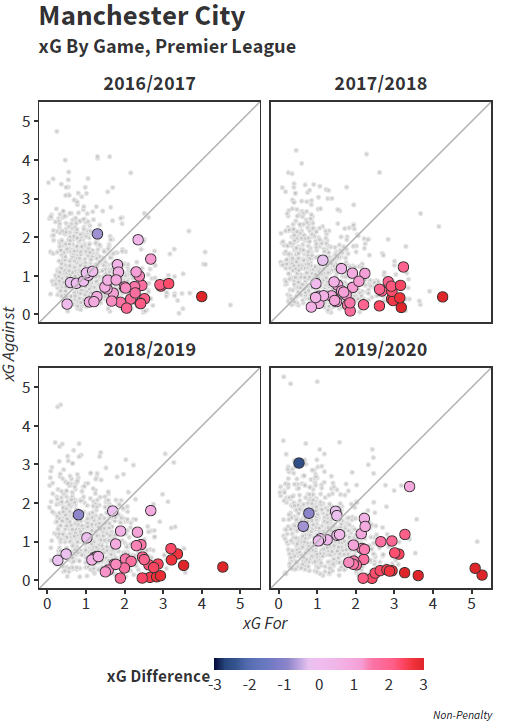 In the big picture, City's metrics were great; but then again they always are. But when we drill down to game by game (as the chart above shows) we can see that City's problem was as much aligned to the variation in their performance levels in games as anything else. Look at 2017-18: nearly no games with over one expected goals allowed and only one game in which their total was exceeded. 2018-19 was pretty good too but with a smattering of games in which the defence looked more vulnerable. 2019-20 has a weird mix of high xG for/low xG against games and a bunch of matches in which the team is either outperformed, gives up a lot in defence or it's pretty close. Bottom line, there was less consistency and that's partly how they contrived to lose nine games having only lost twelve combined in the previous three seasons. The dichotomy between both shot quantity and shot quality at both ends of the pitch was fairly remarkable too. As ever City took a lot of shots. Their 19.5 per game was higher than any of their previous seasons and evoked Carlo Ancelotti's 2009-10 Chelsea team, which was the last Premier League team to get anywhere near this kind of volume. They were good shots too, with the xG per shot value of close to 0.12 only a rizla-width behind that of Arsenal's own 0.12. Loads of shots of very good quality equals loads of goals, 102 in fact, which tied their 2013-14 total and was only four goals behind that of 2017-18. As ever, all their attackers had decent contributory seasons, and eight different players played more than 900 minutes and contributed between 0.49 and 0.98 goals (or assists) per 90 minutes. It's daft really. The varying outcomes and lack of Champions League success will mean that it may take time to really reflect adequately on what Guardiola created in this team, but the attacking unit remains utterly stellar. But the defence. The defence. Seven shots against was up from six in the previous two seasons. Such volume remains are ludicrously good and again speaks of good process. However, the value of these shots was league high at 0.12, significantly up from all of Guardiola's three previous seasons and essentially the same value as the shots they were taking. So Manchester City, one of the best attacking teams in world football, gave up the same shot quality as they take themselves. That's a problem. Throughball vulnerability was a part of this. Across 2017-18 and 2018-19 City gave up 21 shots from throughballs and three goals. In 2019-20 alone they allowed the same volume of shots against (21) but this time gave up seven goals. This kind of vulnerability is a frequent weak spot for pressing teams, and it is to City's credit that they managed to resolve a weakness here after Guardiola's first season.. 2019-20 was not successful here though, and Kyle Walker and Ederson apart, the whole backline has felt erratically assembled for a while. The obvious switch at the back was that (then) 34 year old defensive midfielder Fernandinho was now a starting centre back, and with Aymeric Laporte out, the rotation grew more frequent. A stalwart back in 2017-18, Nicolas Otamendi has become a player who is in and out of the team while John Stones appeared to fall right down the pecking order with Eric Garcia ending the season with a bunch of starts. Stones' demise is curious but possibly not undeserved. An experimental metric I calculated to establish how frequently defenders were actively clearing their defensive zones versus the amount of successful plays their opponents were making saw him rank dead last of all centre backs in the league, and by some margin. As the new man in midfield, Rodri was eyed as a potential culprit towards this new found defensive instability, with ideas that he had yet to perfect the dark arts of Fernandinho, but this was pretty speculative. On top of this City once more conceded some very stupid goals, twice seeing Ederson bypassed from 40 yards or so, from Che Adams and Scott McTominay respectively. Mo Salah did the same a couple of years back and they're such horrible goals to give up, one would think that there were tweaks that could be added to the philosophy just to avert this. Personnel For a club that has spent widely, and acquired Raheem Sterling and Kevin De Bruyne in one summer window back in 2015 there's a nagging feeling that in recent seasons City haven't quite nailed their transfers. Admittedly, when a team generally performs as well as this one has across Guardiola's reign, it's tricky to purchase players that intrinsically improve the starting eleven. Case in point being Riyad Mahrez who was the one main signing in the summer of 2018. He has been a top tier contributor to goals when on the pitch in both his seasons at the club but is no guaranteed starter. He would likely start every week for any other club in the league (Liverpool could squeeze him and Mo Salah in somehow) and in 2019-20 was extremely effective and slightly unsung as De Bruyne in particular rightly took the plaudits:
In the big picture, City's metrics were great; but then again they always are. But when we drill down to game by game (as the chart above shows) we can see that City's problem was as much aligned to the variation in their performance levels in games as anything else. Look at 2017-18: nearly no games with over one expected goals allowed and only one game in which their total was exceeded. 2018-19 was pretty good too but with a smattering of games in which the defence looked more vulnerable. 2019-20 has a weird mix of high xG for/low xG against games and a bunch of matches in which the team is either outperformed, gives up a lot in defence or it's pretty close. Bottom line, there was less consistency and that's partly how they contrived to lose nine games having only lost twelve combined in the previous three seasons. The dichotomy between both shot quantity and shot quality at both ends of the pitch was fairly remarkable too. As ever City took a lot of shots. Their 19.5 per game was higher than any of their previous seasons and evoked Carlo Ancelotti's 2009-10 Chelsea team, which was the last Premier League team to get anywhere near this kind of volume. They were good shots too, with the xG per shot value of close to 0.12 only a rizla-width behind that of Arsenal's own 0.12. Loads of shots of very good quality equals loads of goals, 102 in fact, which tied their 2013-14 total and was only four goals behind that of 2017-18. As ever, all their attackers had decent contributory seasons, and eight different players played more than 900 minutes and contributed between 0.49 and 0.98 goals (or assists) per 90 minutes. It's daft really. The varying outcomes and lack of Champions League success will mean that it may take time to really reflect adequately on what Guardiola created in this team, but the attacking unit remains utterly stellar. But the defence. The defence. Seven shots against was up from six in the previous two seasons. Such volume remains are ludicrously good and again speaks of good process. However, the value of these shots was league high at 0.12, significantly up from all of Guardiola's three previous seasons and essentially the same value as the shots they were taking. So Manchester City, one of the best attacking teams in world football, gave up the same shot quality as they take themselves. That's a problem. Throughball vulnerability was a part of this. Across 2017-18 and 2018-19 City gave up 21 shots from throughballs and three goals. In 2019-20 alone they allowed the same volume of shots against (21) but this time gave up seven goals. This kind of vulnerability is a frequent weak spot for pressing teams, and it is to City's credit that they managed to resolve a weakness here after Guardiola's first season.. 2019-20 was not successful here though, and Kyle Walker and Ederson apart, the whole backline has felt erratically assembled for a while. The obvious switch at the back was that (then) 34 year old defensive midfielder Fernandinho was now a starting centre back, and with Aymeric Laporte out, the rotation grew more frequent. A stalwart back in 2017-18, Nicolas Otamendi has become a player who is in and out of the team while John Stones appeared to fall right down the pecking order with Eric Garcia ending the season with a bunch of starts. Stones' demise is curious but possibly not undeserved. An experimental metric I calculated to establish how frequently defenders were actively clearing their defensive zones versus the amount of successful plays their opponents were making saw him rank dead last of all centre backs in the league, and by some margin. As the new man in midfield, Rodri was eyed as a potential culprit towards this new found defensive instability, with ideas that he had yet to perfect the dark arts of Fernandinho, but this was pretty speculative. On top of this City once more conceded some very stupid goals, twice seeing Ederson bypassed from 40 yards or so, from Che Adams and Scott McTominay respectively. Mo Salah did the same a couple of years back and they're such horrible goals to give up, one would think that there were tweaks that could be added to the philosophy just to avert this. Personnel For a club that has spent widely, and acquired Raheem Sterling and Kevin De Bruyne in one summer window back in 2015 there's a nagging feeling that in recent seasons City haven't quite nailed their transfers. Admittedly, when a team generally performs as well as this one has across Guardiola's reign, it's tricky to purchase players that intrinsically improve the starting eleven. Case in point being Riyad Mahrez who was the one main signing in the summer of 2018. He has been a top tier contributor to goals when on the pitch in both his seasons at the club but is no guaranteed starter. He would likely start every week for any other club in the league (Liverpool could squeeze him and Mo Salah in somehow) and in 2019-20 was extremely effective and slightly unsung as De Bruyne in particular rightly took the plaudits: 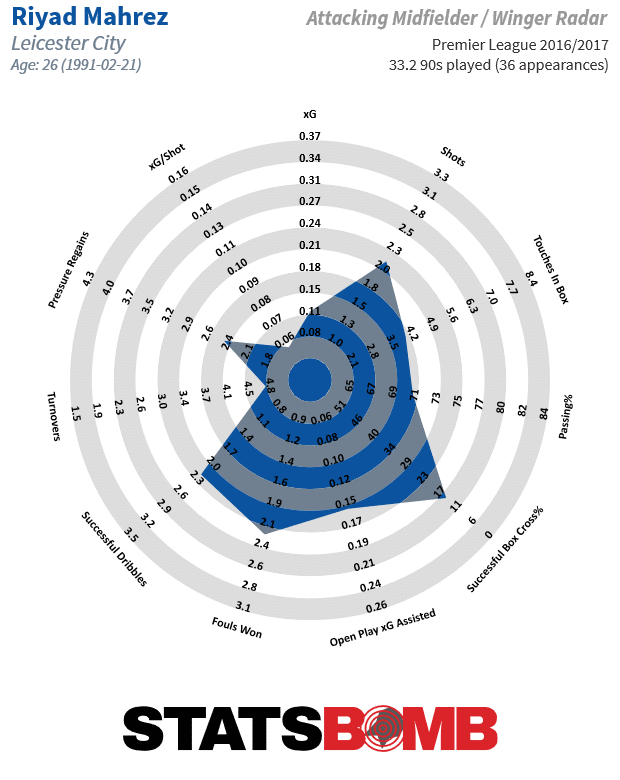 So far this summer in the transfer market, there has been a move to shore up defence with a novel idea: "buy a relegated centre back". Arriving for around £40m, Nathan Aké has long appeared the type of player that could move to a higher level than Bournemouth, not least because he is so comfortable on the ball. As a left footed centre back on the cusp of his peak years, he was a relatively scarce commodity and does actually scope out as a fairly capable defending defender on top of passing reliability. It's hard to see him as a direct upgrade who will slot instantly into City's first eleven, but no doubt he will get minutes, and ease the pressure Laporte had to shoulder as the one natural left sided centre back. There is talk of Kalidou Koulibaly arriving, but at this stage gossip around him is as reliable to the transfer window as Santa Claus is to Christmas, so it's hard to be confident here. If the past was represented by the sad sight of Leroy Sané returning to his homeland, the future is now here in the form of 20 year old Ferran Torres, who arrived from Valencia. His former team struggled extensively in 2019-20, and it had an impact on the numerical impact of much of their squad. As such we have a tricky chicken vs egg problem when evaluating him just from numbers; as we well know, the video is required too:
So far this summer in the transfer market, there has been a move to shore up defence with a novel idea: "buy a relegated centre back". Arriving for around £40m, Nathan Aké has long appeared the type of player that could move to a higher level than Bournemouth, not least because he is so comfortable on the ball. As a left footed centre back on the cusp of his peak years, he was a relatively scarce commodity and does actually scope out as a fairly capable defending defender on top of passing reliability. It's hard to see him as a direct upgrade who will slot instantly into City's first eleven, but no doubt he will get minutes, and ease the pressure Laporte had to shoulder as the one natural left sided centre back. There is talk of Kalidou Koulibaly arriving, but at this stage gossip around him is as reliable to the transfer window as Santa Claus is to Christmas, so it's hard to be confident here. If the past was represented by the sad sight of Leroy Sané returning to his homeland, the future is now here in the form of 20 year old Ferran Torres, who arrived from Valencia. His former team struggled extensively in 2019-20, and it had an impact on the numerical impact of much of their squad. As such we have a tricky chicken vs egg problem when evaluating him just from numbers; as we well know, the video is required too: 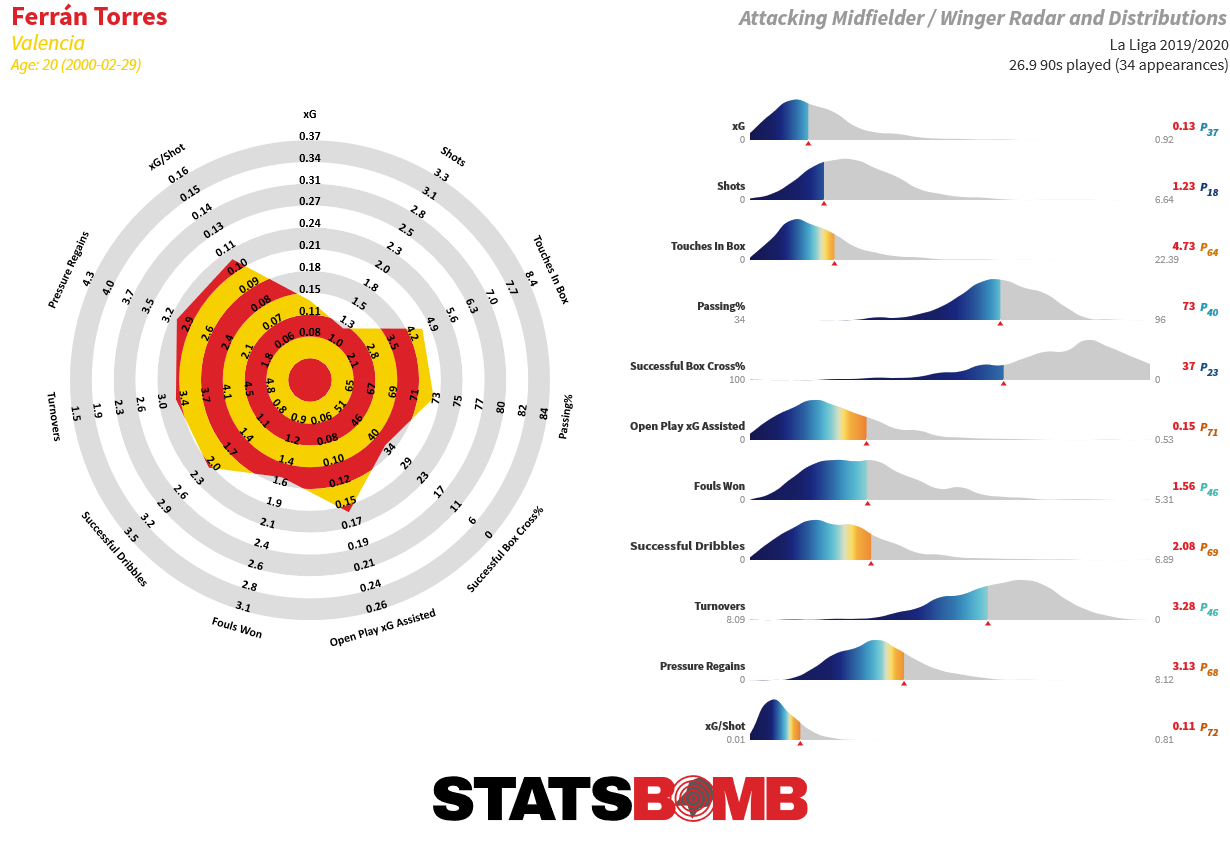 The vast majority of Torres' career has been spent playing off the right side, and how he fits into this team is hard to answer. Raheem Sterling plays off the left, so not there, while the lefties Mahrez and Bernardo Silva tend to operate off the right and Phil Foden is the breakthrough talent already in the squad and covering both these positions. Foden's development really should not be stymied and in particular he shows up extremely well for finding space in the final third. There is likely a positive skew that was assisted by playing often in the post restart fixtures, which were played at a noticeably kinder pace than what came before, but Foden's final third ball receipts were considered "under pressure" on only 6% of his receipts, the lowest in the league by a good margin:
The vast majority of Torres' career has been spent playing off the right side, and how he fits into this team is hard to answer. Raheem Sterling plays off the left, so not there, while the lefties Mahrez and Bernardo Silva tend to operate off the right and Phil Foden is the breakthrough talent already in the squad and covering both these positions. Foden's development really should not be stymied and in particular he shows up extremely well for finding space in the final third. There is likely a positive skew that was assisted by playing often in the post restart fixtures, which were played at a noticeably kinder pace than what came before, but Foden's final third ball receipts were considered "under pressure" on only 6% of his receipts, the lowest in the league by a good margin: 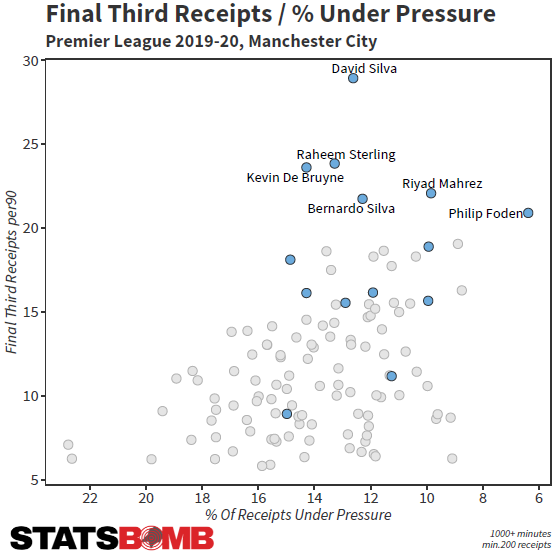 What that chart highlights too is the real hole that has opened up in this squad this summer: the departure of club legend David Silva. Again his presence in midfield last season at 34 years old poses questions about how readily opponents could get through City, but undoubtedly, his on the ball influence was far from dimmed. A rock solid contributor to Guardiola's possession game, and an utterly reliable secondary creator for the team behind De Bruyne, he was still good for 22 league starts last season. Who replaces him? The squad is deep enough to take the hit, but it's not as if a clear answer is wildly evident. Early season we may see some more Guardiola flexibility in selection, this time in midfield rather than just defence. Projection 78, 100, 98, 81 divided by 4 equals 89.25. That's Guardiola's four Manchester City seasons. Sporting Index opened up at 88.5-90 which the eagle eyed amongst you will notice has a midpoint of 89.25. The metrics are still there for this team. They won 26 games last season, and for various reasons ended up towards the bottom end of any realistic point expectation. That doesn't necessarily mean they are primed to overhaul Liverpool who have managed to be consistent as well as dominant in the last two seasons, much as City did before and alongside them in 2017-18 and 2018-19, but they do have the tools. City need to reclaim consistency and perhaps with a crazy schedule for all, Guardiola may be wise to flip the off switch more often when his team are coasting and games are won. Enough of the metrics that undermined City in 2019-20 land in the high variance category, and the functional control this team can still exert over the vast majority of their opponents will surely see them go very deep into the season and contend. Would I bet on them to win it? I don't think so. That's not to say they can't, they are betting favourites with good reason but City have been the metric darlings of nearly every season in the last decade, yet they've won just four titles. You need to be both very good and have things also go your way to win this league. If Guardiola is to leave though, he'll no doubt want to go out on a high.
What that chart highlights too is the real hole that has opened up in this squad this summer: the departure of club legend David Silva. Again his presence in midfield last season at 34 years old poses questions about how readily opponents could get through City, but undoubtedly, his on the ball influence was far from dimmed. A rock solid contributor to Guardiola's possession game, and an utterly reliable secondary creator for the team behind De Bruyne, he was still good for 22 league starts last season. Who replaces him? The squad is deep enough to take the hit, but it's not as if a clear answer is wildly evident. Early season we may see some more Guardiola flexibility in selection, this time in midfield rather than just defence. Projection 78, 100, 98, 81 divided by 4 equals 89.25. That's Guardiola's four Manchester City seasons. Sporting Index opened up at 88.5-90 which the eagle eyed amongst you will notice has a midpoint of 89.25. The metrics are still there for this team. They won 26 games last season, and for various reasons ended up towards the bottom end of any realistic point expectation. That doesn't necessarily mean they are primed to overhaul Liverpool who have managed to be consistent as well as dominant in the last two seasons, much as City did before and alongside them in 2017-18 and 2018-19, but they do have the tools. City need to reclaim consistency and perhaps with a crazy schedule for all, Guardiola may be wise to flip the off switch more often when his team are coasting and games are won. Enough of the metrics that undermined City in 2019-20 land in the high variance category, and the functional control this team can still exert over the vast majority of their opponents will surely see them go very deep into the season and contend. Would I bet on them to win it? I don't think so. That's not to say they can't, they are betting favourites with good reason but City have been the metric darlings of nearly every season in the last decade, yet they've won just four titles. You need to be both very good and have things also go your way to win this league. If Guardiola is to leave though, he'll no doubt want to go out on a high.
If you're a club, media or gambling entity and want to know more about what StatsBomb can do for you, please contact us at Sales@StatsBomb.com We also provide education in this area, so if this taste of football analytics sparked interest, check out our Introduction to Football Analytics course Follow us on twitter in English and Spanish and also on LinkedIn
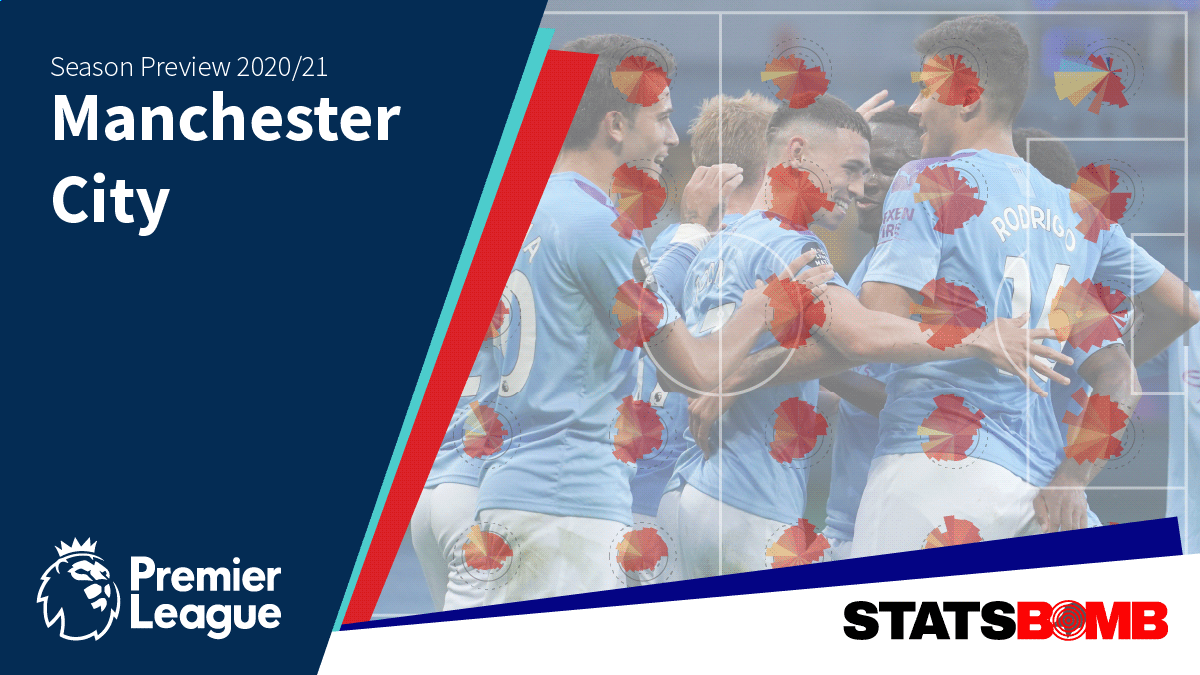
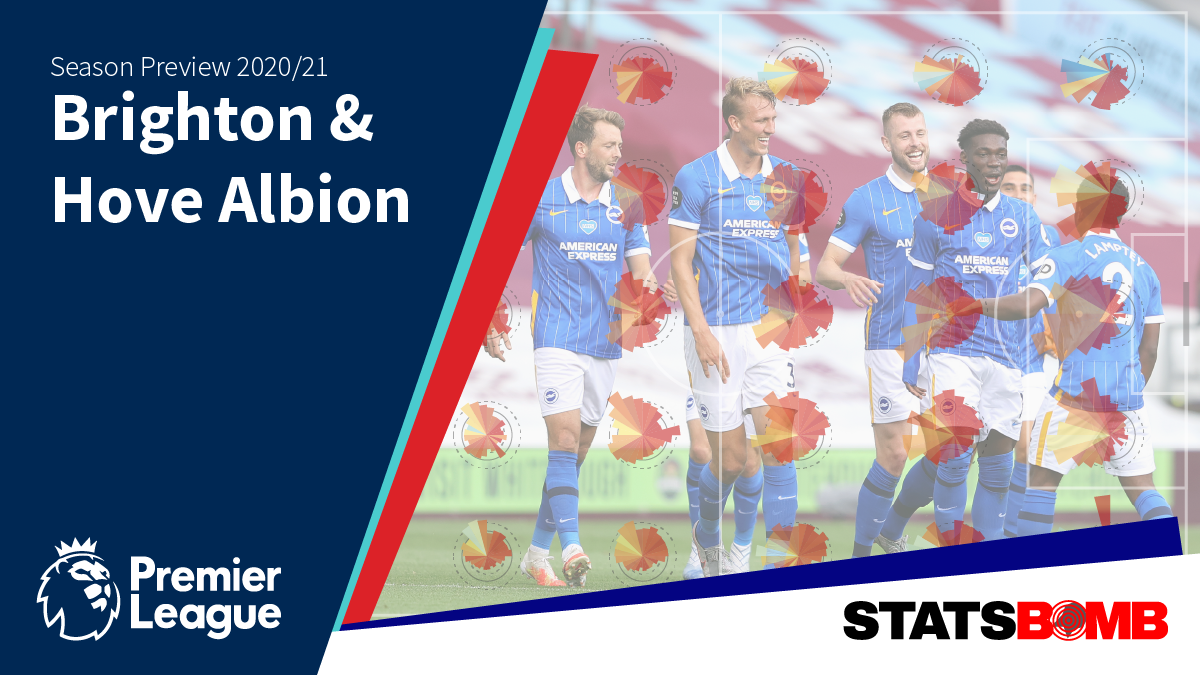
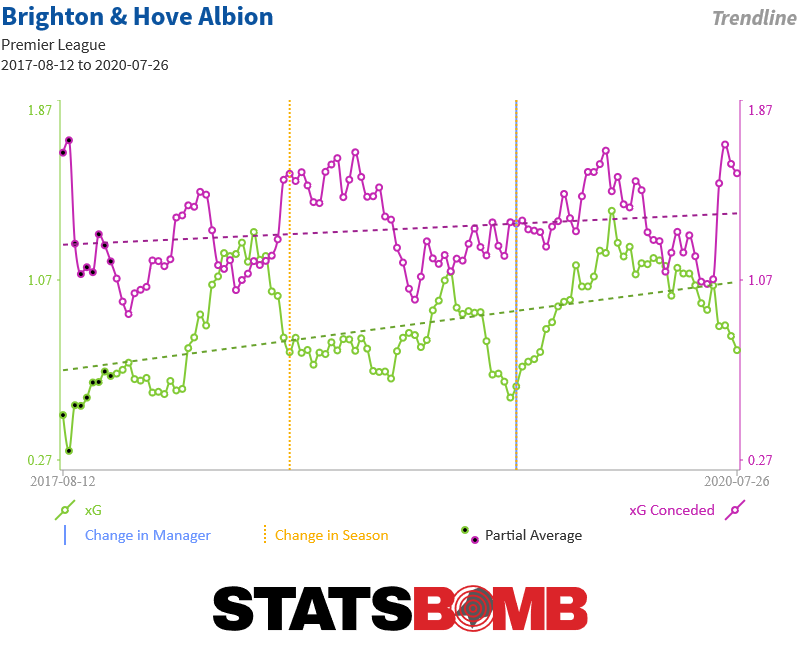 The broader picture is better. In raw terms Brighton’s per game xG differential worsened from -0.43 in 2017-18 to -0.50 in 2018-19 and at the point of safety in 2019-20 was improved at -0.24. There’s enough in that to suggest that Potter’s vstyle has had some effect, and we can see how the line between expected values for and against closed as the season progressed. It’s still far from stellar but it’s enough to feel Potter’s second season is deserved. He has made a small trade off in defence to give the team something to work with in attack, and when we consider that Hughton’s attack was close to league worst, we can understand the purpose here. Hughton's focus on defending was certainly reactive; witness the position of his sides in this table of blocked shots from teams in recent seasons:
The broader picture is better. In raw terms Brighton’s per game xG differential worsened from -0.43 in 2017-18 to -0.50 in 2018-19 and at the point of safety in 2019-20 was improved at -0.24. There’s enough in that to suggest that Potter’s vstyle has had some effect, and we can see how the line between expected values for and against closed as the season progressed. It’s still far from stellar but it’s enough to feel Potter’s second season is deserved. He has made a small trade off in defence to give the team something to work with in attack, and when we consider that Hughton’s attack was close to league worst, we can understand the purpose here. Hughton's focus on defending was certainly reactive; witness the position of his sides in this table of blocked shots from teams in recent seasons: 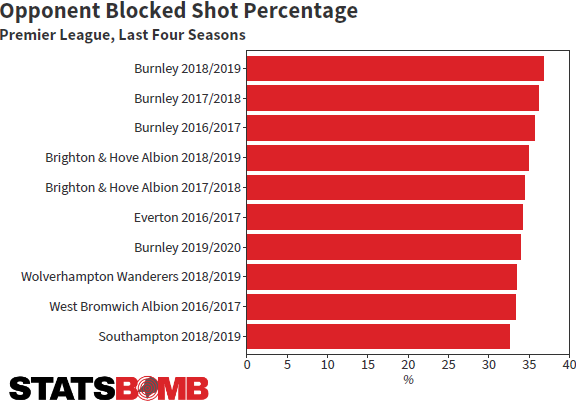 ...and see how Brighton's passes per defensive action has evolved away from a complete bunker under Hughton towards something more balanced under Potter:
...and see how Brighton's passes per defensive action has evolved away from a complete bunker under Hughton towards something more balanced under Potter: 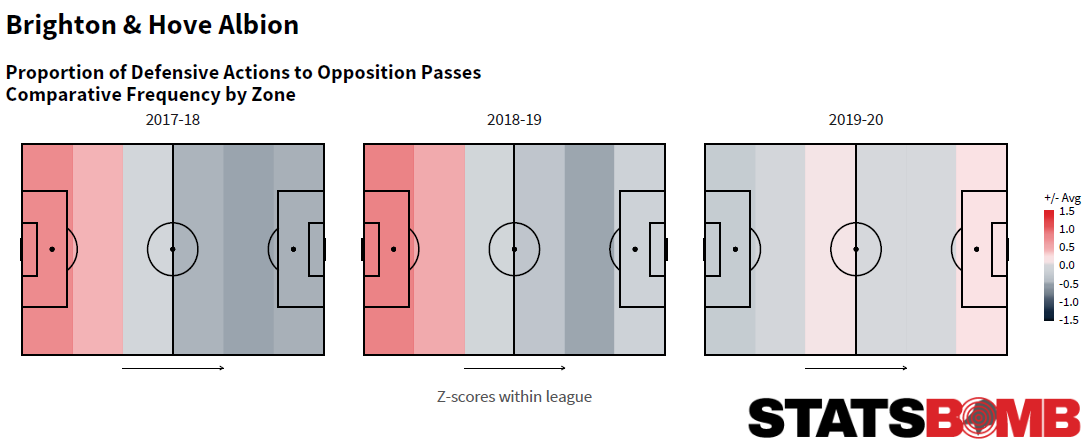 For personnel, the transition from the first season in the league to the second was stark. Lots of relatively low priced players arrived from a wide variety of leagues in year one--and few made the team with any regularity. It was easy to wonder if Hughton, detached from recruitment, was interested in playing the players he rated rather than new signings, but Potter has followed a similar thread, and few of that first tranche, Dan Burn, Yves Bissoma and Martin Montoya apart featured heavily in 2019-20. Potter’s first summer saw more targeted signings and less variety with all but Leandro Trossard arriving from within the English game. Adam Webster, Neal Maupay and Trossard all featured heavily and validated their purchases while Aaron Mooy eventually converted from a loan and Tariq Lamptey was a neat January pickup who quickly featured. Brighton have moved quickly again this summer adding distinct quality--with a sideline of injury concern and post-peak aging--in Adam Lallana. With Mooy heading for Shanghai, it appears reasonable to assume that Lallana will effectively take his place in the squad and overall this summer feels more like squad evolution than revolution. Joël Veltman arrived from Ajax for a tiny fee and the bones of Wigan were examined to take young midfielder Jensen Weir. Veltman’s arrival, specifically, gave Brighton a wildly overstocked centre back department. Adam Webster and Lewis Dunk were the main starters last season with Shane Duffy as an alternative. Ben White spent the season starring on loan at Leeds, while Matt Clarke similarly had a great time on loan at Derby. Dan Burn converted into a left back to get game time, but negotiating this corps ahead of the new season is not easy, with all mentioned likely worthy of playing regular football at a level near to that which Brighton require. White finally signed a new contract recently while Clarke returned to Derby on loan and Duffy headed across the border to Celtic, but there's still a surplus here. Either another move is imminent or someone's going to miss out on substantial minutes. Overall though it feels like there's a degree of continuity being sought. Investments in players of the right age to progress in the long term have been made over time. A good example is Neal Maupay who followed up his 25-goal Brentford season with 10 in the Premier League. He scopes out at around a one in three striker here, which is closer to average than you may think, and adds further value from the volume of defensive work he does leading from the front. He's an interesting reference point for other strikers making the step up in leagues:
For personnel, the transition from the first season in the league to the second was stark. Lots of relatively low priced players arrived from a wide variety of leagues in year one--and few made the team with any regularity. It was easy to wonder if Hughton, detached from recruitment, was interested in playing the players he rated rather than new signings, but Potter has followed a similar thread, and few of that first tranche, Dan Burn, Yves Bissoma and Martin Montoya apart featured heavily in 2019-20. Potter’s first summer saw more targeted signings and less variety with all but Leandro Trossard arriving from within the English game. Adam Webster, Neal Maupay and Trossard all featured heavily and validated their purchases while Aaron Mooy eventually converted from a loan and Tariq Lamptey was a neat January pickup who quickly featured. Brighton have moved quickly again this summer adding distinct quality--with a sideline of injury concern and post-peak aging--in Adam Lallana. With Mooy heading for Shanghai, it appears reasonable to assume that Lallana will effectively take his place in the squad and overall this summer feels more like squad evolution than revolution. Joël Veltman arrived from Ajax for a tiny fee and the bones of Wigan were examined to take young midfielder Jensen Weir. Veltman’s arrival, specifically, gave Brighton a wildly overstocked centre back department. Adam Webster and Lewis Dunk were the main starters last season with Shane Duffy as an alternative. Ben White spent the season starring on loan at Leeds, while Matt Clarke similarly had a great time on loan at Derby. Dan Burn converted into a left back to get game time, but negotiating this corps ahead of the new season is not easy, with all mentioned likely worthy of playing regular football at a level near to that which Brighton require. White finally signed a new contract recently while Clarke returned to Derby on loan and Duffy headed across the border to Celtic, but there's still a surplus here. Either another move is imminent or someone's going to miss out on substantial minutes. Overall though it feels like there's a degree of continuity being sought. Investments in players of the right age to progress in the long term have been made over time. A good example is Neal Maupay who followed up his 25-goal Brentford season with 10 in the Premier League. He scopes out at around a one in three striker here, which is closer to average than you may think, and adds further value from the volume of defensive work he does leading from the front. He's an interesting reference point for other strikers making the step up in leagues: 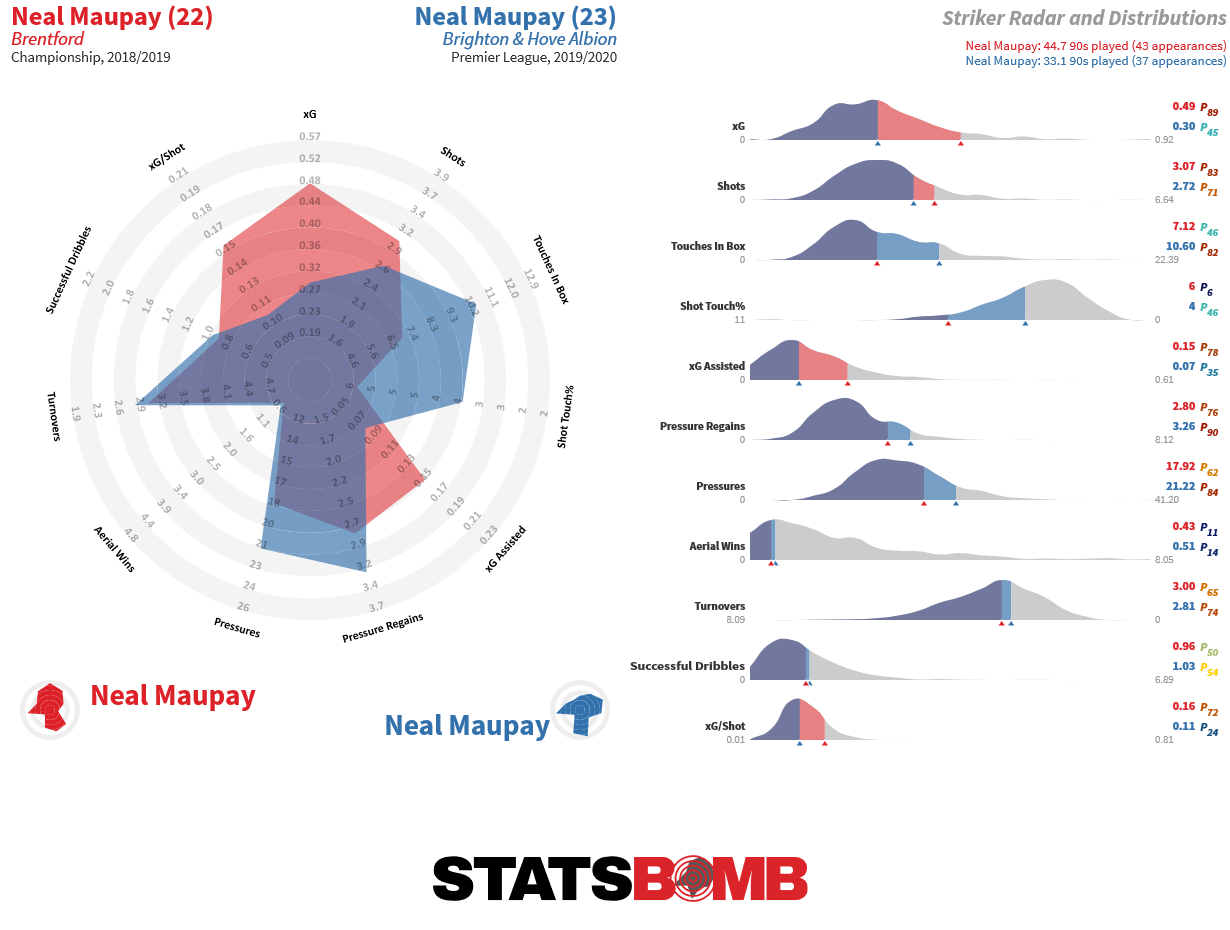 Projection Improved metrics under Potter have led to a projection of safety in the Sporting Index opening lines. They landed at around 42-43 points here which would represent a perfectly adequate return. However, one has to wonder what the long term plan is? It's still early days for Brighton in the Premier League, but projecting to low 40s still puts a team in the realm of risk for relegation. As such, it feels like from a performance evaluation perspective Potter may need to eke out further progress, if not this season then soon. His first season was entirely fine, and avoiding any relegation battle should be the target again, but Brighton aren't quite good enough yet to ease off the gas and naturally land mid-table security. In recent seasons, Bournemouth laid a useful blueprint for a smaller club playing a style that backed their on ball ability, but also their inability to adapt that over time eventually saw them vulnerable in a down year, and they paid the price. Brighton and Potter would do well to heed the lessons dealt out there.
Projection Improved metrics under Potter have led to a projection of safety in the Sporting Index opening lines. They landed at around 42-43 points here which would represent a perfectly adequate return. However, one has to wonder what the long term plan is? It's still early days for Brighton in the Premier League, but projecting to low 40s still puts a team in the realm of risk for relegation. As such, it feels like from a performance evaluation perspective Potter may need to eke out further progress, if not this season then soon. His first season was entirely fine, and avoiding any relegation battle should be the target again, but Brighton aren't quite good enough yet to ease off the gas and naturally land mid-table security. In recent seasons, Bournemouth laid a useful blueprint for a smaller club playing a style that backed their on ball ability, but also their inability to adapt that over time eventually saw them vulnerable in a down year, and they paid the price. Brighton and Potter would do well to heed the lessons dealt out there. 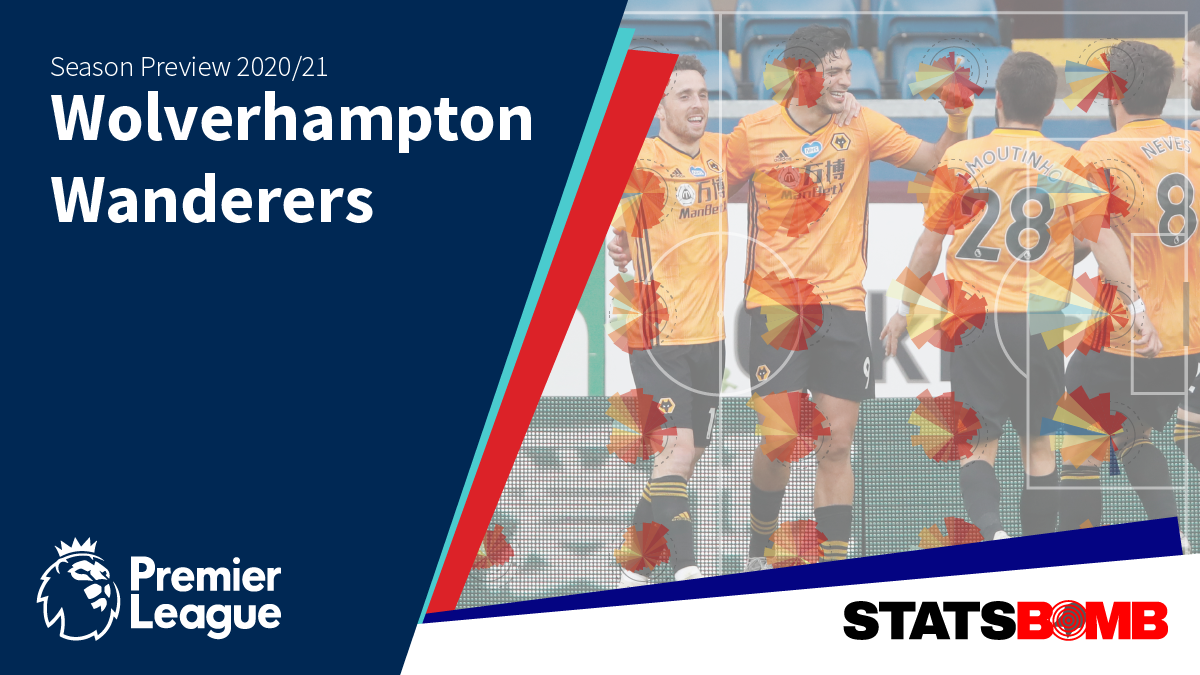
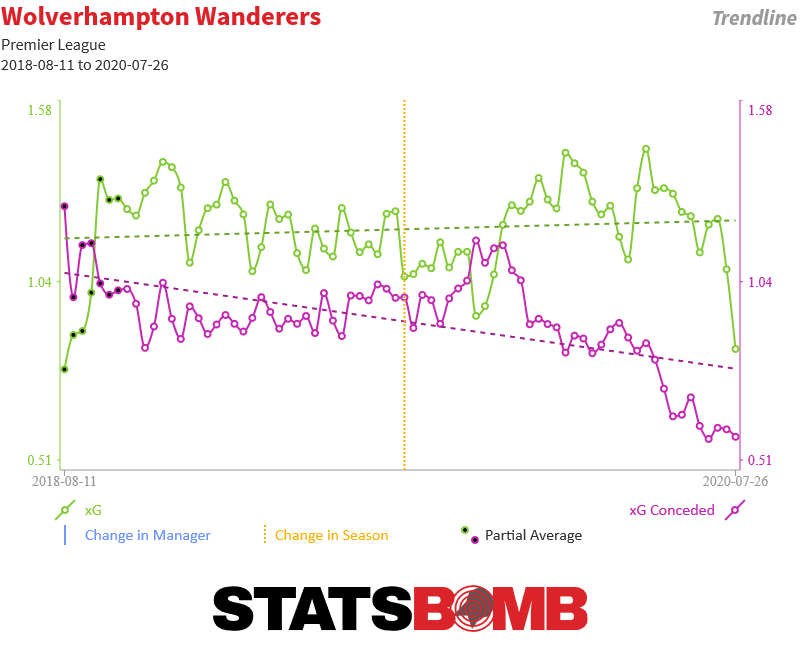 Belfast, Yerevan, Turin, Istanbul and Bratislava formed a Europa League tour for the club during a period in which they played as many non-league fixtures as league (eleven each). With a relatively small squad and a fairly consistent first team, it's actually to the team's credit that they got through that opening period of the Premier League without further decline. The big story in the chart above is the defence. In the back half of 2019-20 Wolves gave up under one non-penalty expected goal in a game fourteen times. In eight of those games they allowed under 0.5. Wolves post-lockdown defence was structurally the best in the league. Wolves have achieved this defensive stability by being one of the most clear-eyed tactical teams in the division, and a world away from the hard pressing espoused by other managers. That Nuno Espirito Santo is both Portuguese and a former goalkeeper for Jose Mourinho is highly indicative of Wolves style of play:
Belfast, Yerevan, Turin, Istanbul and Bratislava formed a Europa League tour for the club during a period in which they played as many non-league fixtures as league (eleven each). With a relatively small squad and a fairly consistent first team, it's actually to the team's credit that they got through that opening period of the Premier League without further decline. The big story in the chart above is the defence. In the back half of 2019-20 Wolves gave up under one non-penalty expected goal in a game fourteen times. In eight of those games they allowed under 0.5. Wolves post-lockdown defence was structurally the best in the league. Wolves have achieved this defensive stability by being one of the most clear-eyed tactical teams in the division, and a world away from the hard pressing espoused by other managers. That Nuno Espirito Santo is both Portuguese and a former goalkeeper for Jose Mourinho is highly indicative of Wolves style of play: 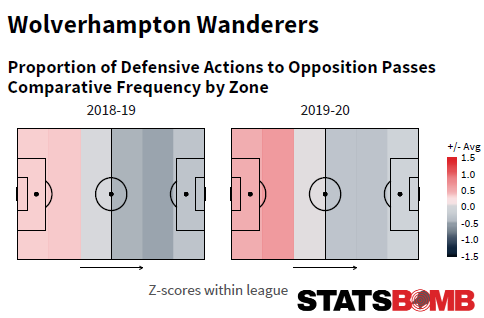 Nuno's set-ups are well established at this stage. Sixteen teams used three centre backs at some point last season [t's funny how these fashions pervade] yet only two of them set up with three centre backs in every game, Wolves and Sheffield United. The core of this team is well established too but will undergo some kind of remedial work going forward thanks to the absence of two key parts: the full backs. Stalwart Matt Doherty has joined Tottenham while Jonny has sustained a long term ACL injury and is likely to be unsighted for many months. In 2018-19, Wolves fielded 14 players for over 900 minutes in the league and in 2019-20 it was 13. They have operated with a very small consistent squad for two full seasons and are now obliged to adapt especially on the flanks. On the left Ruben Vinagre may have felt he was stepping out of the reserve slot he's held for two seasons but the signing of 31 year old Lyon rotational full back Marçal suggests his role may well persist for now. In the interests of sample size, this visualisation covers three seasons; he's experienced and was playing in the Champions League three weeks ago, but he will need to show robustness and reliability as being a Wolves full back is not a position for the underinvolved.
Nuno's set-ups are well established at this stage. Sixteen teams used three centre backs at some point last season [t's funny how these fashions pervade] yet only two of them set up with three centre backs in every game, Wolves and Sheffield United. The core of this team is well established too but will undergo some kind of remedial work going forward thanks to the absence of two key parts: the full backs. Stalwart Matt Doherty has joined Tottenham while Jonny has sustained a long term ACL injury and is likely to be unsighted for many months. In 2018-19, Wolves fielded 14 players for over 900 minutes in the league and in 2019-20 it was 13. They have operated with a very small consistent squad for two full seasons and are now obliged to adapt especially on the flanks. On the left Ruben Vinagre may have felt he was stepping out of the reserve slot he's held for two seasons but the signing of 31 year old Lyon rotational full back Marçal suggests his role may well persist for now. In the interests of sample size, this visualisation covers three seasons; he's experienced and was playing in the Champions League three weeks ago, but he will need to show robustness and reliability as being a Wolves full back is not a position for the underinvolved. 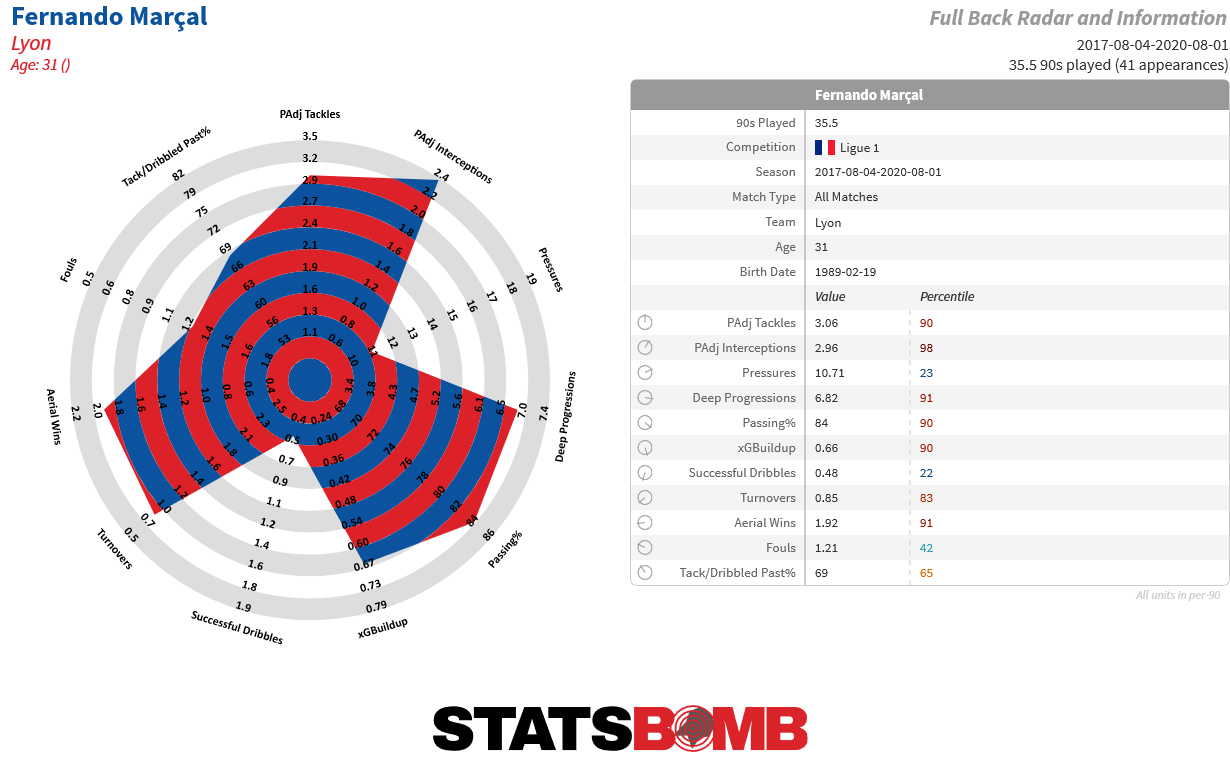 Never knowingly under-involved is Adama Traoré and the early word is that he may end up covering Doherty's role, at least to start the season. He's well capable of playing this position and anywhere else on the right flank and persists in being a unique and curious player. Last season saw a further rise to prominence outside niche stats fans fawning over his dribble volumes. Firstly, his four league goals were spread across three league games, Manchester City home and away and Tottenham. No better way to attract attention than scoring key goals in big games. However, more encouragingly, we saw further end production in his creative numbers. Nine assists was big-boy output and not wildly ahead of expectation. All in all for players with a decent volume of minutes (say 1500+) he was top ten in the league for open play key passes (1.6 per 90) and resulting xG Assisted (0.21 per 90). The reliability of how he made those goals was hugely positive. When you have a thing and you can keep doing your thing and nobody can stop you doing your thing, then you've really got something! But if it doesn't result in goals, your thing might not be that useful. Traoré's thing used to be facing up a defender and then killing them for strength and pace to make space for a further pass. However, the further pass wasn't necessarily a thing too. Now he's showing in the Premier League that goal creation is his thing. Beat a man on the flank and find an attacker in the box. For the defender it's nightmarish: they know what is coming but not if they can stop it. He's probably stronger than you and even if he isn't he sure looks like he is. Check out his very specific chance creation here, and how all his assists have a common thread:
Never knowingly under-involved is Adama Traoré and the early word is that he may end up covering Doherty's role, at least to start the season. He's well capable of playing this position and anywhere else on the right flank and persists in being a unique and curious player. Last season saw a further rise to prominence outside niche stats fans fawning over his dribble volumes. Firstly, his four league goals were spread across three league games, Manchester City home and away and Tottenham. No better way to attract attention than scoring key goals in big games. However, more encouragingly, we saw further end production in his creative numbers. Nine assists was big-boy output and not wildly ahead of expectation. All in all for players with a decent volume of minutes (say 1500+) he was top ten in the league for open play key passes (1.6 per 90) and resulting xG Assisted (0.21 per 90). The reliability of how he made those goals was hugely positive. When you have a thing and you can keep doing your thing and nobody can stop you doing your thing, then you've really got something! But if it doesn't result in goals, your thing might not be that useful. Traoré's thing used to be facing up a defender and then killing them for strength and pace to make space for a further pass. However, the further pass wasn't necessarily a thing too. Now he's showing in the Premier League that goal creation is his thing. Beat a man on the flank and find an attacker in the box. For the defender it's nightmarish: they know what is coming but not if they can stop it. He's probably stronger than you and even if he isn't he sure looks like he is. Check out his very specific chance creation here, and how all his assists have a common thread: 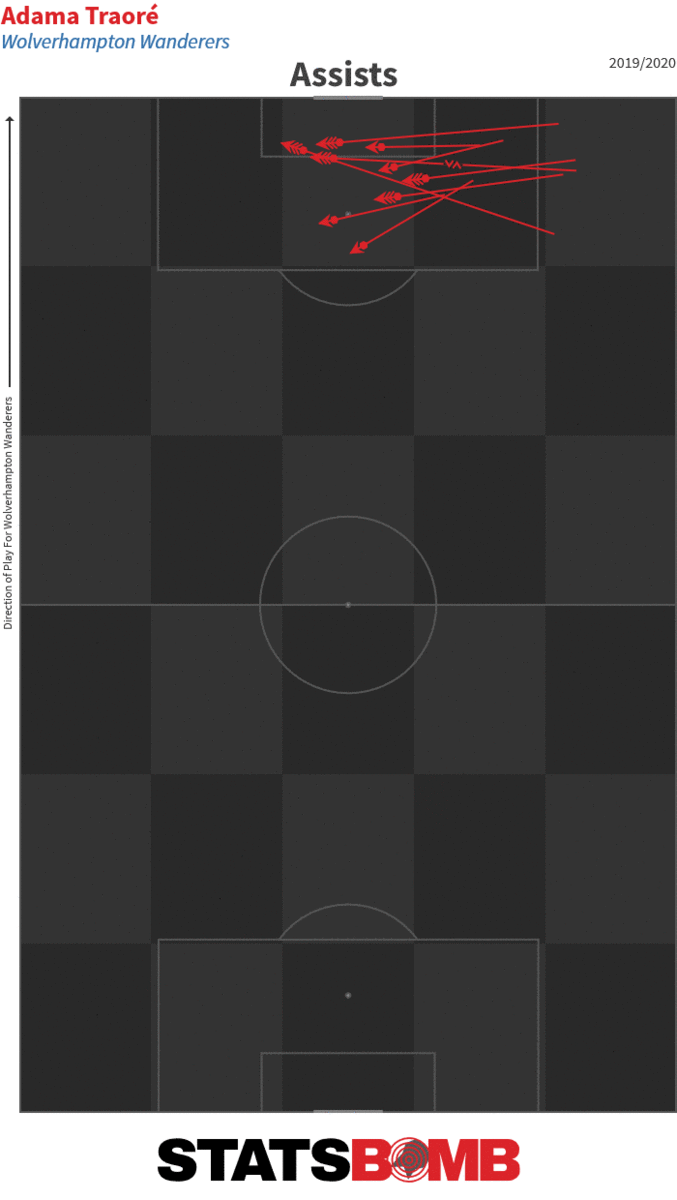 Part of the Wolves oeuvre is ball carrying at pace. It's not just Traoré either. Some experimental numbers I generated for speed with directness of ball carrying saw Diogo Jota rank fastest in the league, with Raúl Jiménez ranking fairly high too. Ironically, Traoré ranked a way back for this specific measure, which was likely a function of his tendency to stand up to the defender and essentially stalling before moving, but he ranked top in the league for average distance per carry into or inside the final third, with Jota third. Wolves as a whole attempt more actual dribbles (~take-ons) than any other team in the league, and carry the ball for longer distances everywhere high up the pitch right up into the box. This is a team that relies strongly on attackers that can transition through zones with the ball at their feet, as we can see when we look at longer carries for those three players:
Part of the Wolves oeuvre is ball carrying at pace. It's not just Traoré either. Some experimental numbers I generated for speed with directness of ball carrying saw Diogo Jota rank fastest in the league, with Raúl Jiménez ranking fairly high too. Ironically, Traoré ranked a way back for this specific measure, which was likely a function of his tendency to stand up to the defender and essentially stalling before moving, but he ranked top in the league for average distance per carry into or inside the final third, with Jota third. Wolves as a whole attempt more actual dribbles (~take-ons) than any other team in the league, and carry the ball for longer distances everywhere high up the pitch right up into the box. This is a team that relies strongly on attackers that can transition through zones with the ball at their feet, as we can see when we look at longer carries for those three players: 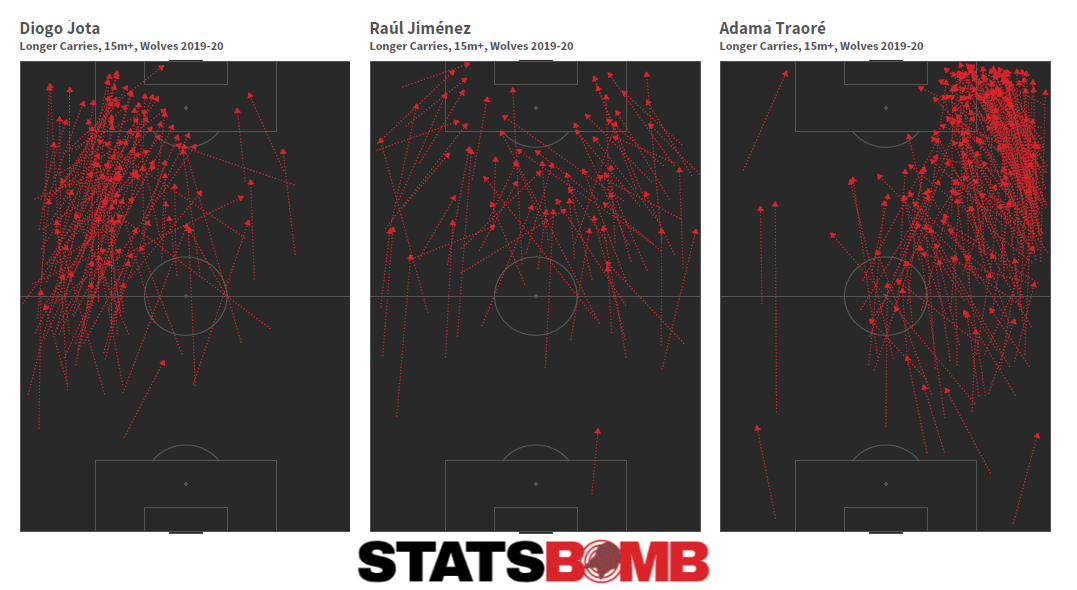 Elsewhere it's intriguing to know whether the club has secured the future of the Portuguese national team in Vitinha and Fábio Silva or attached around £60m to pure potential that will not pay off for some seasons. Each significantly lacks experience of good quality men's level football and thus eludes anything but the most scant review in data. Vitinha at 20 years old has played over 1000 minutes in the Portuguese second tier and grabbed fleeting substitute minutes in the second half of Porto's season, while Silva at just 18 years old had a similar profile in Porto's first team with time on the pitch minimal and mainly via the bench. The impact each can make is difficult to know, and it seems hard to envisage that either will quickly shift the established first teamers out, but they do bring much needed depth to the squad in general and it will be hoped that they can settle and contribute quickly. Projection In a compressed season with very little room for recovery, Wolves will probably reflect that a lack of European football is a real boost to their Premier League chances. Pre-season points projections concur with their seventh placed finishes and expect another season in the nominal "best of the rest" slot. Nuno's style has kept Wolves hard to beat, but there were almost as many draws as wins last season and a shade more attacking power might be the recipe for really pointing upwards and shaking up the top six mix. With a smaller squad and specific and key contributors, injury luck will always have an impact. With that, Wolves are as reliable as they come, and the range of outcomes for this team is likely a lot smaller than that of certain others eyeing similar positions in the table such as Leicester, Tottenham, Arsenal or Everton. It's a good time to be a Wolves fan, and should continue to be so.
Elsewhere it's intriguing to know whether the club has secured the future of the Portuguese national team in Vitinha and Fábio Silva or attached around £60m to pure potential that will not pay off for some seasons. Each significantly lacks experience of good quality men's level football and thus eludes anything but the most scant review in data. Vitinha at 20 years old has played over 1000 minutes in the Portuguese second tier and grabbed fleeting substitute minutes in the second half of Porto's season, while Silva at just 18 years old had a similar profile in Porto's first team with time on the pitch minimal and mainly via the bench. The impact each can make is difficult to know, and it seems hard to envisage that either will quickly shift the established first teamers out, but they do bring much needed depth to the squad in general and it will be hoped that they can settle and contribute quickly. Projection In a compressed season with very little room for recovery, Wolves will probably reflect that a lack of European football is a real boost to their Premier League chances. Pre-season points projections concur with their seventh placed finishes and expect another season in the nominal "best of the rest" slot. Nuno's style has kept Wolves hard to beat, but there were almost as many draws as wins last season and a shade more attacking power might be the recipe for really pointing upwards and shaking up the top six mix. With a smaller squad and specific and key contributors, injury luck will always have an impact. With that, Wolves are as reliable as they come, and the range of outcomes for this team is likely a lot smaller than that of certain others eyeing similar positions in the table such as Leicester, Tottenham, Arsenal or Everton. It's a good time to be a Wolves fan, and should continue to be so. 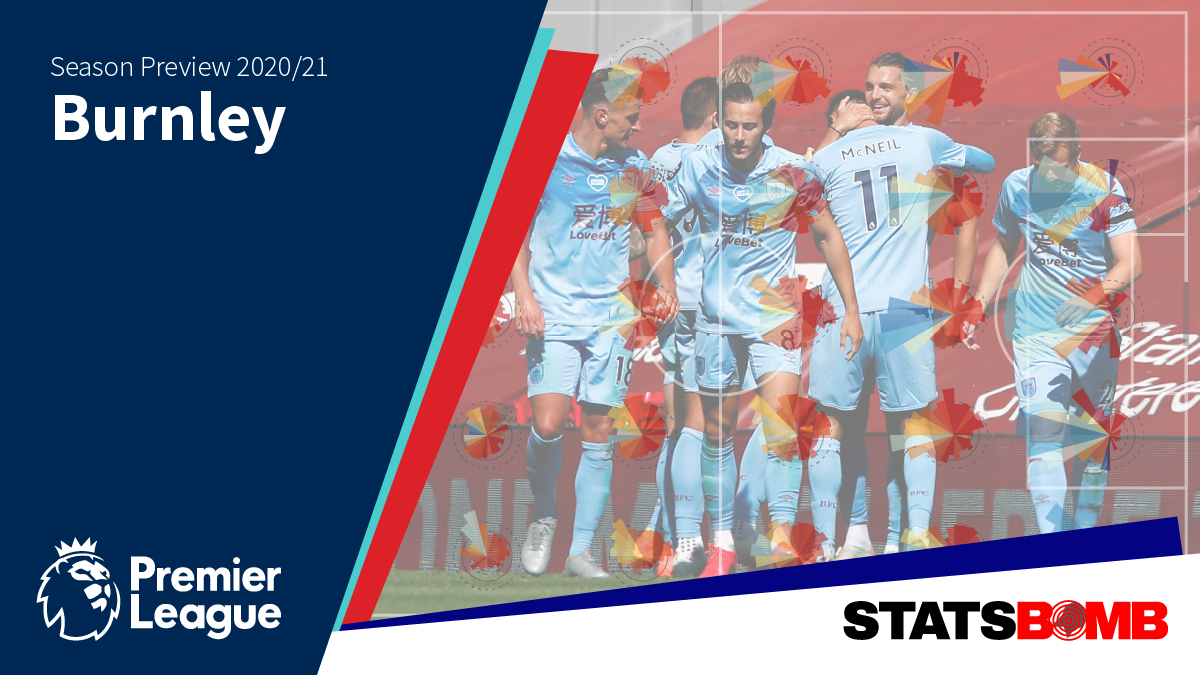
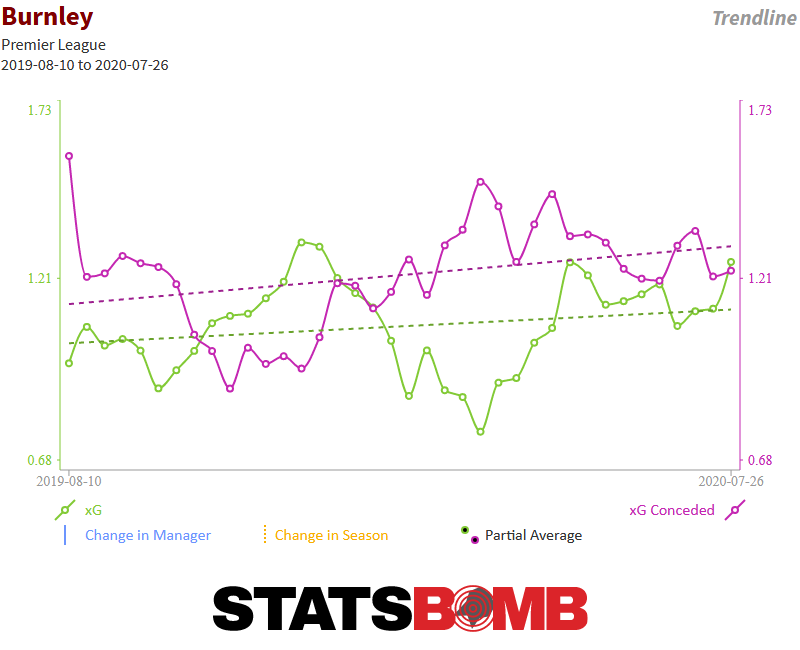
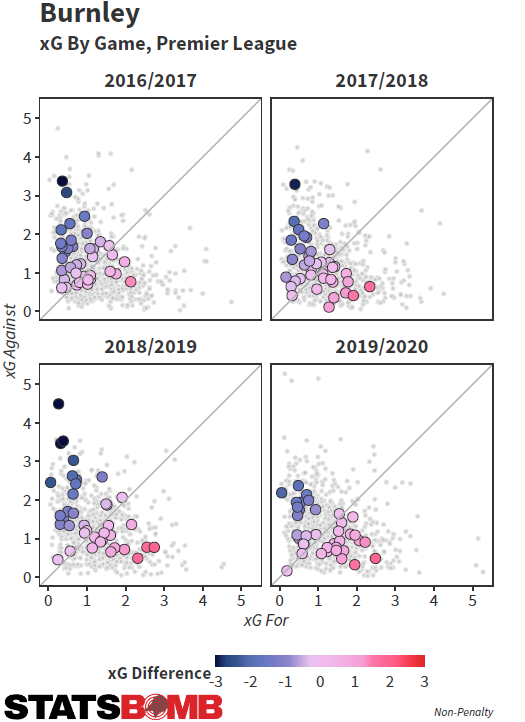
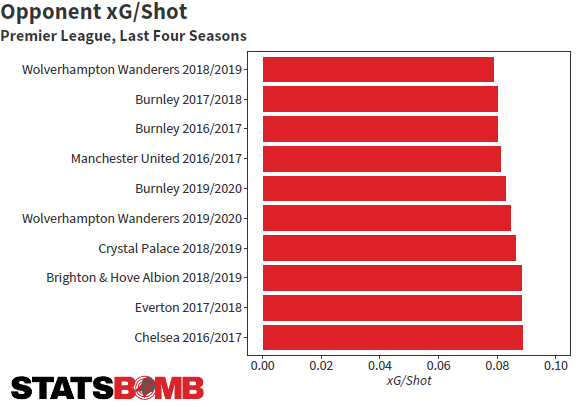
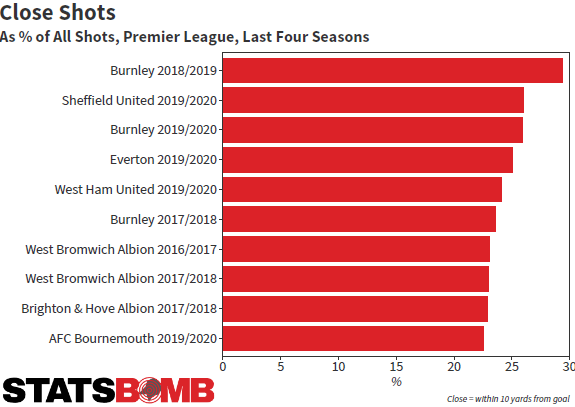
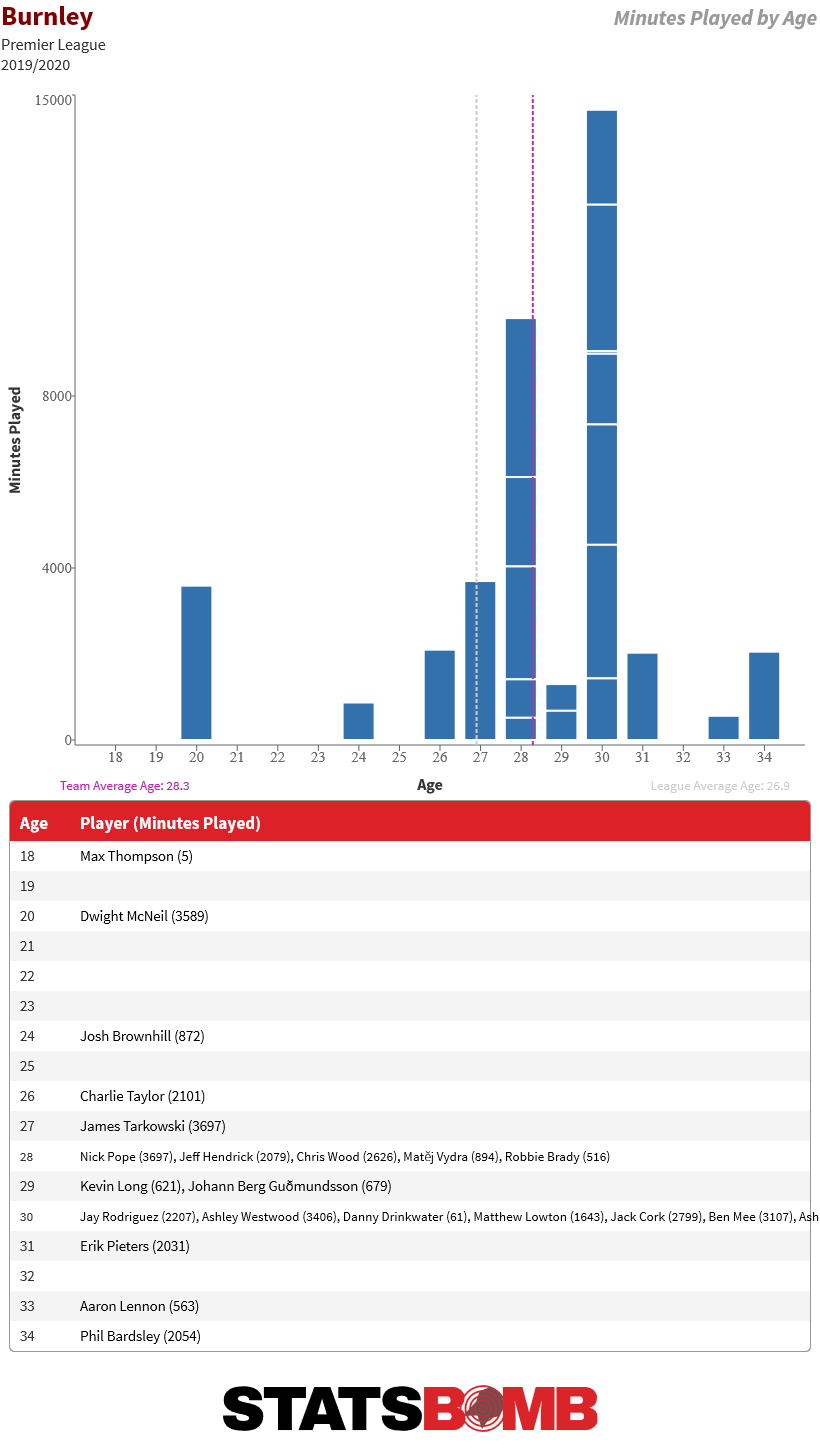
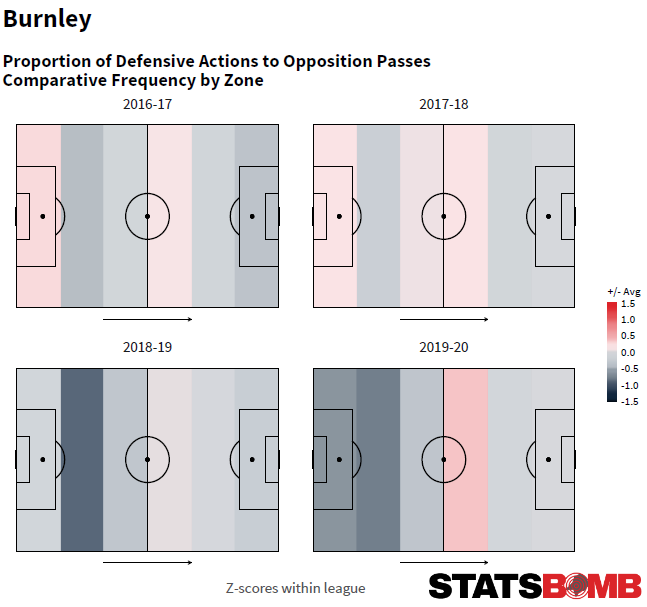
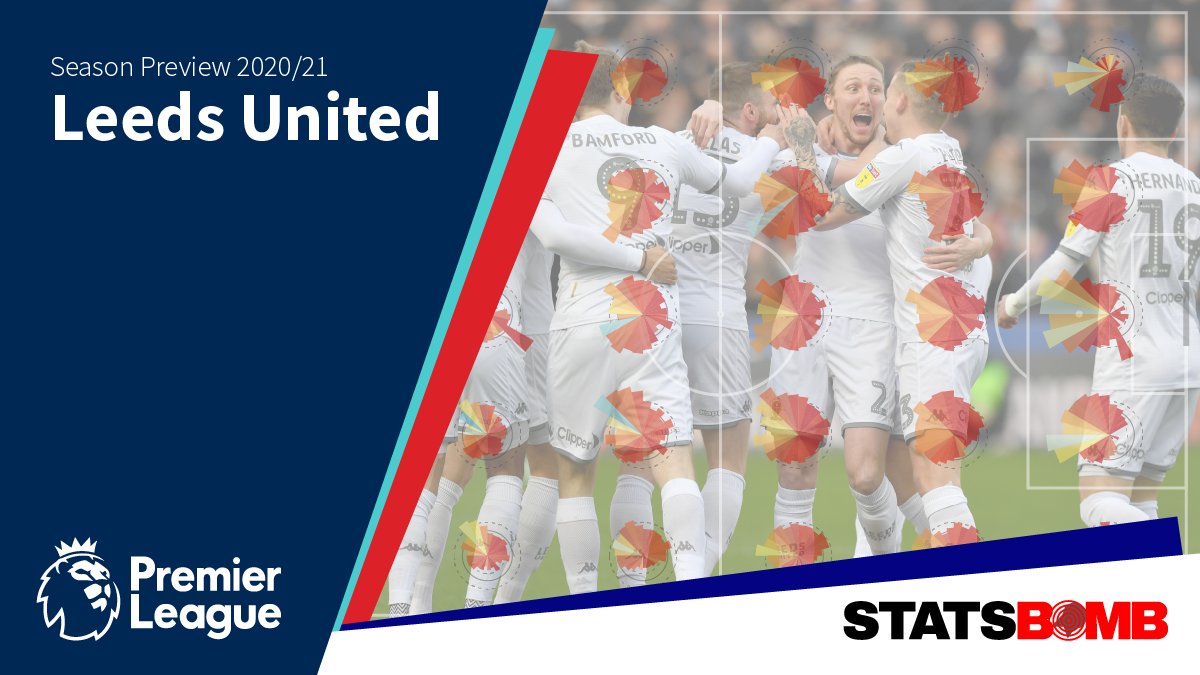
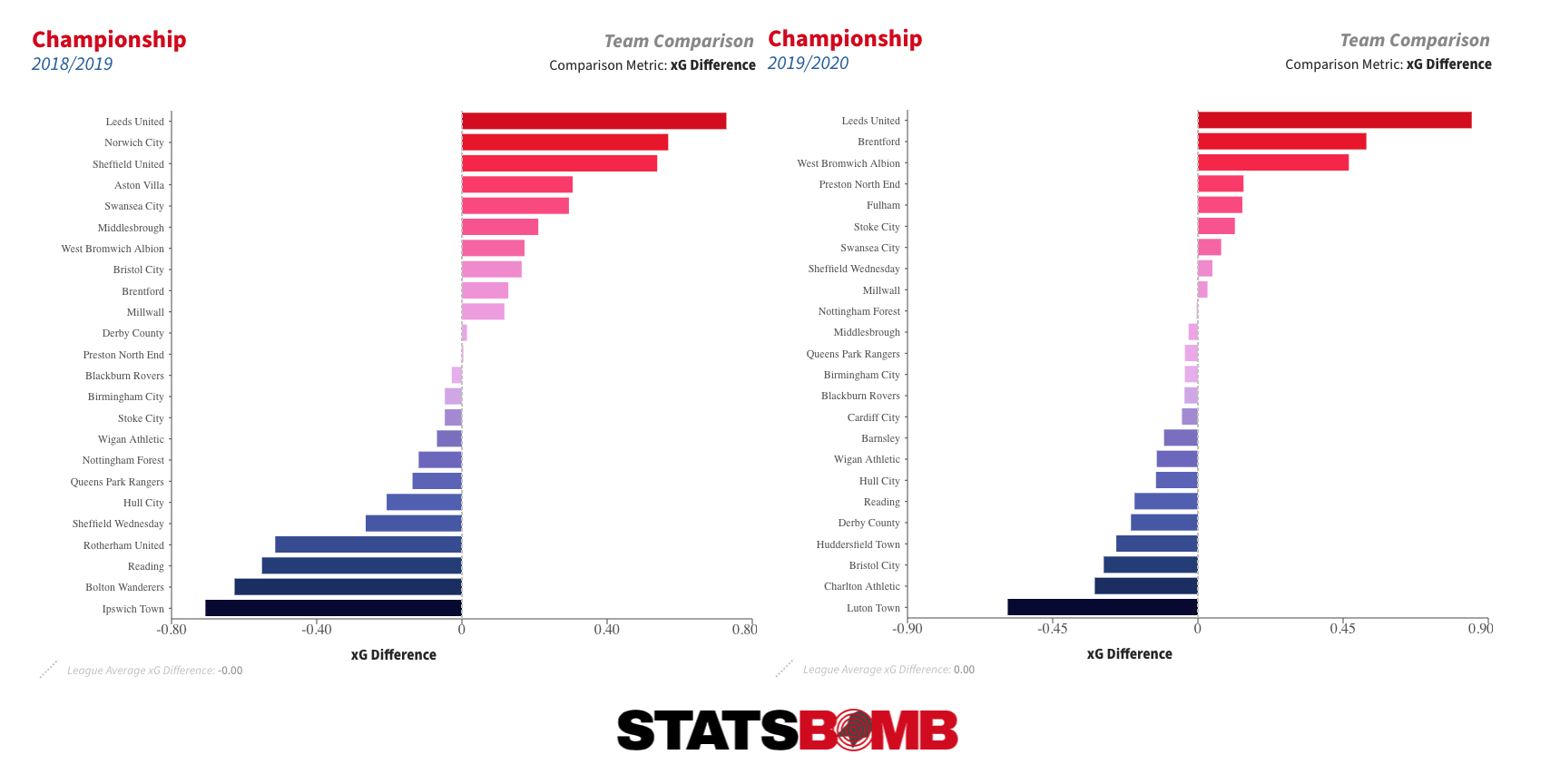 The club’s defensive record was particularly strong. They conceded just 35 times in 46 matches and also had the league’s best metrics. They gave up fewer shots (8.78 per match) than any other side, and the average quality of those shots was also one of the lowest in the division.
The club’s defensive record was particularly strong. They conceded just 35 times in 46 matches and also had the league’s best metrics. They gave up fewer shots (8.78 per match) than any other side, and the average quality of those shots was also one of the lowest in the division. 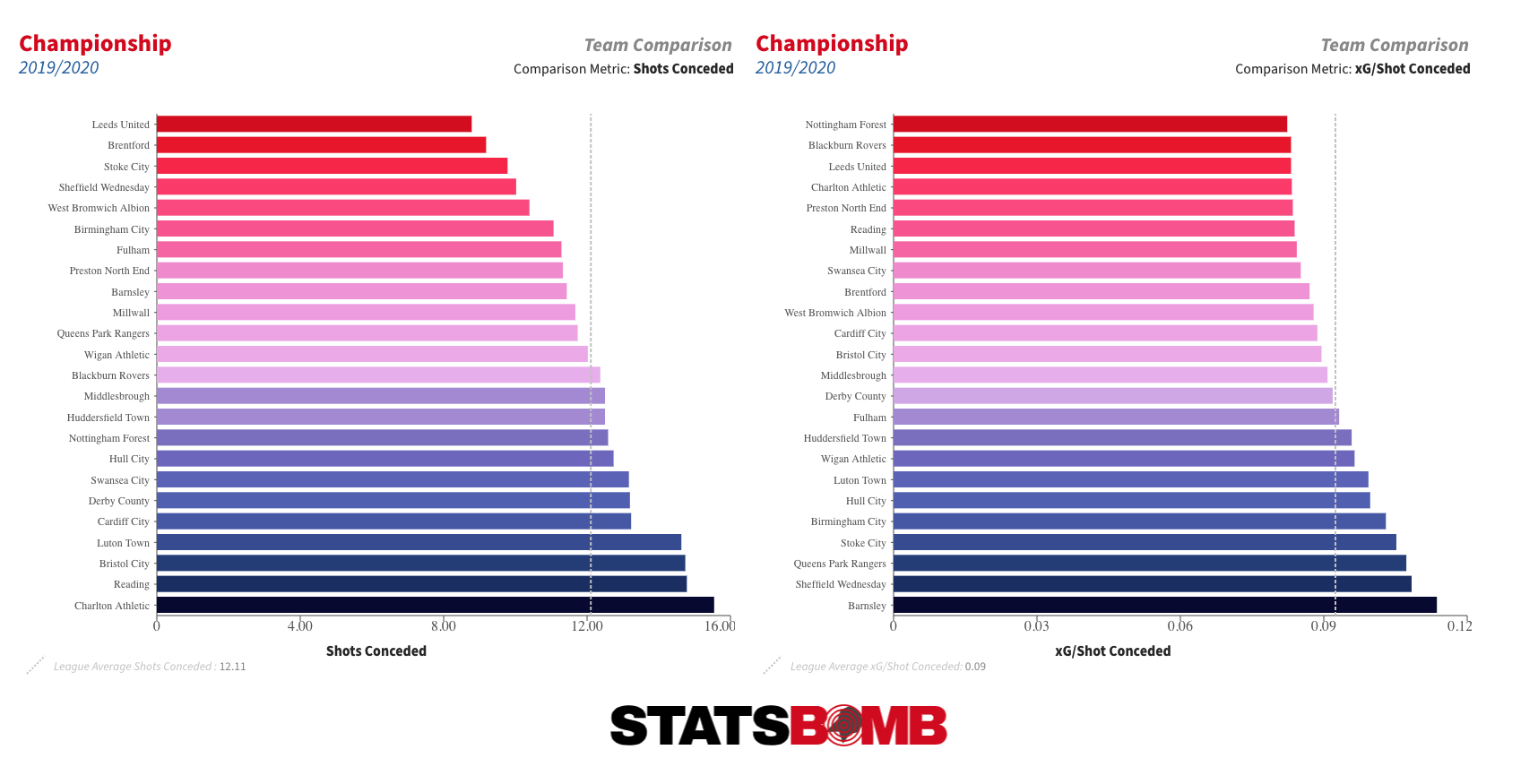 That was partly down to the efficiency of Marcelo Bielsa’s patented all-pitch press. Leeds were relentless in harrying opponents over the length and breadth of the field.
That was partly down to the efficiency of Marcelo Bielsa’s patented all-pitch press. Leeds were relentless in harrying opponents over the length and breadth of the field. 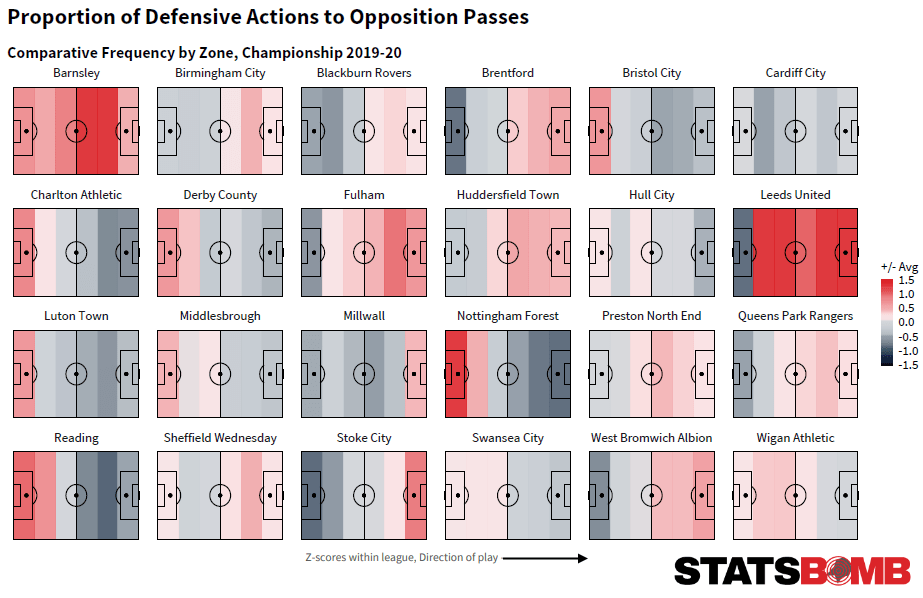 In attack, they comfortably outshot everyone, and did so while still maintaining one of the highest average shot quality marks in the league. All that off-ball movement, the pretty patterns and interchanges, helped to create a high volume of shots from good locations.
In attack, they comfortably outshot everyone, and did so while still maintaining one of the highest average shot quality marks in the league. All that off-ball movement, the pretty patterns and interchanges, helped to create a high volume of shots from good locations. 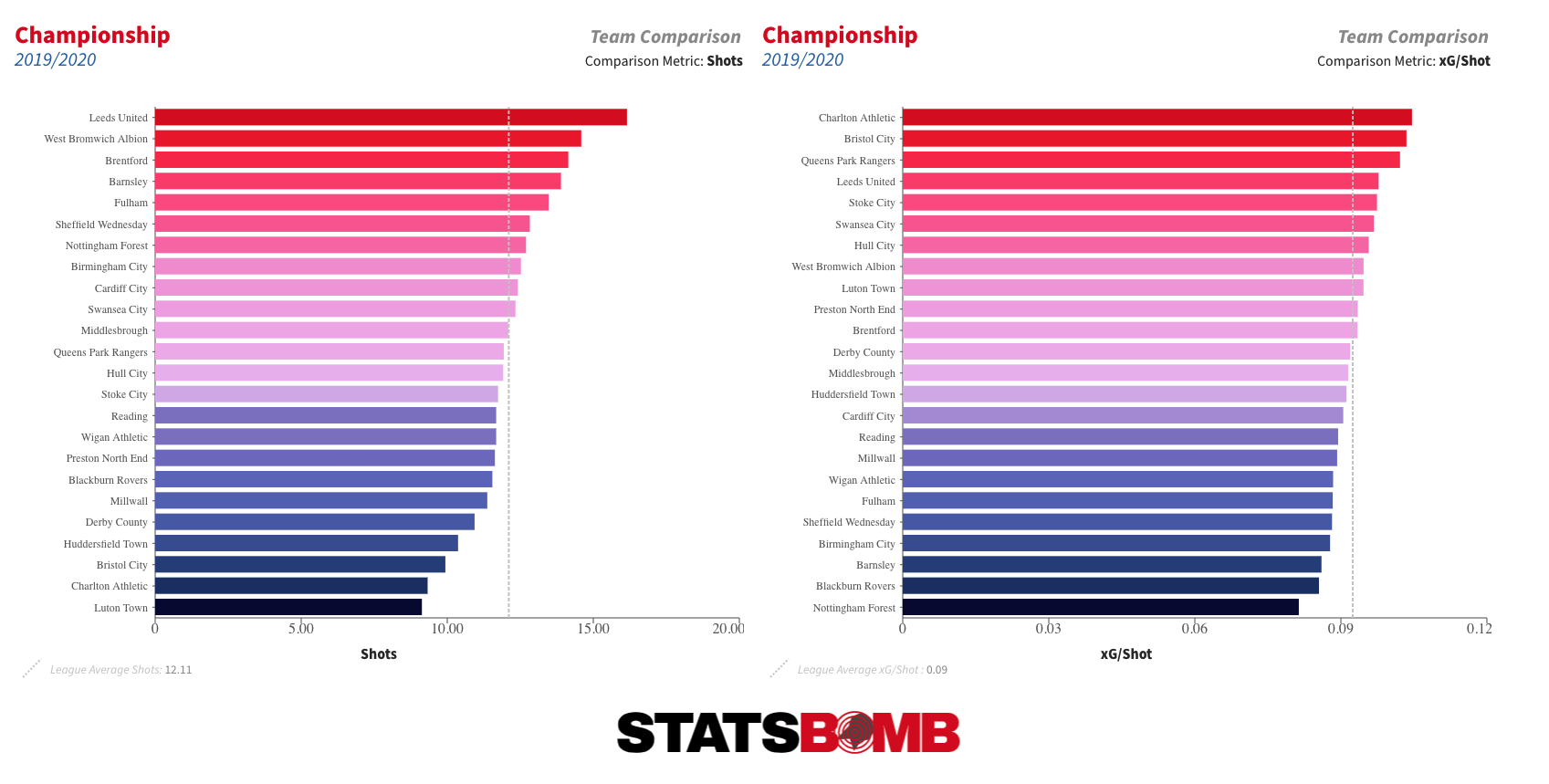 Whichever way you look at it, Leeds were a dominant team, taking 65% of the shots, accumulating 68% of the xG and scoring 69% of the goals in their matches. A clearly defined play style, strong overall metrics and a solid defensive base are all generally predictive of a good first campaign in the top flight. To illustrate this point, over the last 10 years, only two teams have been promoted with a better average goal difference per match than Leeds’ figure of 0.91: Newcastle in 2016-17 and Wolverhampton Wanderers in 2017-18. Like Leeds, both conceded under a goal per match during their promotion campaigns. Both went on to only concede around 17% more goals in the Premier League, compared to an average for promoted teams of around 40%, and both finished in the top 10. Leeds have a good base to work from, and they've also been able to retain almost all of the important squad members from their promotion campaign. Hélder Costa and young goalkeeper Illan Meslier, who got a run of games as first choice after lockdown due to Kiko Casilla’s suspension for racist language, have both had their loans turned into permanent deals. Jack Harrison will stay on board for another season on loan from Manchester City. The one key departure is that of Brighton loanee Ben White. He started all 46 matches last season, and became a key figure in the centre of defence, impressing on both sides of the ball. Reports suggest that Leeds were keen to sign him permanently, but Brighton instead decided to bring him back into the fold there. It was, therefore, unsurprising that one of the club’s first off-season signings was Robin Koch, a 24-year-old central defender from Freiburg in the Bundesliga, capped three times by Germany. White was the more proactive defender in his regular partnership with Liam Cooper, stepping forward more often to contest possession and intercept, both on a outright basis and proportionally to all defensive actions when they started together in the centre of defence. Cooper cleaned up behind and was a dominant aerial force. Koch seems to profile more like Cooper than White, with a lesser proportion of proactive defensive actions than the man he replaces. But it is important to add some context here. Freiburg were one of the most passive and deep-defending teams in the Bundesliga last season, and Koch often played as the central of three central defenders. In such a system, it is entirely normal for the player in that role to be the least proactive of the three. As such, it is hard to get a handle on just how apt a White replacement he is from the data. Their passing profiles are more similar, and Koch does seem to have solid range there. Qualitative scouting has presumably left the recruitment team confident that he can slot into White’s role. Cooper was again the less proactive element in his partnership with Pontus Jansson in 2018-19, so there is little evidence he’d be capable of defending in a different manner. As well as Koch, Leeds have also signed a trio of younger players in Charlie Allen (16), Cody Drameh (18) and Joe Gelhardt (18), the latter of whom posted good shot volume in a very limited sample size of just over 500 minutes at Wigan in the Championship last season. But the big money has been spent on the club-record, £27 million signing of Rodrigo from Valencia. Readers with good memories may recall Rodrigo from his one-season loan at Bolton Wanderers back in 2010-11, but the player who arrives at Elland Road has developed considerably since then and is now a full Spain international. He, like the entire Valencia team, didn’t have a great time of it last season, but in 2018-19, he provided a goal or assist for every 180 minutes he was on the pitch in terms of both real and expected output.
Whichever way you look at it, Leeds were a dominant team, taking 65% of the shots, accumulating 68% of the xG and scoring 69% of the goals in their matches. A clearly defined play style, strong overall metrics and a solid defensive base are all generally predictive of a good first campaign in the top flight. To illustrate this point, over the last 10 years, only two teams have been promoted with a better average goal difference per match than Leeds’ figure of 0.91: Newcastle in 2016-17 and Wolverhampton Wanderers in 2017-18. Like Leeds, both conceded under a goal per match during their promotion campaigns. Both went on to only concede around 17% more goals in the Premier League, compared to an average for promoted teams of around 40%, and both finished in the top 10. Leeds have a good base to work from, and they've also been able to retain almost all of the important squad members from their promotion campaign. Hélder Costa and young goalkeeper Illan Meslier, who got a run of games as first choice after lockdown due to Kiko Casilla’s suspension for racist language, have both had their loans turned into permanent deals. Jack Harrison will stay on board for another season on loan from Manchester City. The one key departure is that of Brighton loanee Ben White. He started all 46 matches last season, and became a key figure in the centre of defence, impressing on both sides of the ball. Reports suggest that Leeds were keen to sign him permanently, but Brighton instead decided to bring him back into the fold there. It was, therefore, unsurprising that one of the club’s first off-season signings was Robin Koch, a 24-year-old central defender from Freiburg in the Bundesliga, capped three times by Germany. White was the more proactive defender in his regular partnership with Liam Cooper, stepping forward more often to contest possession and intercept, both on a outright basis and proportionally to all defensive actions when they started together in the centre of defence. Cooper cleaned up behind and was a dominant aerial force. Koch seems to profile more like Cooper than White, with a lesser proportion of proactive defensive actions than the man he replaces. But it is important to add some context here. Freiburg were one of the most passive and deep-defending teams in the Bundesliga last season, and Koch often played as the central of three central defenders. In such a system, it is entirely normal for the player in that role to be the least proactive of the three. As such, it is hard to get a handle on just how apt a White replacement he is from the data. Their passing profiles are more similar, and Koch does seem to have solid range there. Qualitative scouting has presumably left the recruitment team confident that he can slot into White’s role. Cooper was again the less proactive element in his partnership with Pontus Jansson in 2018-19, so there is little evidence he’d be capable of defending in a different manner. As well as Koch, Leeds have also signed a trio of younger players in Charlie Allen (16), Cody Drameh (18) and Joe Gelhardt (18), the latter of whom posted good shot volume in a very limited sample size of just over 500 minutes at Wigan in the Championship last season. But the big money has been spent on the club-record, £27 million signing of Rodrigo from Valencia. Readers with good memories may recall Rodrigo from his one-season loan at Bolton Wanderers back in 2010-11, but the player who arrives at Elland Road has developed considerably since then and is now a full Spain international. He, like the entire Valencia team, didn’t have a great time of it last season, but in 2018-19, he provided a goal or assist for every 180 minutes he was on the pitch in terms of both real and expected output. 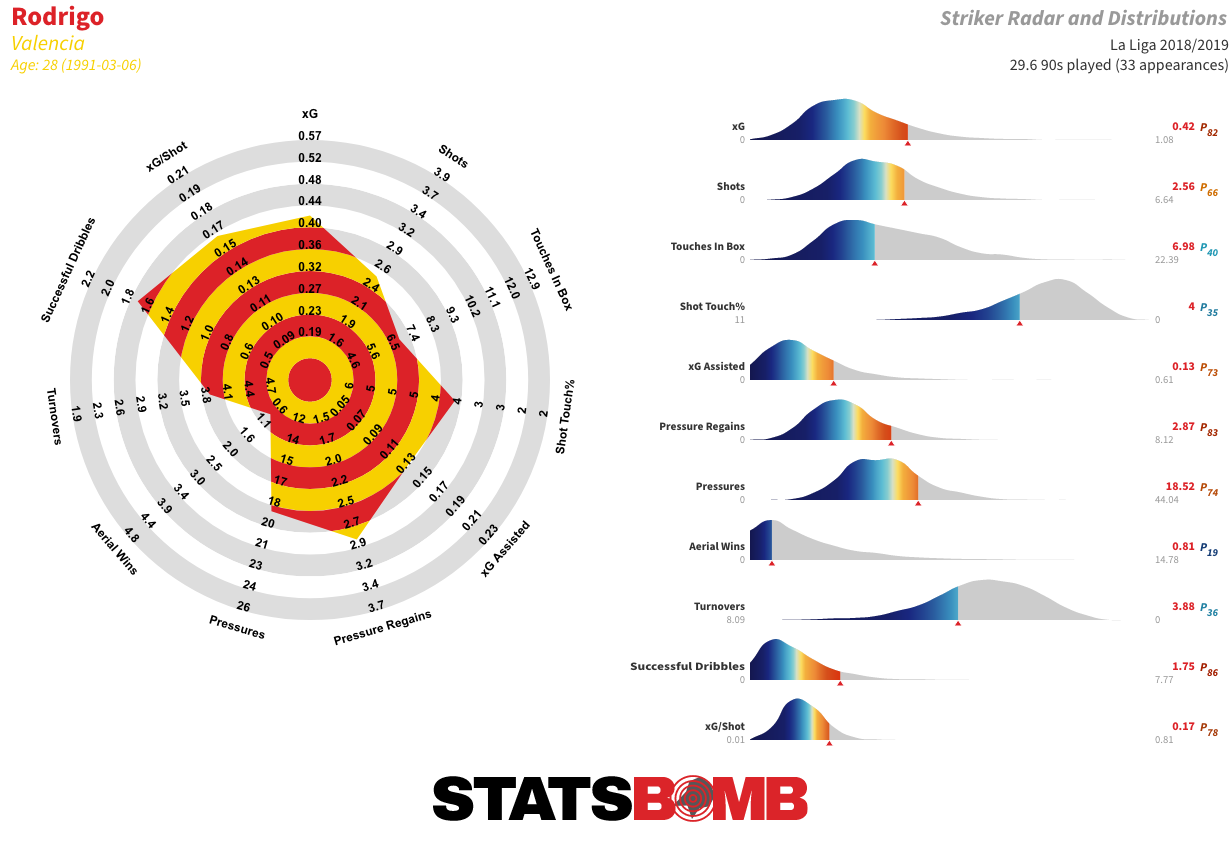 Valencia were a counter-attacking team and Rodrigo was often a key part of their forward transitions, dropping off the front to receive, turn and combine with onward runners. Quick and intelligent in his movements, he has a skillset that should mesh well with Bielsa’s system, even if, as with Koch, he comes in from a team considerably less aggressive out of possession than this current Leeds side. The age profile isn’t great, but he should prove to be a direct improvement on Patrick Bamford at the centre of the attack. Leeds have also shown strong interest in Rodrigo de Paul, a creative midfielder who has been pretty consistently good at Udinese over the last couple of seasons. He doesn’t provide a great deal of defensive output, but the old Bielsa motto of it being easier to teach a talented player to run than make an energetic player talented may just ring true here. He would certainly represent an upgrade in one of the two more advanced midfield roles in the 4-1-4-1/4-3-3 that has served Leeds so well over the last couple of seasons.
Valencia were a counter-attacking team and Rodrigo was often a key part of their forward transitions, dropping off the front to receive, turn and combine with onward runners. Quick and intelligent in his movements, he has a skillset that should mesh well with Bielsa’s system, even if, as with Koch, he comes in from a team considerably less aggressive out of possession than this current Leeds side. The age profile isn’t great, but he should prove to be a direct improvement on Patrick Bamford at the centre of the attack. Leeds have also shown strong interest in Rodrigo de Paul, a creative midfielder who has been pretty consistently good at Udinese over the last couple of seasons. He doesn’t provide a great deal of defensive output, but the old Bielsa motto of it being easier to teach a talented player to run than make an energetic player talented may just ring true here. He would certainly represent an upgrade in one of the two more advanced midfield roles in the 4-1-4-1/4-3-3 that has served Leeds so well over the last couple of seasons. 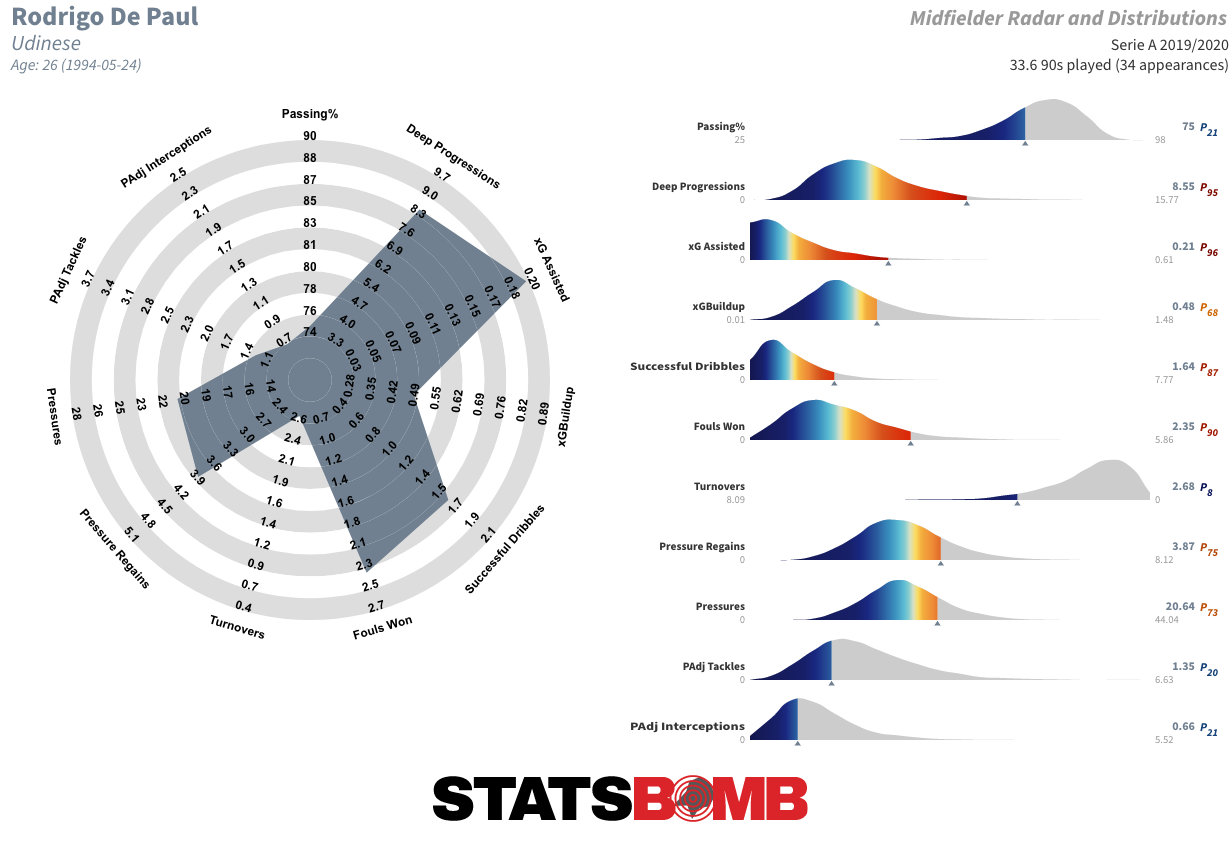 Maintaining a stable squad while upgrading in key positions seems a sensible way of confronting the club’s first Premier League season in 16 years, even though there is still a degree of uncertainty in terms of the performance levels that can be expected from some of the existing squad members. Many of these players were, after all, involved in a mid-table Championship finish in the season before Bielsa’s arrival. Any individual deficiencies will be that much clearer in the top flight. With that said, the front-foot style of play of the collective should be sufficient to get Leeds enough points from some of the league’s blander teams to provide a solid platform for a mid-table finish. Theirs is an exciting approach and it will be intriguing to see how they fare in their attempts to go toe-to-toe with teams towards the top of the table. An opening day trip to Anfield and champions Liverpool will give us an early taste of what to expect.
Maintaining a stable squad while upgrading in key positions seems a sensible way of confronting the club’s first Premier League season in 16 years, even though there is still a degree of uncertainty in terms of the performance levels that can be expected from some of the existing squad members. Many of these players were, after all, involved in a mid-table Championship finish in the season before Bielsa’s arrival. Any individual deficiencies will be that much clearer in the top flight. With that said, the front-foot style of play of the collective should be sufficient to get Leeds enough points from some of the league’s blander teams to provide a solid platform for a mid-table finish. Theirs is an exciting approach and it will be intriguing to see how they fare in their attempts to go toe-to-toe with teams towards the top of the table. An opening day trip to Anfield and champions Liverpool will give us an early taste of what to expect. 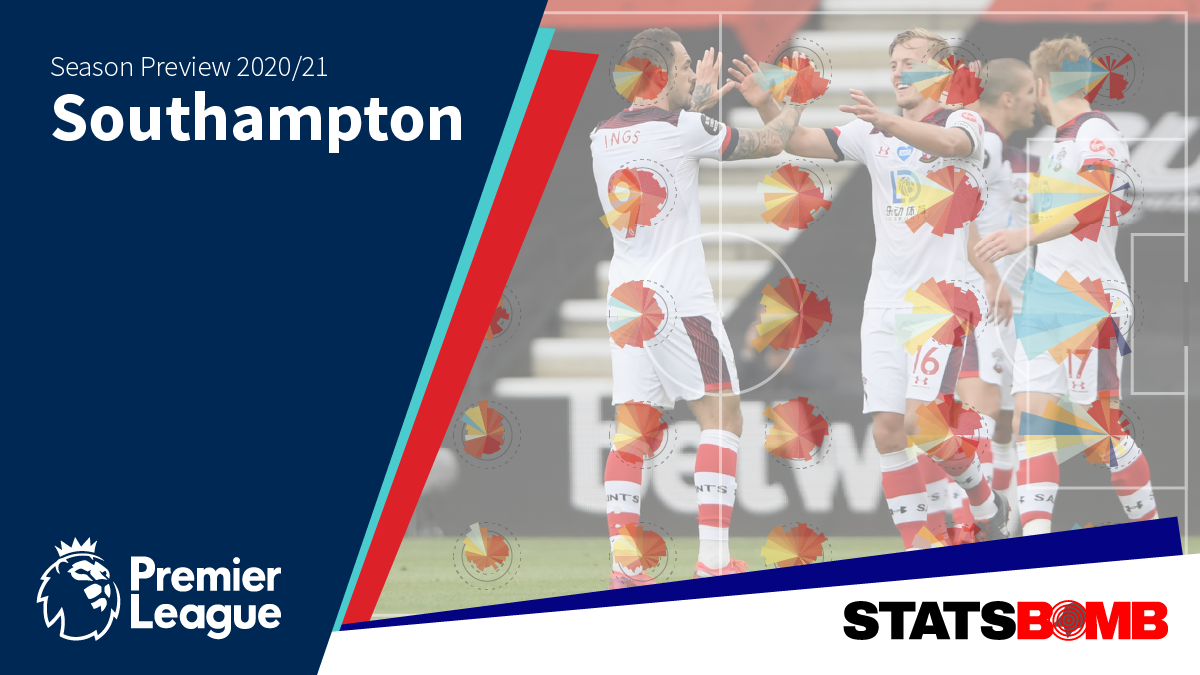
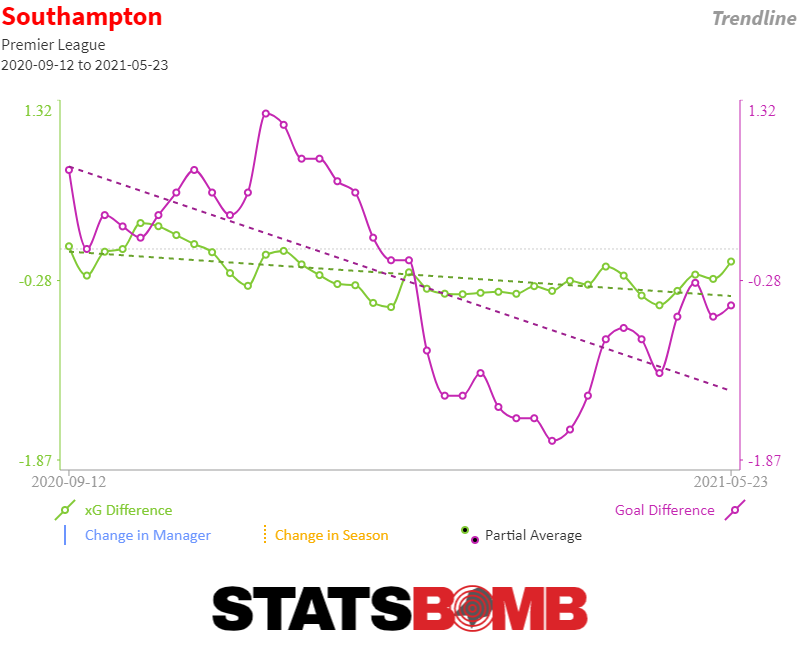 There were bad games across the season, and that rather impacted the metrics as a whole. Seven times Southampton gave up large xG totals (around 2.5 and up) in individual games. Some of them were understandable; both Manchester City games, Liverpool away and the 9-0, but it also occurred in back to back games just before the Covid break away to West Ham and home to Newcastle (thanks to Moussa Djenepo's first half red card) and then at home to Arsenal after the restart:
There were bad games across the season, and that rather impacted the metrics as a whole. Seven times Southampton gave up large xG totals (around 2.5 and up) in individual games. Some of them were understandable; both Manchester City games, Liverpool away and the 9-0, but it also occurred in back to back games just before the Covid break away to West Ham and home to Newcastle (thanks to Moussa Djenepo's first half red card) and then at home to Arsenal after the restart: 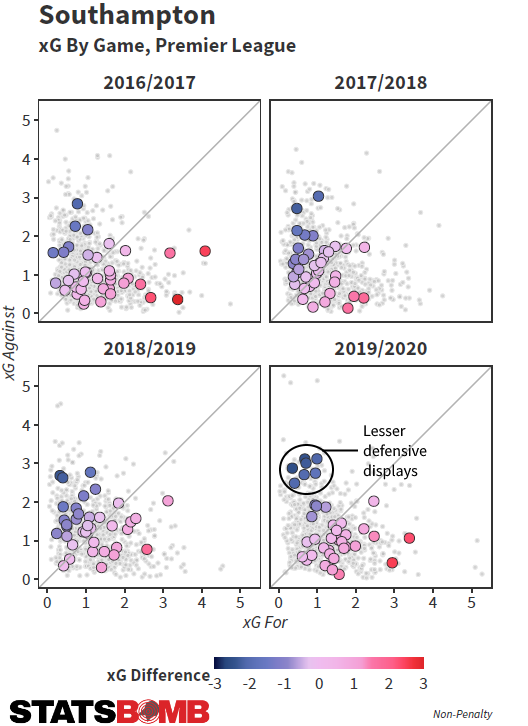 There's little doubt that this kind of vulnerability can be a by-product of games in which pressing teams are outmaneuvered. The Liverpool away game is a great example, as the team competed really well in the first half but Liverpool exerted themselves as the game wore on and won 4-0. The passing network from that game shows the generally equal balance of the game in regard to possession locations, which is unusual for a team against Liverpool. Another real rarity was Trent Alexander-Arnold getting pushed right back into the er... right back slot:
There's little doubt that this kind of vulnerability can be a by-product of games in which pressing teams are outmaneuvered. The Liverpool away game is a great example, as the team competed really well in the first half but Liverpool exerted themselves as the game wore on and won 4-0. The passing network from that game shows the generally equal balance of the game in regard to possession locations, which is unusual for a team against Liverpool. Another real rarity was Trent Alexander-Arnold getting pushed right back into the er... right back slot: 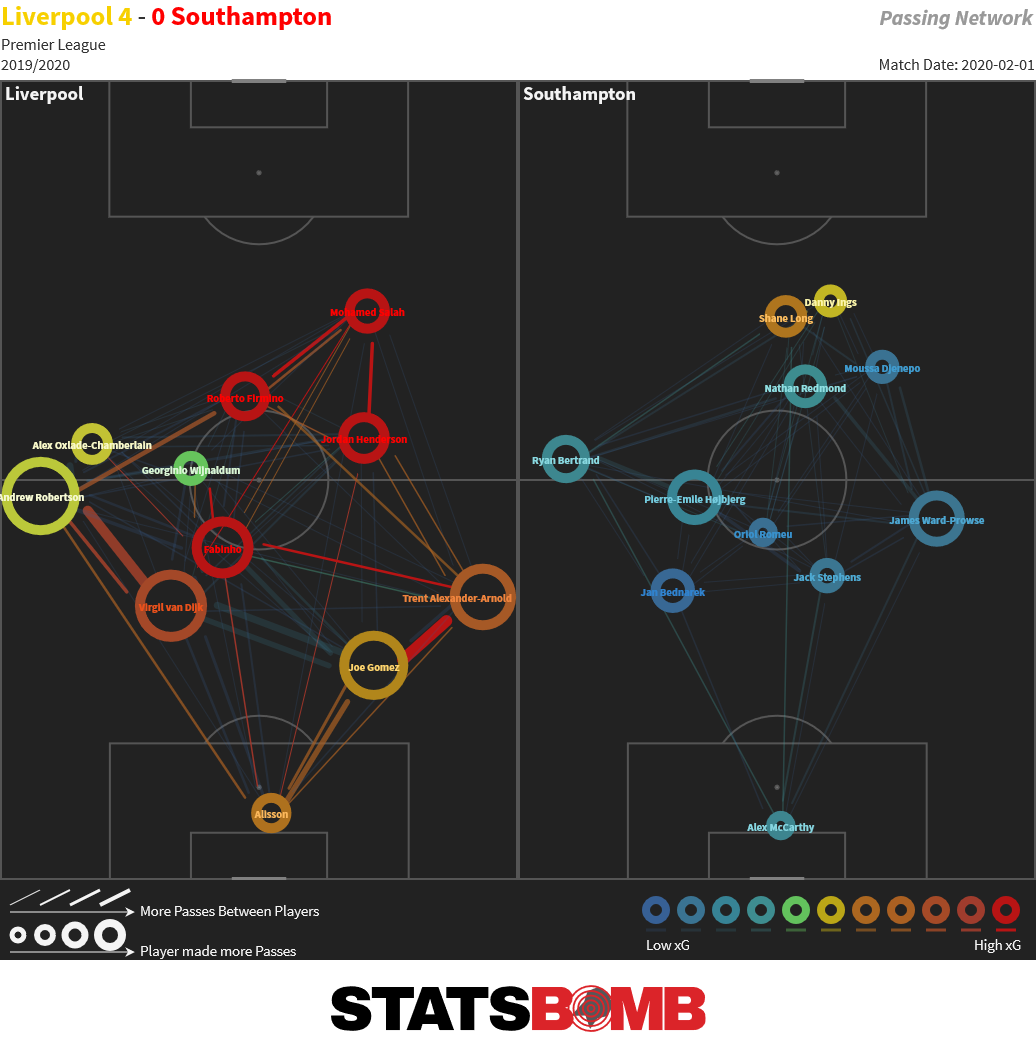 Southampton’s season was gilded by a phenomenal season from Danny Ings. He scored 22 goals in the league (21+1 penalty) from an expected rate of close to 16, but more remarkable was his sheer consistency. Across the past four seasons, only Mohamed Salah in 2017-18 has scored a non-penalty goal in over half a team’s games in a season (23 separate games), Ings is second on that list having notched in 19. If you sat down to watch a Southampton game in 2019-20 it was a literal coin flip whether or not you’d see an Ings goal. He only scored one header and was not adept at getting on the end of crosses from open play, but otherwise scored a likeable variation of goals: tap-ins, off throughballs, after beating a defender to make space or a shot, from longer range and with both feet.
Southampton’s season was gilded by a phenomenal season from Danny Ings. He scored 22 goals in the league (21+1 penalty) from an expected rate of close to 16, but more remarkable was his sheer consistency. Across the past four seasons, only Mohamed Salah in 2017-18 has scored a non-penalty goal in over half a team’s games in a season (23 separate games), Ings is second on that list having notched in 19. If you sat down to watch a Southampton game in 2019-20 it was a literal coin flip whether or not you’d see an Ings goal. He only scored one header and was not adept at getting on the end of crosses from open play, but otherwise scored a likeable variation of goals: tap-ins, off throughballs, after beating a defender to make space or a shot, from longer range and with both feet. 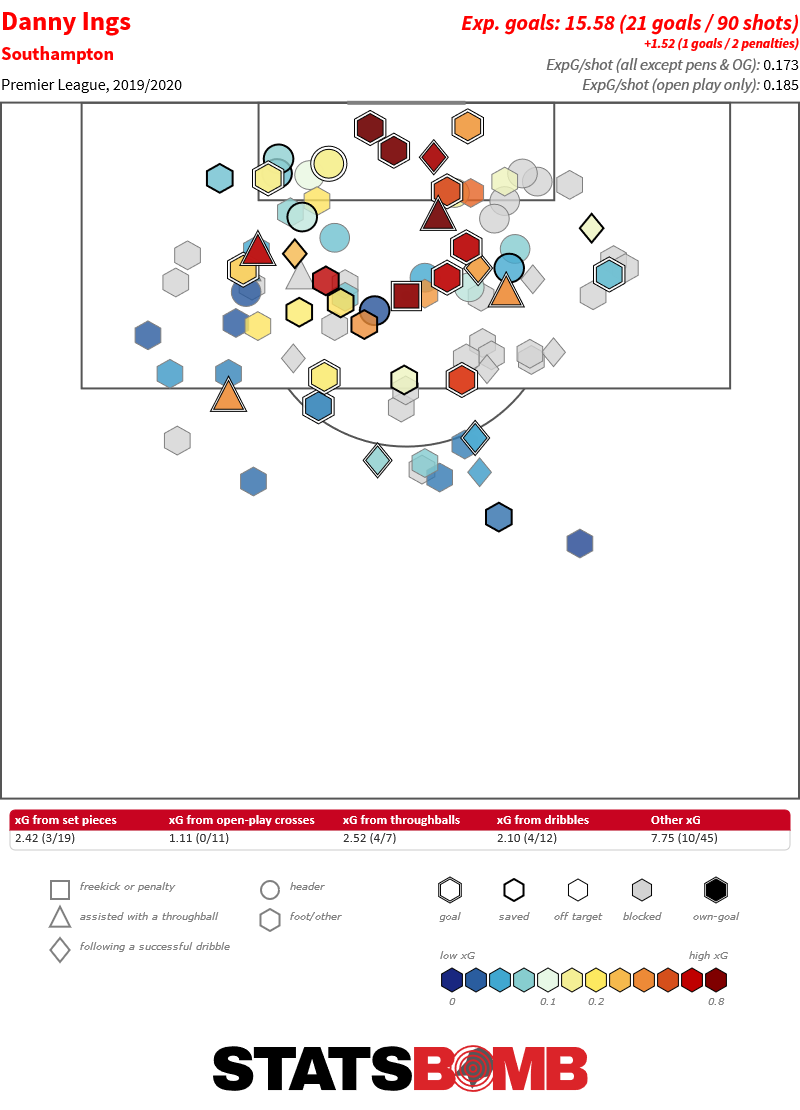 He also led the press: his 25 pressure events per game was highest in the team. Loads of goals, loads of work rate. What’s not to like? He didn’t create much with his passing, but nor did anyone else, that's just not how this team creates. The team pushed high, won the ball back and grabbed shots--they ranked fifth behind the top four sides for shots directly generated from a high press at over three per game. We can see how Southampton have evolved over four seasons here, or at least how Hasenhüttl's tenure has built the press from the front. They're more active high up the pitch than at any time since (to my surprise) Claude Puel in 2016-17, and the pattern in how they play now is very clear:
He also led the press: his 25 pressure events per game was highest in the team. Loads of goals, loads of work rate. What’s not to like? He didn’t create much with his passing, but nor did anyone else, that's just not how this team creates. The team pushed high, won the ball back and grabbed shots--they ranked fifth behind the top four sides for shots directly generated from a high press at over three per game. We can see how Southampton have evolved over four seasons here, or at least how Hasenhüttl's tenure has built the press from the front. They're more active high up the pitch than at any time since (to my surprise) Claude Puel in 2016-17, and the pattern in how they play now is very clear: 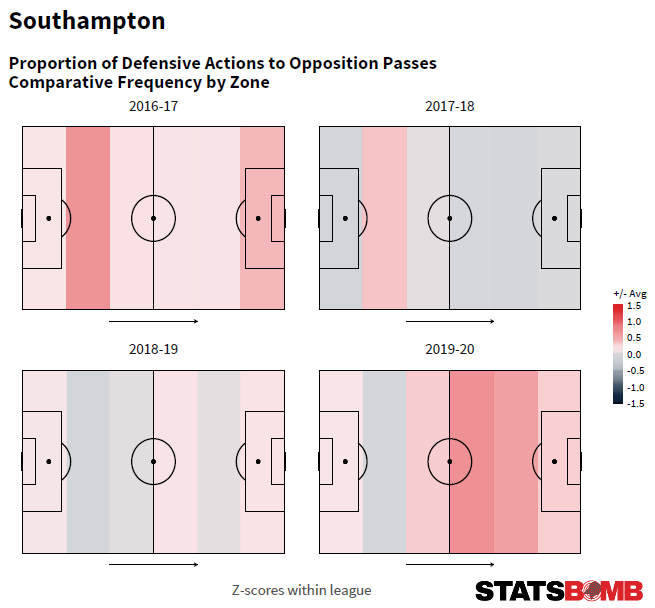 There's a lesson here around lineage and manager recruitment too. It can take time for a manager to get their methods across, even more so if they need to unpick diametrically opposed work done in a different direction by former managers. Having kept faith with Hasenhüttl through a tough period, a concerted and clear style has emerged, with some success. Personnel Southampton have made a couple of early moves in the market to shore up their defence. Kyle Walker-Peters followed up his loan from Tottenham with a permanent move. That a large volume of Tottenham fans were sad to see him depart, feeling he could have been used more over the years is indicative of his general ability. He could easily have been used more in their rotation and should be entirely fine at Southampton, especially with half a season under his belt already. Mohammed Salisu effectively takes Maya Yoshida’s place in the squad and as a young left footed centre back, is a relatively scarce talent within the league, and within this squad. The 6ft3” former Real Valladolid man has just one season of top-flight experience. During that season he was Valladolid’s main back line defender recording significantly higher percentage of defensive clearances than his centre back partners, scarcely being dribbled past but was not error-free, as you might expect from a young centre back. There may be more additions to come. In particular, central midfield looks a little light with Pierre-Emile Højbjerg moving to Tottenham and Harrison Reed and Mario Lemina each landing at Fulham for the forthcoming season at least, instead of returning. There's also some hope to see better in season two from Che Adams and Moussa Djenepo. Both found it hard to gain consistent minutes in 2019-20, but some starts late on saw Adams finally score his first Premier League goal with a kooky 40-yarder against Manchester City and he followed it up with three more before season's end. Meanwhile, Djenepo had a stop-start season with injuries, the loss of his mother and suspension all contributing to reduced time spent on the pitch. when he did play, he showed he wasn't far off the player he showed at Standard Liege:
There's a lesson here around lineage and manager recruitment too. It can take time for a manager to get their methods across, even more so if they need to unpick diametrically opposed work done in a different direction by former managers. Having kept faith with Hasenhüttl through a tough period, a concerted and clear style has emerged, with some success. Personnel Southampton have made a couple of early moves in the market to shore up their defence. Kyle Walker-Peters followed up his loan from Tottenham with a permanent move. That a large volume of Tottenham fans were sad to see him depart, feeling he could have been used more over the years is indicative of his general ability. He could easily have been used more in their rotation and should be entirely fine at Southampton, especially with half a season under his belt already. Mohammed Salisu effectively takes Maya Yoshida’s place in the squad and as a young left footed centre back, is a relatively scarce talent within the league, and within this squad. The 6ft3” former Real Valladolid man has just one season of top-flight experience. During that season he was Valladolid’s main back line defender recording significantly higher percentage of defensive clearances than his centre back partners, scarcely being dribbled past but was not error-free, as you might expect from a young centre back. There may be more additions to come. In particular, central midfield looks a little light with Pierre-Emile Højbjerg moving to Tottenham and Harrison Reed and Mario Lemina each landing at Fulham for the forthcoming season at least, instead of returning. There's also some hope to see better in season two from Che Adams and Moussa Djenepo. Both found it hard to gain consistent minutes in 2019-20, but some starts late on saw Adams finally score his first Premier League goal with a kooky 40-yarder against Manchester City and he followed it up with three more before season's end. Meanwhile, Djenepo had a stop-start season with injuries, the loss of his mother and suspension all contributing to reduced time spent on the pitch. when he did play, he showed he wasn't far off the player he showed at Standard Liege: 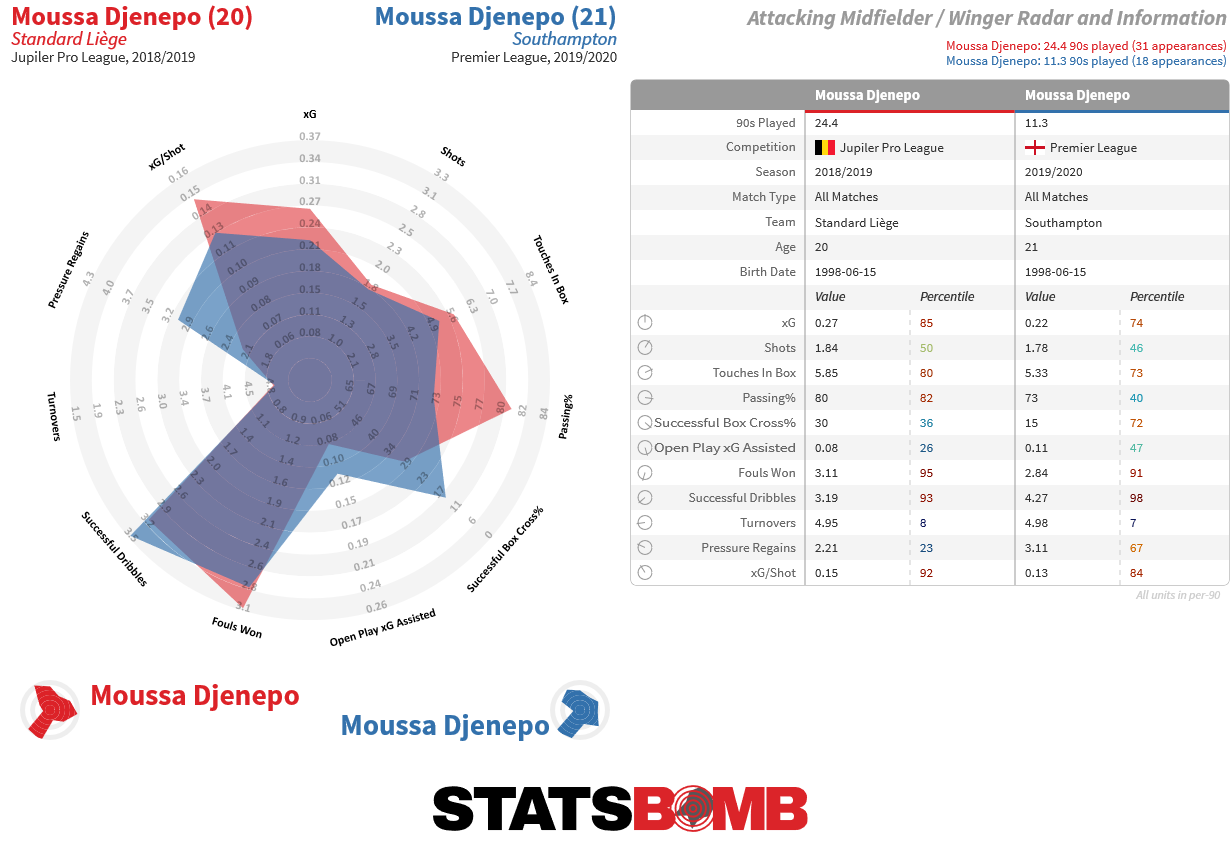 Projection Southampton finished eleventh last season, which represented getting the car back on the tarmac after a couple of seasons of off-roading down the table. All in, raw expected goals rated them eighth best and liked them more than Tottenham and Arsenal. Sporting Index opening lines had them at around 50 points which maroons them in mid-table but would also be completely safe. You don't look at this squad and see the appealing talent levels that led Liverpool to routinely buy Southampton players for so many years, and ironically the one player who made the opposite journey, Ings, is one that will likely have a huge bearing on how Southampton progress this season. If he can stay fit and continue to score at a good clip, it takes the pressure off the midfield, which has been somewhat goalshy for a number of seasons. It is also good for the league that we have a non-elite pressing team competing at a solid level, and Hasenhüttl may not have hit his ceiling here yet. Anything in the top half will represent another good season, and should certainly be the aim.
Projection Southampton finished eleventh last season, which represented getting the car back on the tarmac after a couple of seasons of off-roading down the table. All in, raw expected goals rated them eighth best and liked them more than Tottenham and Arsenal. Sporting Index opening lines had them at around 50 points which maroons them in mid-table but would also be completely safe. You don't look at this squad and see the appealing talent levels that led Liverpool to routinely buy Southampton players for so many years, and ironically the one player who made the opposite journey, Ings, is one that will likely have a huge bearing on how Southampton progress this season. If he can stay fit and continue to score at a good clip, it takes the pressure off the midfield, which has been somewhat goalshy for a number of seasons. It is also good for the league that we have a non-elite pressing team competing at a solid level, and Hasenhüttl may not have hit his ceiling here yet. Anything in the top half will represent another good season, and should certainly be the aim. 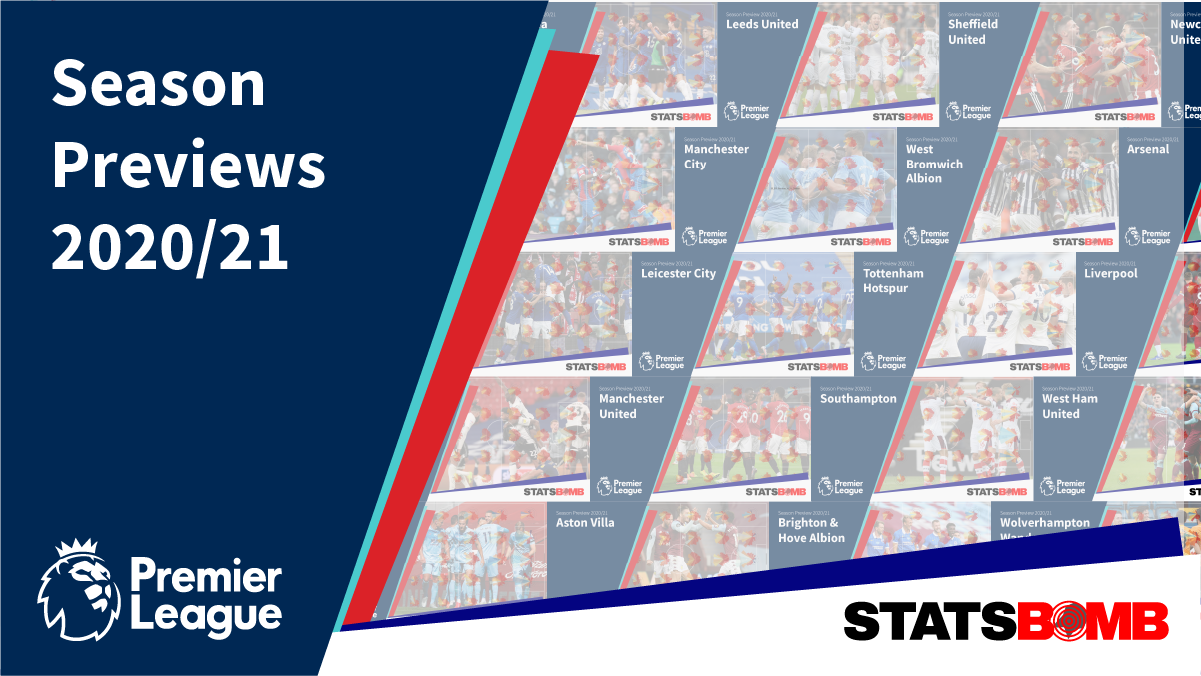
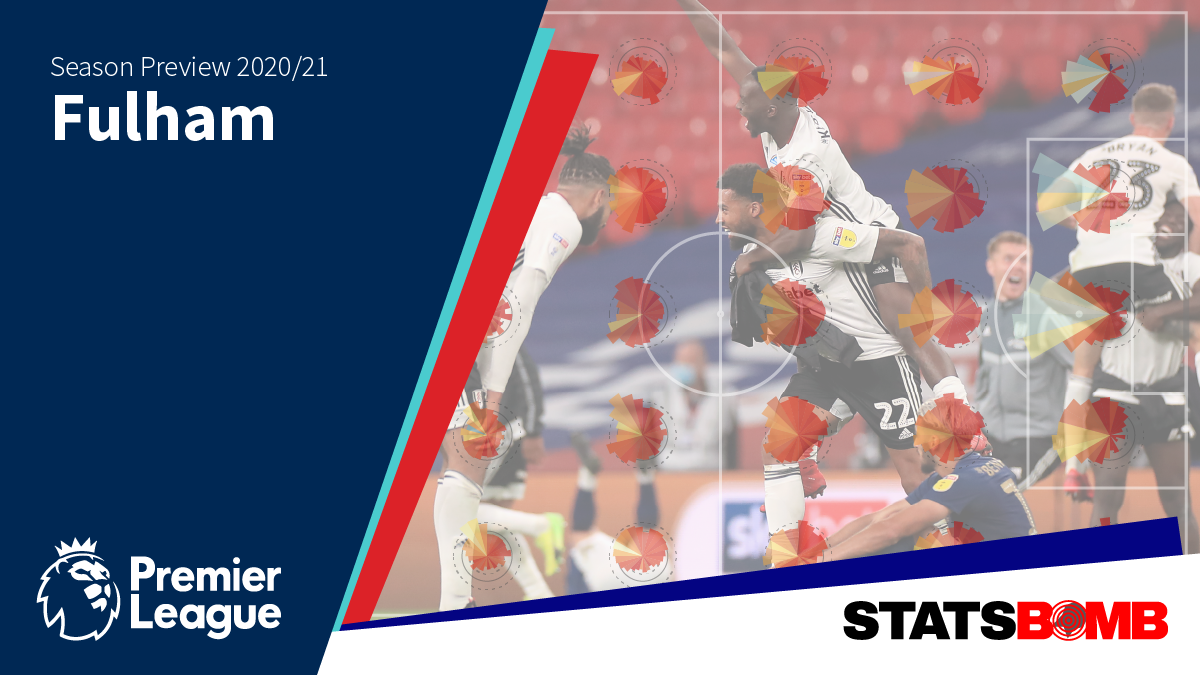
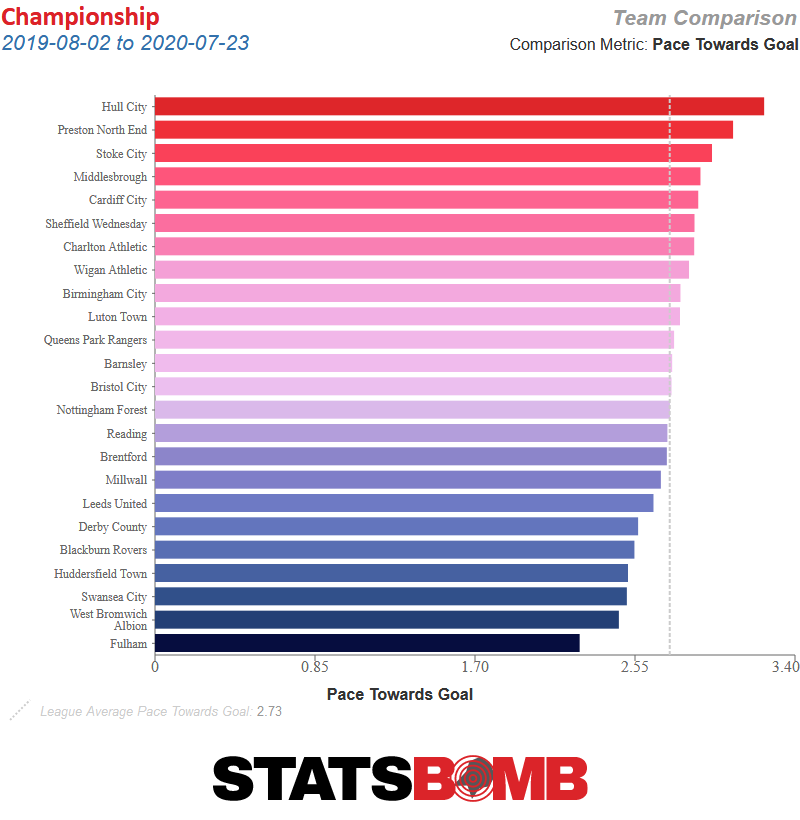 Their aversion to breaking quickly was evident in the lack of counter attacking opportunities generated, something that Jokanović’s side were not afraid to do if the space was available.
Their aversion to breaking quickly was evident in the lack of counter attacking opportunities generated, something that Jokanović’s side were not afraid to do if the space was available. 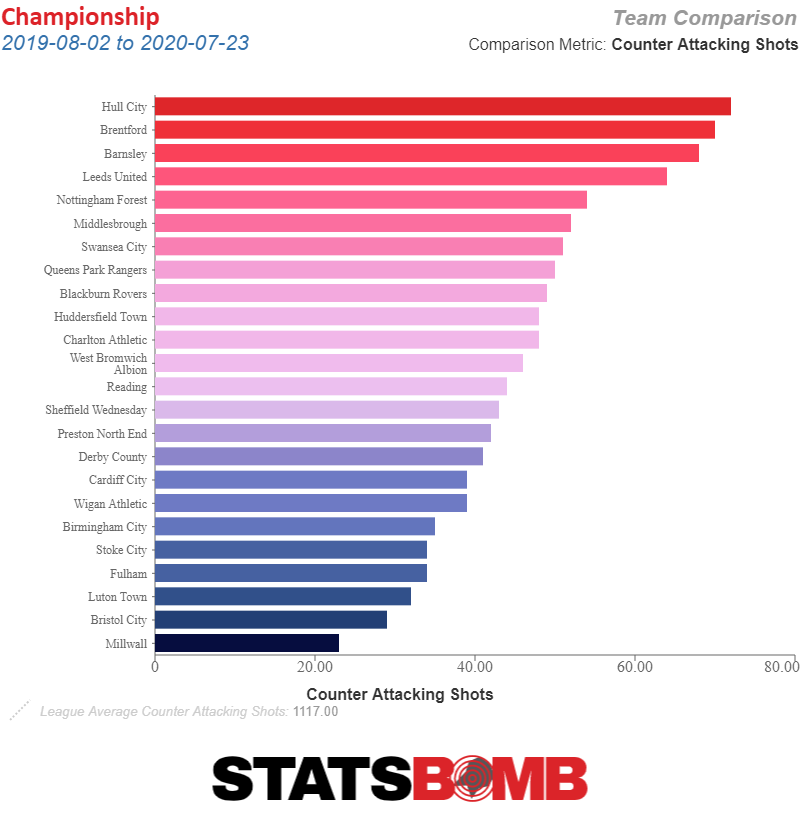 Logic dictates that you’re only going to make things more difficult for yourself if you commit to attacking against a set defence all the time and it was evident in the metrics; Fulham’s 1.18xG created per game was some way behind promotion rivals Brentford (1.33xG), West Brom (1.38xG), and Leeds (1.58xG) and others too, ranking 7th in the Championship across the regular season. Of course, there’s a balance to be struck and Fulham built a reputation for grinding out victories on the foundation of a sturdy defence, Parker’s pragmatism at least paying off at the other end of the pitch. 17 clean sheets was a total beaten only by champions Leeds, and Fulham also had a remarkable record of staying in front once they were ahead, conceding just five equalising goals in the entire season and going W21 D3 L0 in the 24 games they took the lead in. Despite that sterling record, the fans certainly weren’t particularly impressed with the regularity they were seeing their side take a lead and then sit on it rather than pushing on. Of Fulham’s 23 victories, 15 of them were by a single goal. However, there’s a real and unexpected quirk about their game state metrics. When in front, at score lines you’d expect the opposition to be having the better of the game and putting Fulham under pressure in search of an equaliser, Fulham actually created more, notching up 16.91xG to their opponents 14.24xG. They were also creating more than the opposition when scores were level, as you’d expect of a good side. Less relevant but just as weird, Fulham actually seemed to struggle most when they went behind, creating 13.79 xG to the opposition’s 14.78xG - potentially an ominous sign ahead of a season when they’ll expect to be behind more often than ahead. In summary, Fulham finished 4th in the table, had the 4th best goal difference and the 5th best expected goal difference. That’s pretty conclusive evidence to say that Fulham were, at best, the 4th best side in the division, no? Ergo, is it deserved that they were one of the three sides to go up? Well here comes the other side of the argument because of course I’m not going to ignore what happened in the play-offs. Where Parker’s pragmatism had given cause for complaint in the regular season, all of a sudden it was an asset to the task in front of them. Fulham played the first leg of their semi-final against Cardiff perfectly, conceding just six shots, and it’s hard to ask for a better result than to take a 2-0 lead away from home in the first leg. They finished the job at Craven Cottage, successfully defending a one goal aggregate lead for the entirety of the second half.
Logic dictates that you’re only going to make things more difficult for yourself if you commit to attacking against a set defence all the time and it was evident in the metrics; Fulham’s 1.18xG created per game was some way behind promotion rivals Brentford (1.33xG), West Brom (1.38xG), and Leeds (1.58xG) and others too, ranking 7th in the Championship across the regular season. Of course, there’s a balance to be struck and Fulham built a reputation for grinding out victories on the foundation of a sturdy defence, Parker’s pragmatism at least paying off at the other end of the pitch. 17 clean sheets was a total beaten only by champions Leeds, and Fulham also had a remarkable record of staying in front once they were ahead, conceding just five equalising goals in the entire season and going W21 D3 L0 in the 24 games they took the lead in. Despite that sterling record, the fans certainly weren’t particularly impressed with the regularity they were seeing their side take a lead and then sit on it rather than pushing on. Of Fulham’s 23 victories, 15 of them were by a single goal. However, there’s a real and unexpected quirk about their game state metrics. When in front, at score lines you’d expect the opposition to be having the better of the game and putting Fulham under pressure in search of an equaliser, Fulham actually created more, notching up 16.91xG to their opponents 14.24xG. They were also creating more than the opposition when scores were level, as you’d expect of a good side. Less relevant but just as weird, Fulham actually seemed to struggle most when they went behind, creating 13.79 xG to the opposition’s 14.78xG - potentially an ominous sign ahead of a season when they’ll expect to be behind more often than ahead. In summary, Fulham finished 4th in the table, had the 4th best goal difference and the 5th best expected goal difference. That’s pretty conclusive evidence to say that Fulham were, at best, the 4th best side in the division, no? Ergo, is it deserved that they were one of the three sides to go up? Well here comes the other side of the argument because of course I’m not going to ignore what happened in the play-offs. Where Parker’s pragmatism had given cause for complaint in the regular season, all of a sudden it was an asset to the task in front of them. Fulham played the first leg of their semi-final against Cardiff perfectly, conceding just six shots, and it’s hard to ask for a better result than to take a 2-0 lead away from home in the first leg. They finished the job at Craven Cottage, successfully defending a one goal aggregate lead for the entirety of the second half. 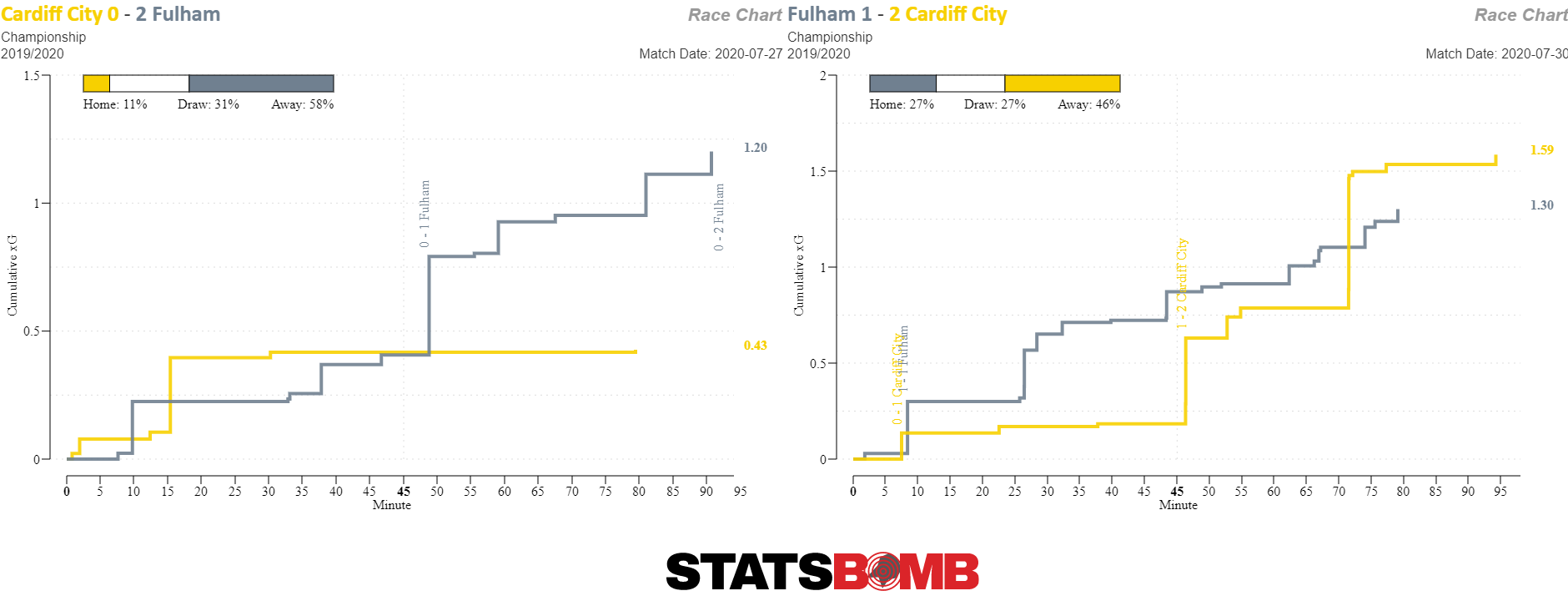 It was a similar story in the final. Fulham focused less on retaining the ball and more on preventing Brentford, and particularly Saïd Benrahma, from playing, staying in a more compact shape than usual but more importantly selecting the more energetic Bobby Reid ahead of Championship top goalscorer Aleksandar Mitrović in order to give them more mobility in leading the press and more pace on the counter. The result was an even game with the deadlock only broken by a moment of individual quality which I’m almost certain you’ll have seen if you’re reading this,
It was a similar story in the final. Fulham focused less on retaining the ball and more on preventing Brentford, and particularly Saïd Benrahma, from playing, staying in a more compact shape than usual but more importantly selecting the more energetic Bobby Reid ahead of Championship top goalscorer Aleksandar Mitrović in order to give them more mobility in leading the press and more pace on the counter. The result was an even game with the deadlock only broken by a moment of individual quality which I’m almost certain you’ll have seen if you’re reading this, 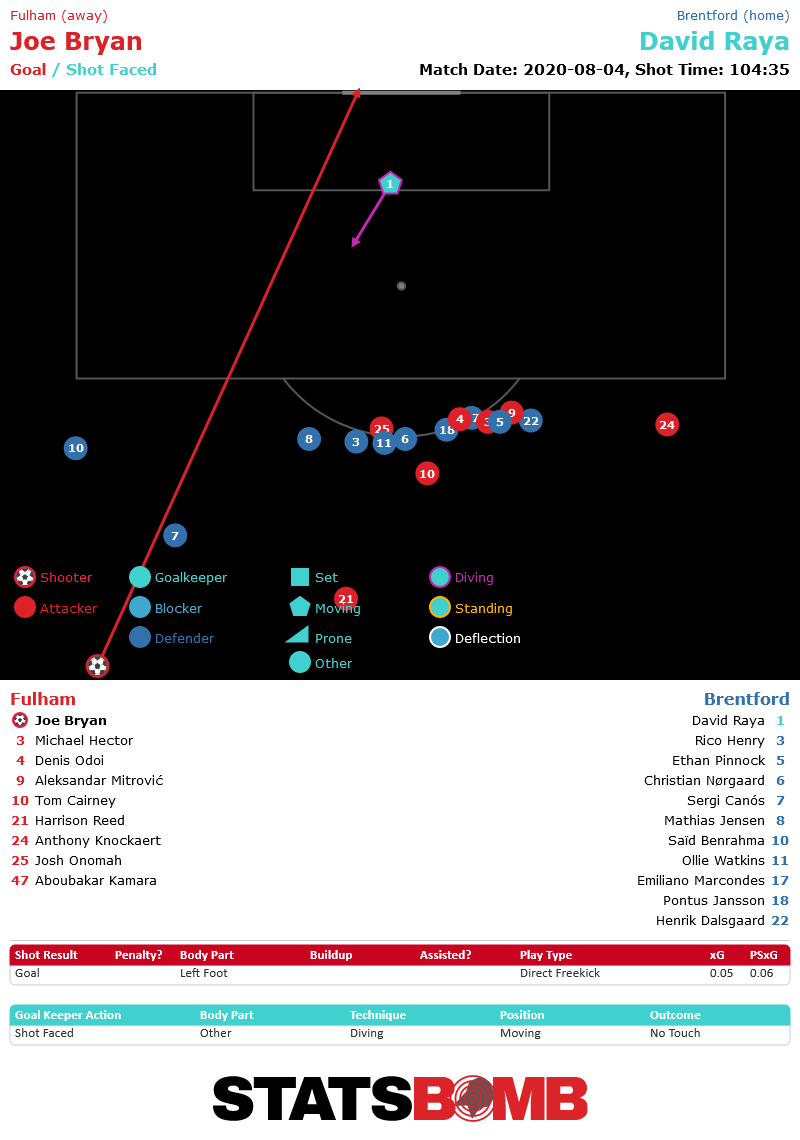 Fulham successfully negotiated the three games that their promotion depended on without riding their luck at any point during. Therefore, it’s undeniable that they did deserve their promotion, right? Let’s start to look forward now. It’s worth considering that Parker’s pragmatism, though not advisable when a big favourite with a talent advantage in a smaller league, does at least leave them better prepared to adjust to the Premier League than they were last time out. Although those attacking transitions will most certainly need to speed up. On that note, the signing of Mario Lemina from Southampton could help if he can replicate the form shown on the south coast that saw him mooted as a potential replacement for Mousa Dembélé at Tottenham. Lemina was flagged by StatsBomb’s own Euan Dewar when he
Fulham successfully negotiated the three games that their promotion depended on without riding their luck at any point during. Therefore, it’s undeniable that they did deserve their promotion, right? Let’s start to look forward now. It’s worth considering that Parker’s pragmatism, though not advisable when a big favourite with a talent advantage in a smaller league, does at least leave them better prepared to adjust to the Premier League than they were last time out. Although those attacking transitions will most certainly need to speed up. On that note, the signing of Mario Lemina from Southampton could help if he can replicate the form shown on the south coast that saw him mooted as a potential replacement for Mousa Dembélé at Tottenham. Lemina was flagged by StatsBomb’s own Euan Dewar when he 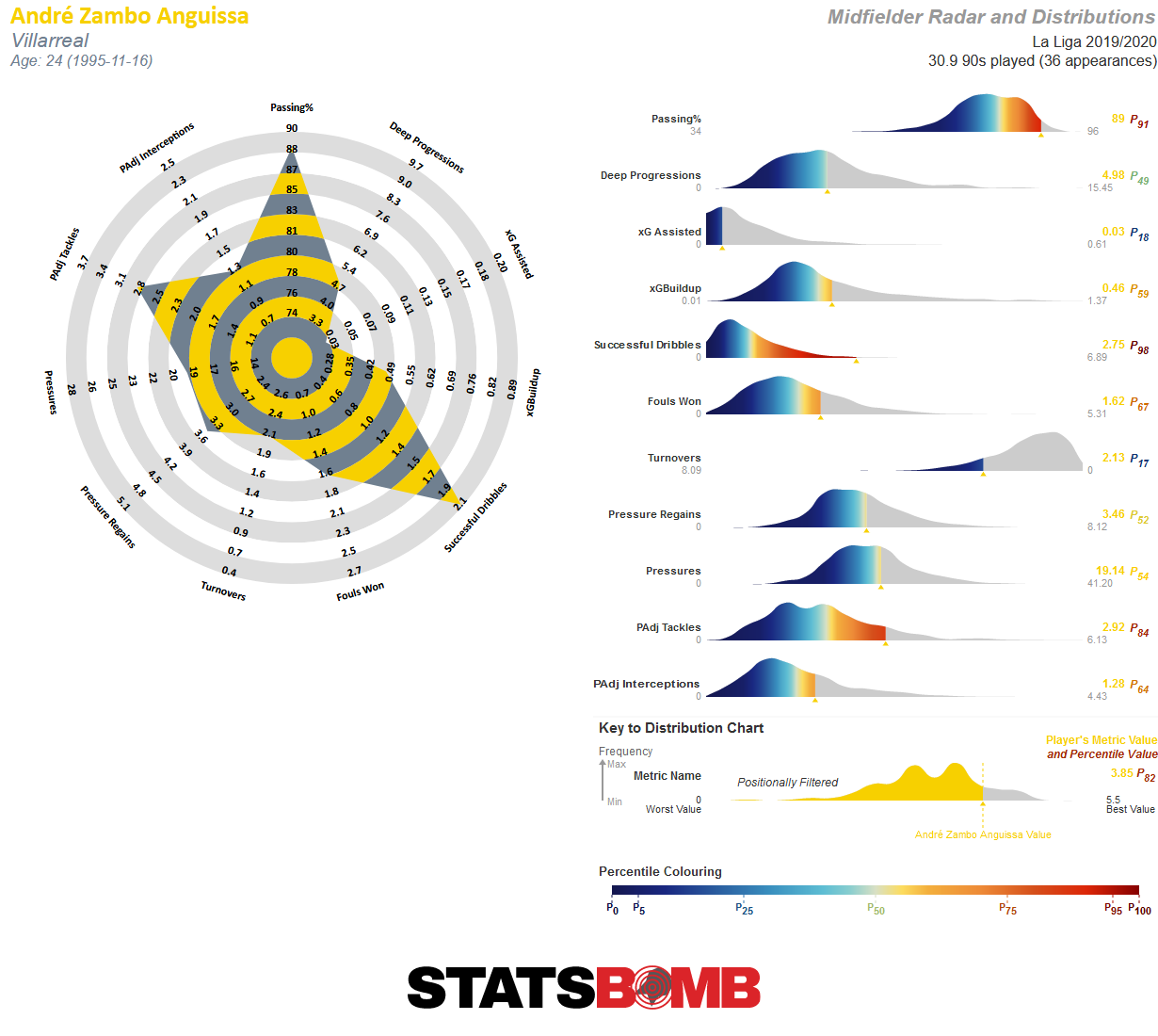 Anguissa was part of the infamous £100million spend that summer, but comparisons between that window and this are scarce. There were some domestic signings back then but the vast majority were brought in from overseas and with no experience of English football. This time, Fulham’s business has so far focused entirely on the domestic market and with smaller sums being exchanged: the only (soon to be confirmed) signing from overseas has been that of wing back Ola Aina who’s spent the last two seasons with Torino in Serie A but moved there from Chelsea. Of the business that remains to be done, there are concerns over Fulham’s reliance on 26-goal Mitrović, who was given very little help in the goalscoring department last season. He’ll be the main man again and has proven he can be counted on for some contribution at Premier League level, but more needs to come from the support acts out wide. Ivan Cavaleiro and Anthony Knockaert notched just nine goals between them last season and given the unlikelihood that Mitrović reaches another double-dozen, they’ll need to step up.
Anguissa was part of the infamous £100million spend that summer, but comparisons between that window and this are scarce. There were some domestic signings back then but the vast majority were brought in from overseas and with no experience of English football. This time, Fulham’s business has so far focused entirely on the domestic market and with smaller sums being exchanged: the only (soon to be confirmed) signing from overseas has been that of wing back Ola Aina who’s spent the last two seasons with Torino in Serie A but moved there from Chelsea. Of the business that remains to be done, there are concerns over Fulham’s reliance on 26-goal Mitrović, who was given very little help in the goalscoring department last season. He’ll be the main man again and has proven he can be counted on for some contribution at Premier League level, but more needs to come from the support acts out wide. Ivan Cavaleiro and Anthony Knockaert notched just nine goals between them last season and given the unlikelihood that Mitrović reaches another double-dozen, they’ll need to step up. 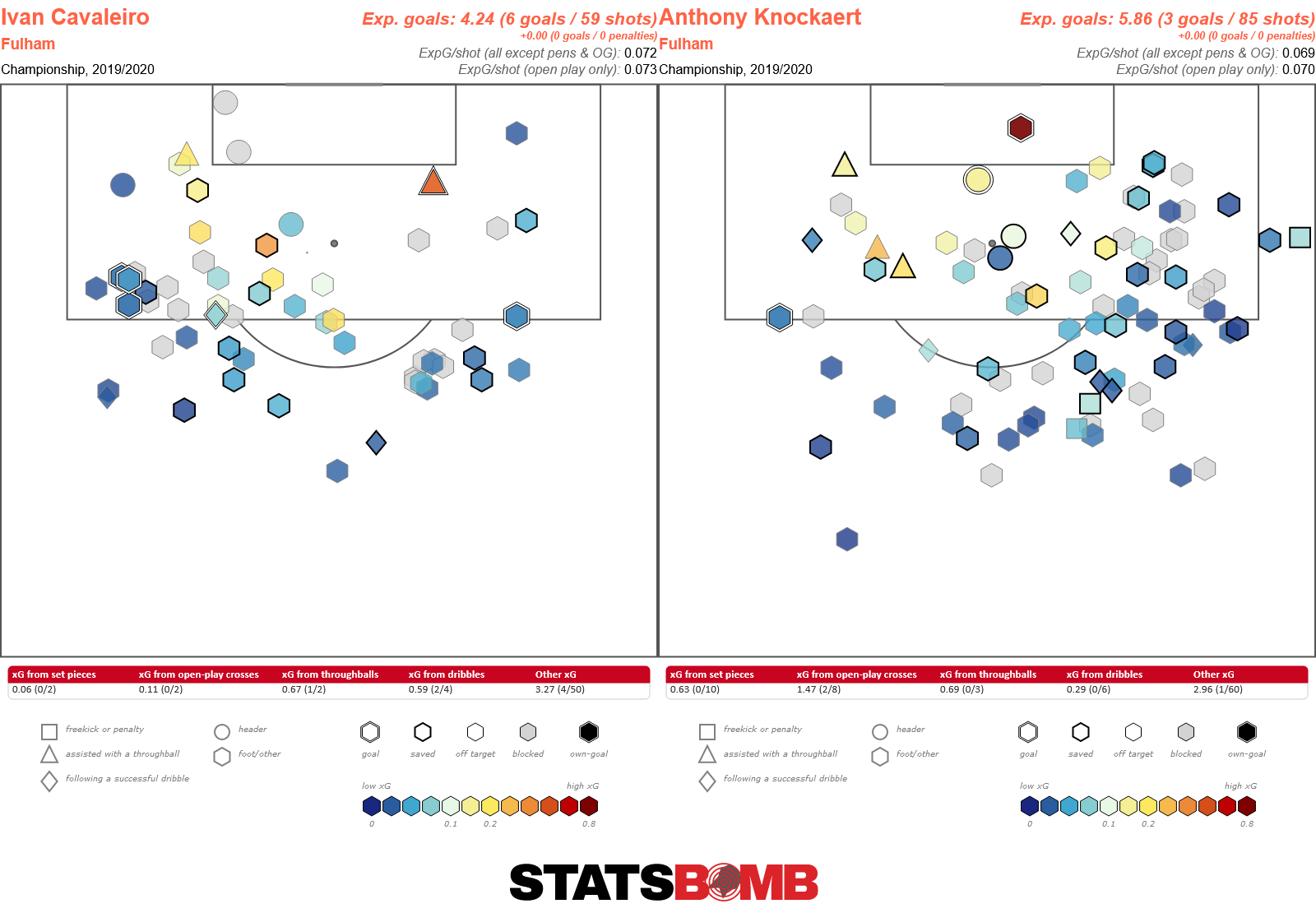 In a weird flip, Fulham could be coming into this season as a perceivably and demonstrably worse side than the one that was promoted last time out but at the same time one that’s better prepared and suited for the challenge that’s ahead of them thanks to a risk-averse manager and more settled squad. Expectations amongst the fanbase are also lower due to the manner of promotion and tighter transfer spending. Critiqued for much of last season but with a bit more credit in the bank after promotion, it’ll be interesting to see how much patience Parker gets should things not go to plan straight away. Joint relegation favourites with West Brom seems a fair assessment.
In a weird flip, Fulham could be coming into this season as a perceivably and demonstrably worse side than the one that was promoted last time out but at the same time one that’s better prepared and suited for the challenge that’s ahead of them thanks to a risk-averse manager and more settled squad. Expectations amongst the fanbase are also lower due to the manner of promotion and tighter transfer spending. Critiqued for much of last season but with a bit more credit in the bank after promotion, it’ll be interesting to see how much patience Parker gets should things not go to plan straight away. Joint relegation favourites with West Brom seems a fair assessment. 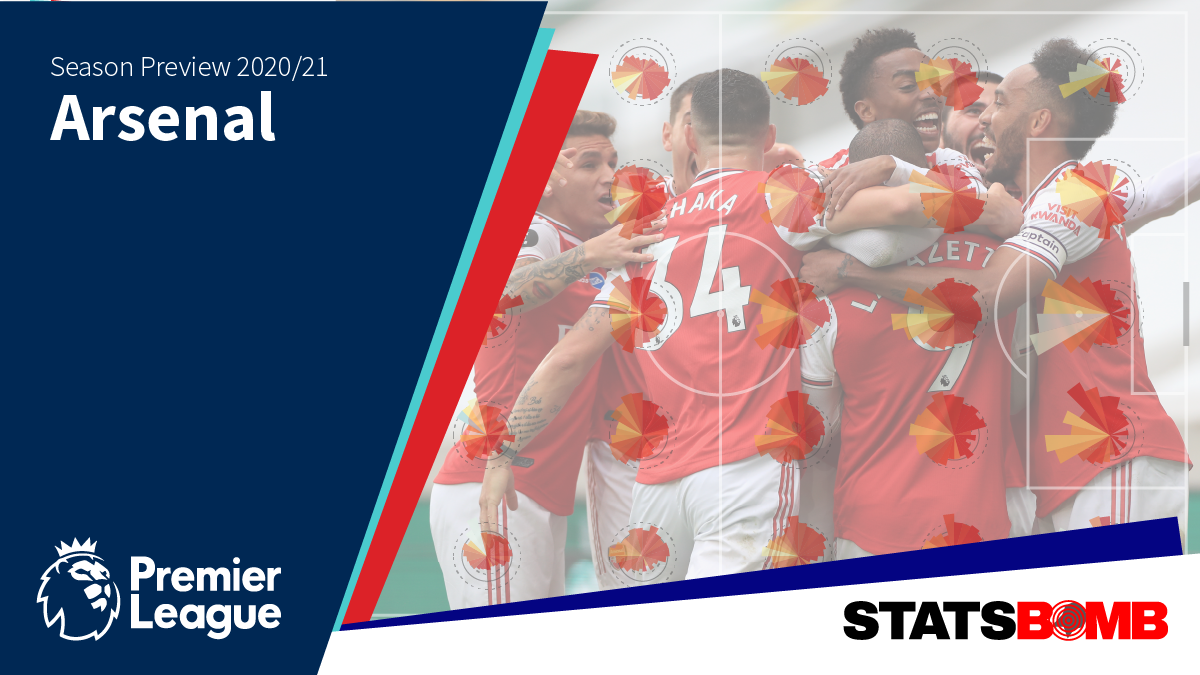
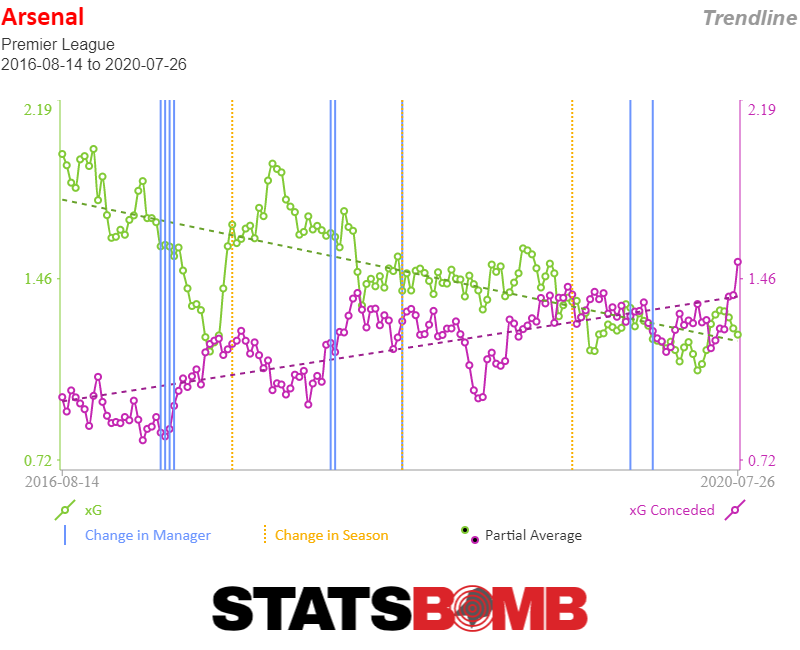
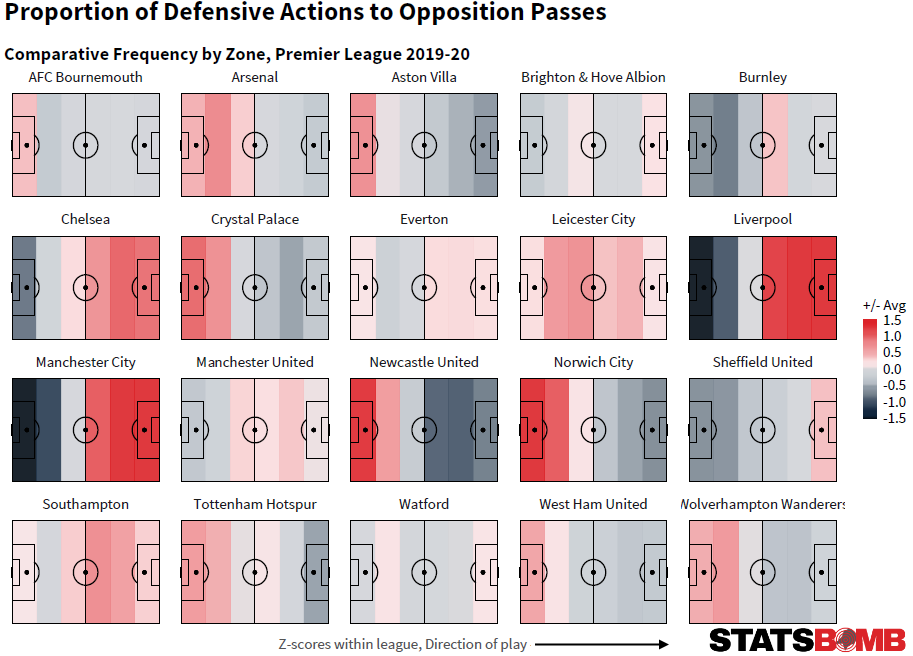
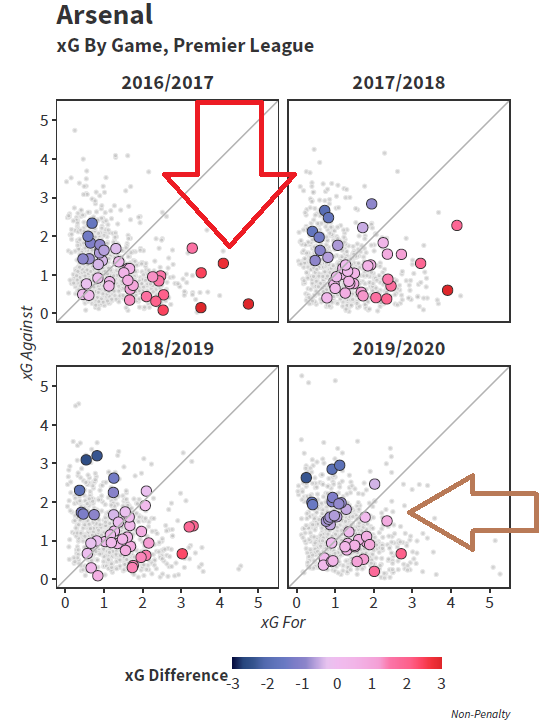
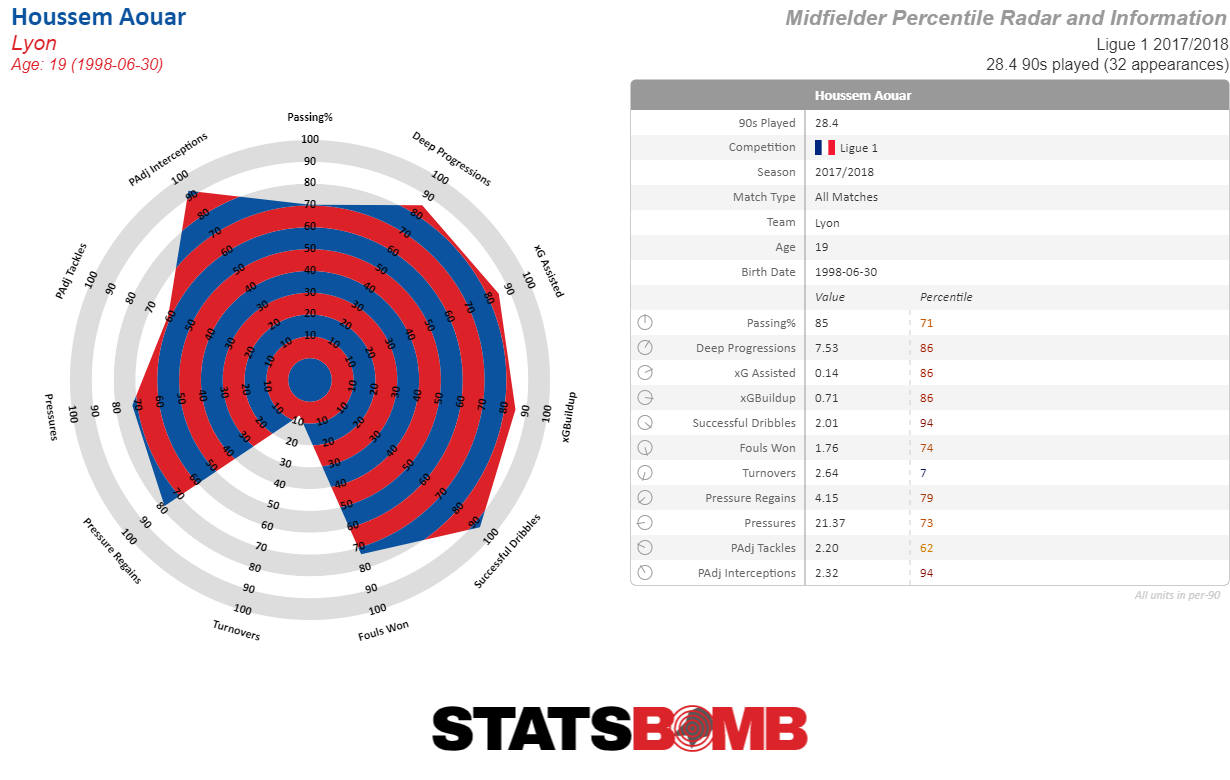
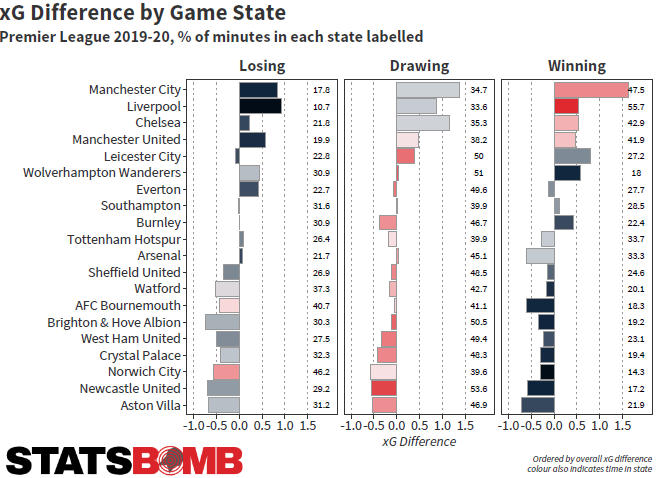

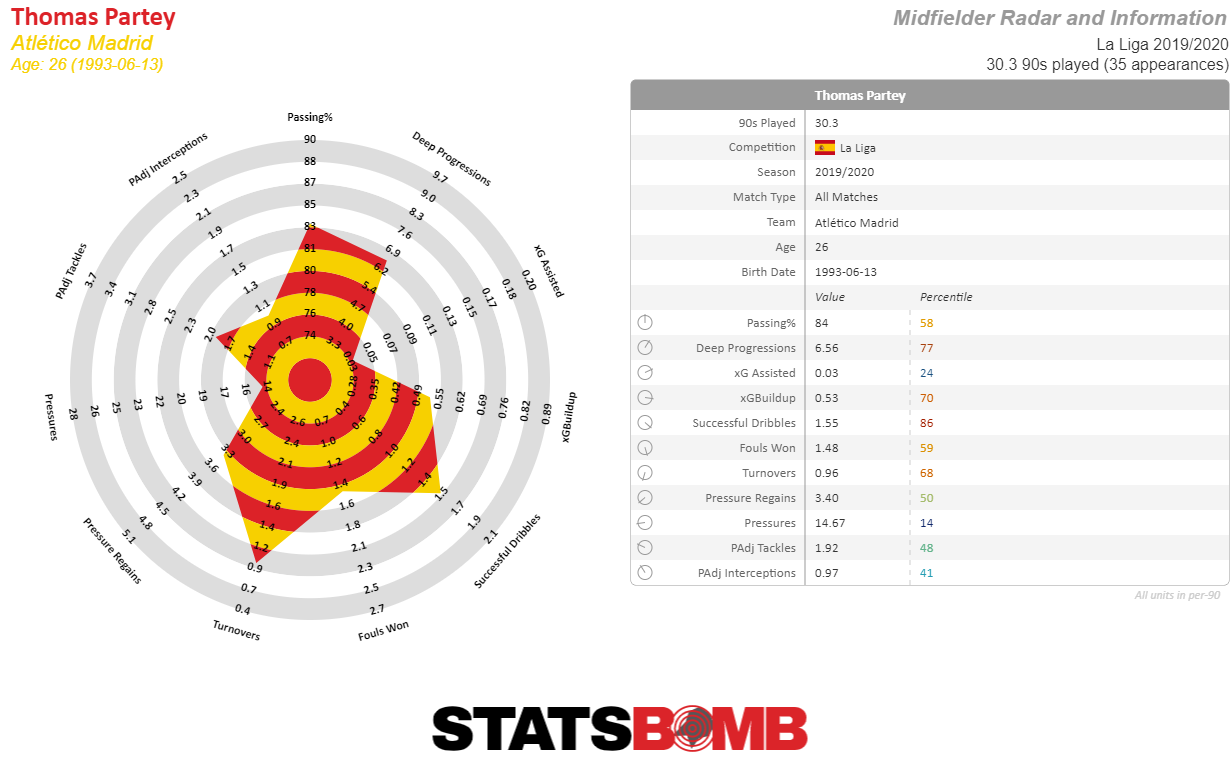
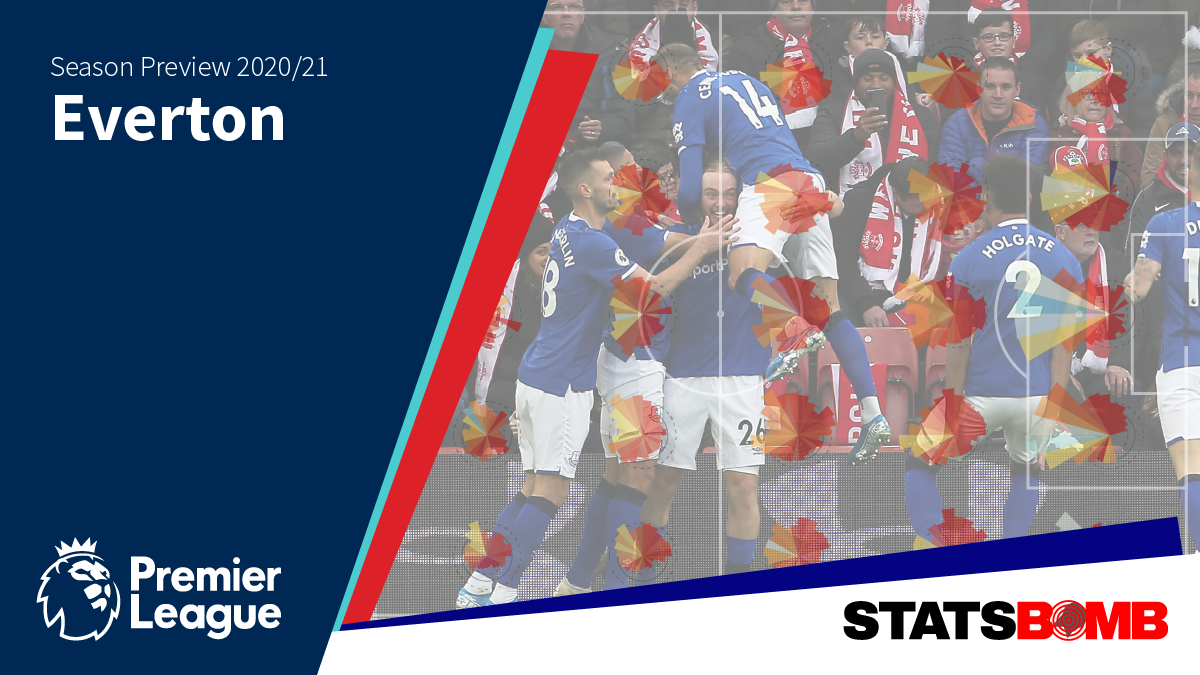
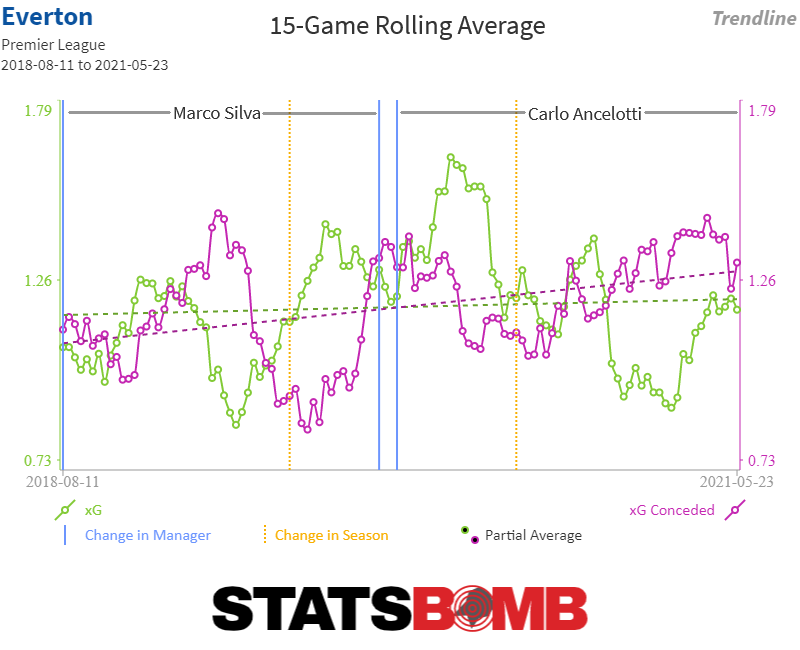 The first stretch for Marco Silva involved a big skew where results failed to overcome declining expected numbers, which ultimately did for him. The period that Ancelotti oversaw from late December to the Covid break was genuinely good: a 5-3-3 record was scant reward for third best in the league expected metrics (+0.7xG per game vs a flat, zero actual goal difference). Then in the New World, metrics declined, in particular in attack. The positive read of all this is that the good Ancelotti period was extremely promising. The negative read is more a question of why couldn’t they get anywhere near those heights in June and July? It’s fundamentally erroneous to draw lines based on player participation, so I will not point out that Fabian Delph started a lot of games in the good period and Andre Gomes played more in the bad. The whole before/after Covid break dichotomy is an added layer that makes projecting teams in 2020-21 an ever more hazardous procedure and it would not be surprising if a variety of teams played out the season with half an eye on the autumn and this restart. Personnel Everton have been far from shy in the transfer market in recent seasons, and their recruitment has had a mixed outcome. Marcel Brands was tasked with emerging from the weight that Steve Walsh’s tenure left on the club’s roster, and has made some pointed and valuable moves. Richarlison remains a certain hit, Lucas Digne has grown into one of the better two-way full backs in the league and while Delph isn’t one for the future, he was a relatively cheap and experienced player to slot into the midfield. Elsewhere, Andre Gomes remains elegant on the ball, but probably needs to be less elegant off the ball. Moise Kean is still very young and without the yips (two goals from over four xG) might have raised more eyebrows in first season from which he emerged from the bench most frequently, while Alex Iwobi needs to get back his creative boots if he’s going to continue to mini-Özil his way through life and scarcely shoot. On paper, at least, Jean-Philippe Gbamin was the answer to some of Everton’s issues around their midfield, but the poor guy is already out til 2021 and has undergone his third operation in a luckless run at the club. With a surfeit of centre forwards and winger types on the books, and mixed impact and bad luck in midfield, it's straightforward to identify where to strengthen, and Everton have followed that obvious route. Allan was the first through the door, a veteran of Ancelotti's Napoli tenure and a player who who has long provided great energy from midfield:
The first stretch for Marco Silva involved a big skew where results failed to overcome declining expected numbers, which ultimately did for him. The period that Ancelotti oversaw from late December to the Covid break was genuinely good: a 5-3-3 record was scant reward for third best in the league expected metrics (+0.7xG per game vs a flat, zero actual goal difference). Then in the New World, metrics declined, in particular in attack. The positive read of all this is that the good Ancelotti period was extremely promising. The negative read is more a question of why couldn’t they get anywhere near those heights in June and July? It’s fundamentally erroneous to draw lines based on player participation, so I will not point out that Fabian Delph started a lot of games in the good period and Andre Gomes played more in the bad. The whole before/after Covid break dichotomy is an added layer that makes projecting teams in 2020-21 an ever more hazardous procedure and it would not be surprising if a variety of teams played out the season with half an eye on the autumn and this restart. Personnel Everton have been far from shy in the transfer market in recent seasons, and their recruitment has had a mixed outcome. Marcel Brands was tasked with emerging from the weight that Steve Walsh’s tenure left on the club’s roster, and has made some pointed and valuable moves. Richarlison remains a certain hit, Lucas Digne has grown into one of the better two-way full backs in the league and while Delph isn’t one for the future, he was a relatively cheap and experienced player to slot into the midfield. Elsewhere, Andre Gomes remains elegant on the ball, but probably needs to be less elegant off the ball. Moise Kean is still very young and without the yips (two goals from over four xG) might have raised more eyebrows in first season from which he emerged from the bench most frequently, while Alex Iwobi needs to get back his creative boots if he’s going to continue to mini-Özil his way through life and scarcely shoot. On paper, at least, Jean-Philippe Gbamin was the answer to some of Everton’s issues around their midfield, but the poor guy is already out til 2021 and has undergone his third operation in a luckless run at the club. With a surfeit of centre forwards and winger types on the books, and mixed impact and bad luck in midfield, it's straightforward to identify where to strengthen, and Everton have followed that obvious route. Allan was the first through the door, a veteran of Ancelotti's Napoli tenure and a player who who has long provided great energy from midfield: 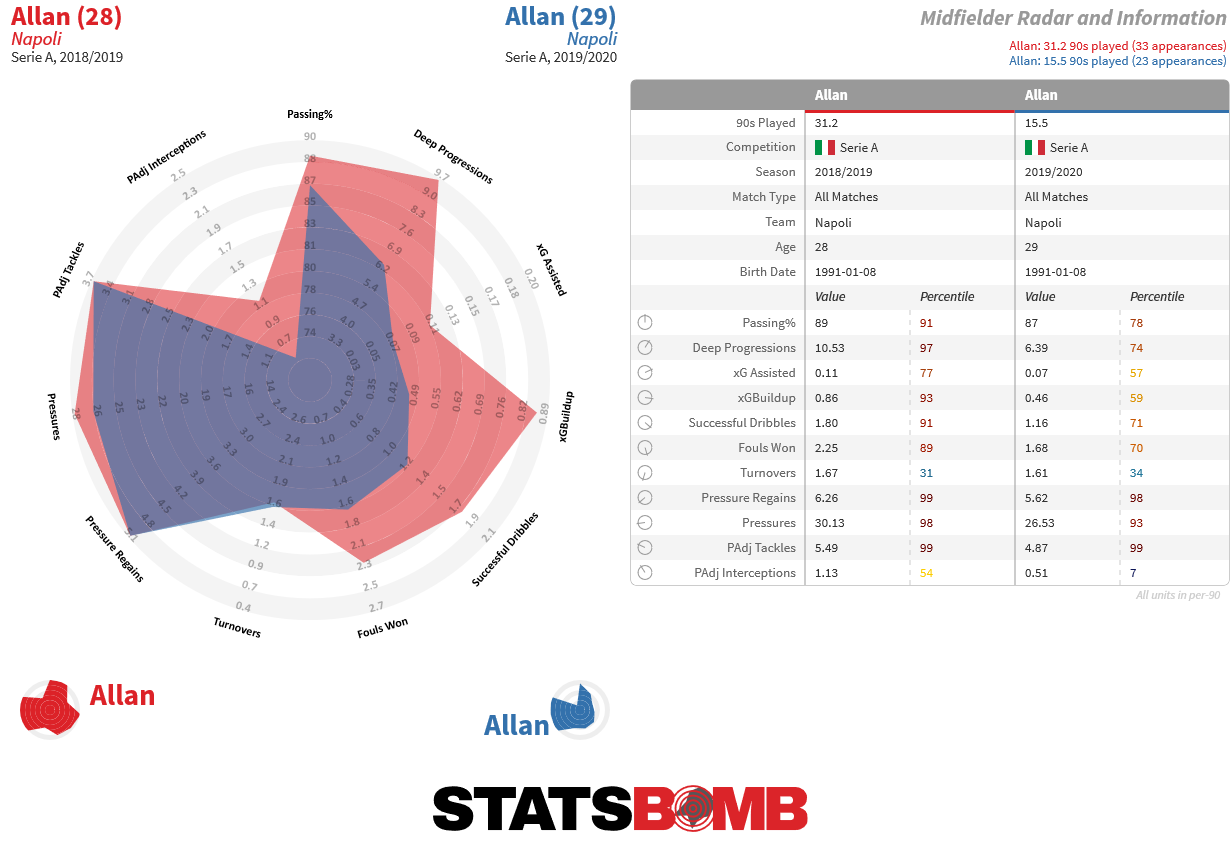 We can see here that 2019-20 under Gennaro Gattuso saw his on the ball metrics drop back, while he maintained extremely high pressure metrics. To be fair, his season was stop-start with niggling injuries and time on the bench impacting his overall game time. There is an understandable degree of caution in that he's soon to turn 30 years old, and the hope here has to be that he can continue to contribute at levels seen prior to last season. However for his stylistic profile, the balance between "he is a great player" and "he is at the wrong end of the age curve" is impossible to deny. Age queries are also something that can be aimed at James Rodriguez, who looks likely to join up this week too. As a former Galactico of sorts, his pedigree is undeniable, and as a creative, flair player, concerns about his residual quality and reliability as he ages are perhaps less than that of Allan. It's really not that long since he was at Bayern putting together a profile like this:
We can see here that 2019-20 under Gennaro Gattuso saw his on the ball metrics drop back, while he maintained extremely high pressure metrics. To be fair, his season was stop-start with niggling injuries and time on the bench impacting his overall game time. There is an understandable degree of caution in that he's soon to turn 30 years old, and the hope here has to be that he can continue to contribute at levels seen prior to last season. However for his stylistic profile, the balance between "he is a great player" and "he is at the wrong end of the age curve" is impossible to deny. Age queries are also something that can be aimed at James Rodriguez, who looks likely to join up this week too. As a former Galactico of sorts, his pedigree is undeniable, and as a creative, flair player, concerns about his residual quality and reliability as he ages are perhaps less than that of Allan. It's really not that long since he was at Bayern putting together a profile like this: 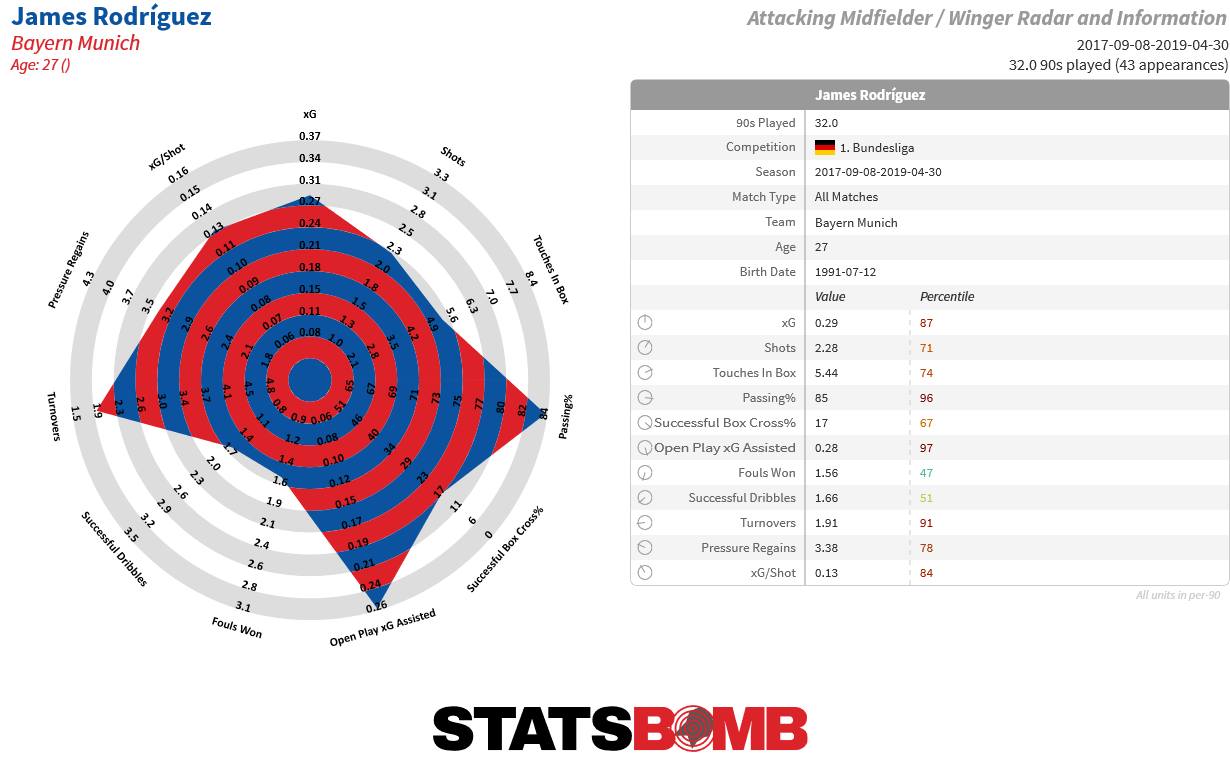 Dominic Calvert-Lewin and Richarlison will undoubtedly be thrilled to see a world class creator teeing up set pieces and throughballs for them. The upgrade here versus Gylfi Sigurðsson is nothing short of huge. The warning when Sigurðsson signed for Everton was that so much of his shot creation was inhabited within set pieces. He got 12 assists for Swansea in 2016-17 and only four were from open play. His actual key pass rate was a shade over 0.5 per game which is miniscule for any nominally creative player. His seasons at Everton have seen this rate broach one per 90 only once (1.03 in 2018-19) and he was back at below 0.5 in 2019-20. James gives you at least as much as Sigurðsson from set-pieces while adding elite open play shot creation numbers on top, reliably over two per game. This difference is shown amply by James' open play key pass chart at Bayern vs that of Sigurðsson last season for Everton. Even allowing for difference of quality in team-mate, the variation is stark and by any stretch, James as an upgrade is hugely enticing. He's also two years younger:
Dominic Calvert-Lewin and Richarlison will undoubtedly be thrilled to see a world class creator teeing up set pieces and throughballs for them. The upgrade here versus Gylfi Sigurðsson is nothing short of huge. The warning when Sigurðsson signed for Everton was that so much of his shot creation was inhabited within set pieces. He got 12 assists for Swansea in 2016-17 and only four were from open play. His actual key pass rate was a shade over 0.5 per game which is miniscule for any nominally creative player. His seasons at Everton have seen this rate broach one per 90 only once (1.03 in 2018-19) and he was back at below 0.5 in 2019-20. James gives you at least as much as Sigurðsson from set-pieces while adding elite open play shot creation numbers on top, reliably over two per game. This difference is shown amply by James' open play key pass chart at Bayern vs that of Sigurðsson last season for Everton. Even allowing for difference of quality in team-mate, the variation is stark and by any stretch, James as an upgrade is hugely enticing. He's also two years younger: 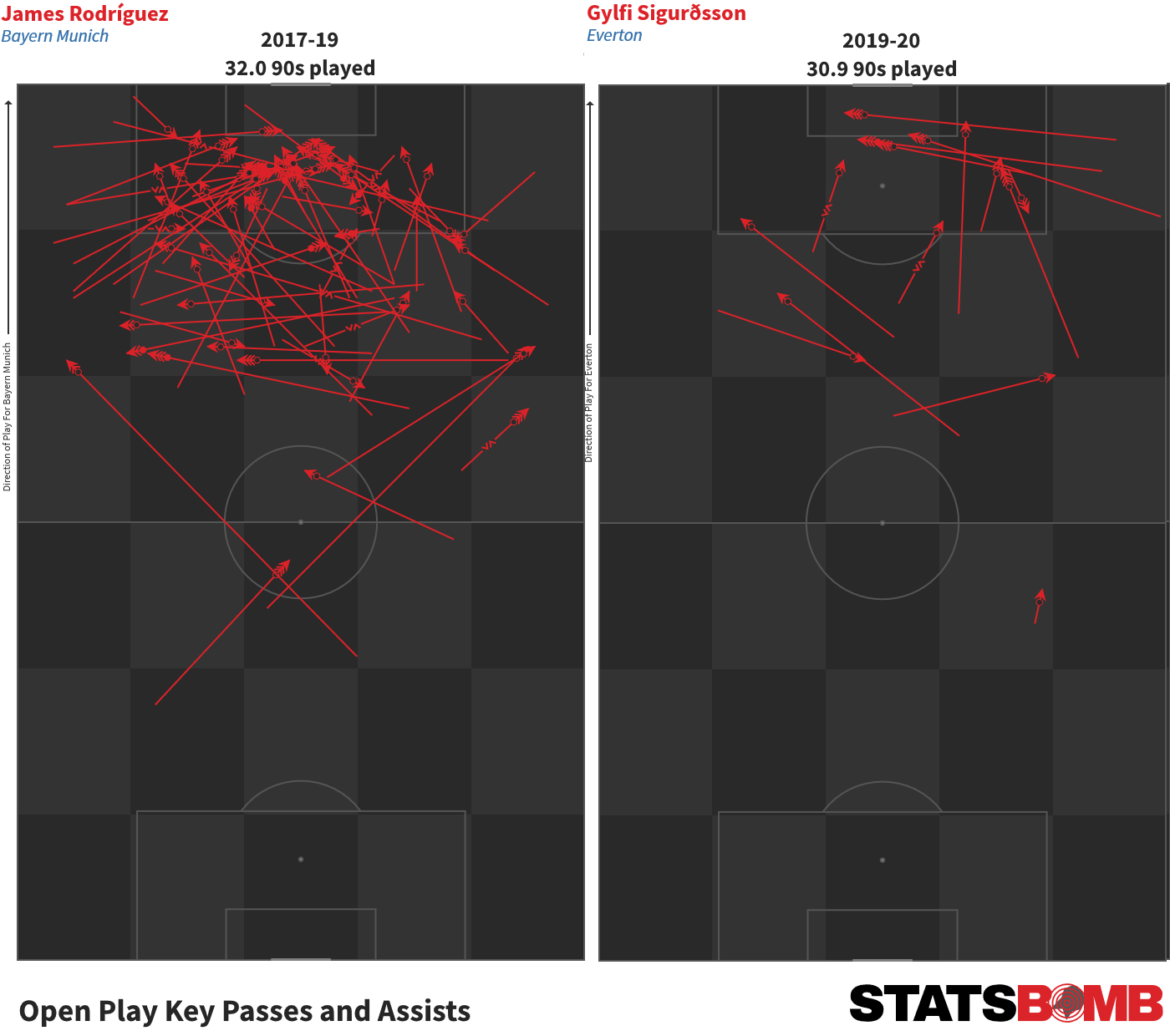 James also has experience under Ancelotti for a brief period during their time at Bayern Munich, so there could well be some benefit from these high quality players being able to join up, and quickly drop in to the team. Do Allan's legs allow James to create with some impunity? Perhaps so, but undeniably, their recruitment improves Everton in an area they were likely weakest and certainly makes the short term likelihood of Everton raising their floor very real. Given erratic game time for each in recent times, it will be interesting to see how frequently they feature and how frequently Everton get a full shift from them. As much as queries around contracting players into their 30s will persist, getting Everton's first 11 onto the pitch reliably will have a large impact on outcomes. It's also looking as though Abdoulaye Doucouré will be joining from Watford. As an aside a quick glace at the squad makes me feel a little more full back depth could go a long way. Projection What is success for this team this season? Everton have invested in players at a cost that demands a challenge to the top six. At times it has felt as though each new manager and season has been treated as a blank canvas, and the residual squad members from previous regimes have been hard to move on. Everton need to find a way to move on from that cycle, and on balance, enough of their more recent recruitment in the Marcel Brands era has created a team that at its core has the makings of a prosperous side. Very little more needs to go right to regain a slot in the eternal seventh to tenth zone that Everton frequently occupy, but a big impact from their new recruits could steer them upwards. Sporting Index opened up with a ninth placed 52-53 point estimation and that may be a low base, considering what we know about 2019-20 and the Ancelotti era. As discussed, his actual point accrual rate was about five points ahead of that and a further handful of points probably gets you to the top six mix. Maximising outcome is Ancelotti's challenge. He needs to get close to the top six for 2020-21 to be deemed successful. The form of the team was concerning during the restart, but it can be hoped that the planning was orientated towards this season instead. Teams that understand the brutal schedule and plan to adapt will be set-up to fare best in 2020-21 and there is an opportunity here for those that do. Everton do have a large squad too. If Ancelotti can't manage to point this team upwards, further change in management and personnel may be in the offing, and the cycle could recur.
James also has experience under Ancelotti for a brief period during their time at Bayern Munich, so there could well be some benefit from these high quality players being able to join up, and quickly drop in to the team. Do Allan's legs allow James to create with some impunity? Perhaps so, but undeniably, their recruitment improves Everton in an area they were likely weakest and certainly makes the short term likelihood of Everton raising their floor very real. Given erratic game time for each in recent times, it will be interesting to see how frequently they feature and how frequently Everton get a full shift from them. As much as queries around contracting players into their 30s will persist, getting Everton's first 11 onto the pitch reliably will have a large impact on outcomes. It's also looking as though Abdoulaye Doucouré will be joining from Watford. As an aside a quick glace at the squad makes me feel a little more full back depth could go a long way. Projection What is success for this team this season? Everton have invested in players at a cost that demands a challenge to the top six. At times it has felt as though each new manager and season has been treated as a blank canvas, and the residual squad members from previous regimes have been hard to move on. Everton need to find a way to move on from that cycle, and on balance, enough of their more recent recruitment in the Marcel Brands era has created a team that at its core has the makings of a prosperous side. Very little more needs to go right to regain a slot in the eternal seventh to tenth zone that Everton frequently occupy, but a big impact from their new recruits could steer them upwards. Sporting Index opened up with a ninth placed 52-53 point estimation and that may be a low base, considering what we know about 2019-20 and the Ancelotti era. As discussed, his actual point accrual rate was about five points ahead of that and a further handful of points probably gets you to the top six mix. Maximising outcome is Ancelotti's challenge. He needs to get close to the top six for 2020-21 to be deemed successful. The form of the team was concerning during the restart, but it can be hoped that the planning was orientated towards this season instead. Teams that understand the brutal schedule and plan to adapt will be set-up to fare best in 2020-21 and there is an opportunity here for those that do. Everton do have a large squad too. If Ancelotti can't manage to point this team upwards, further change in management and personnel may be in the offing, and the cycle could recur. 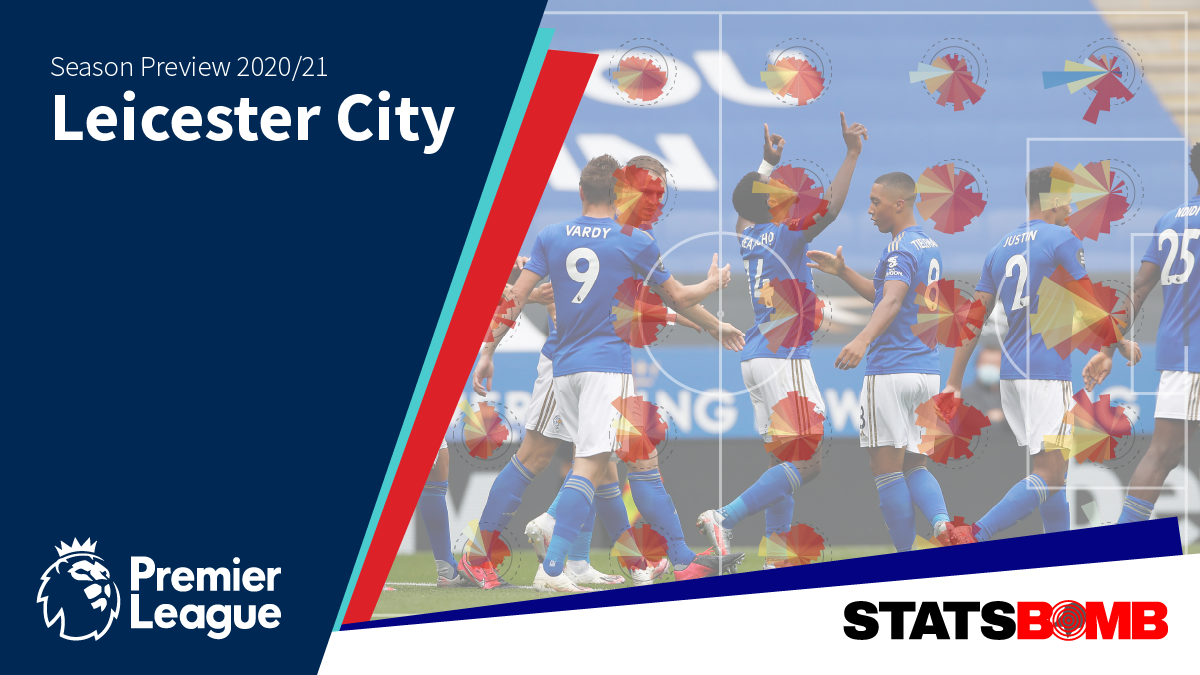
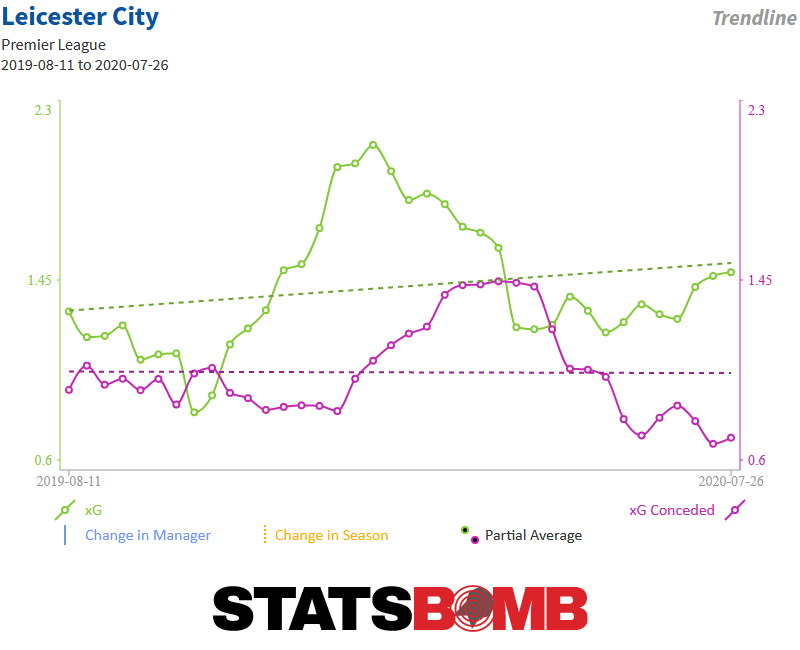
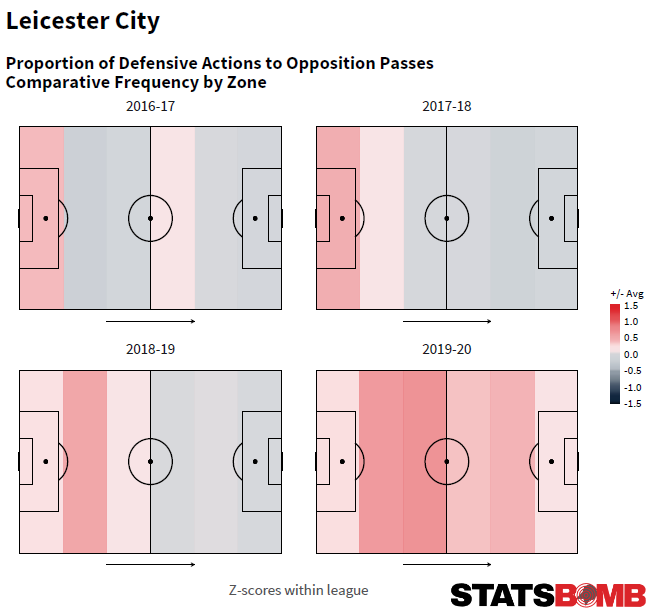
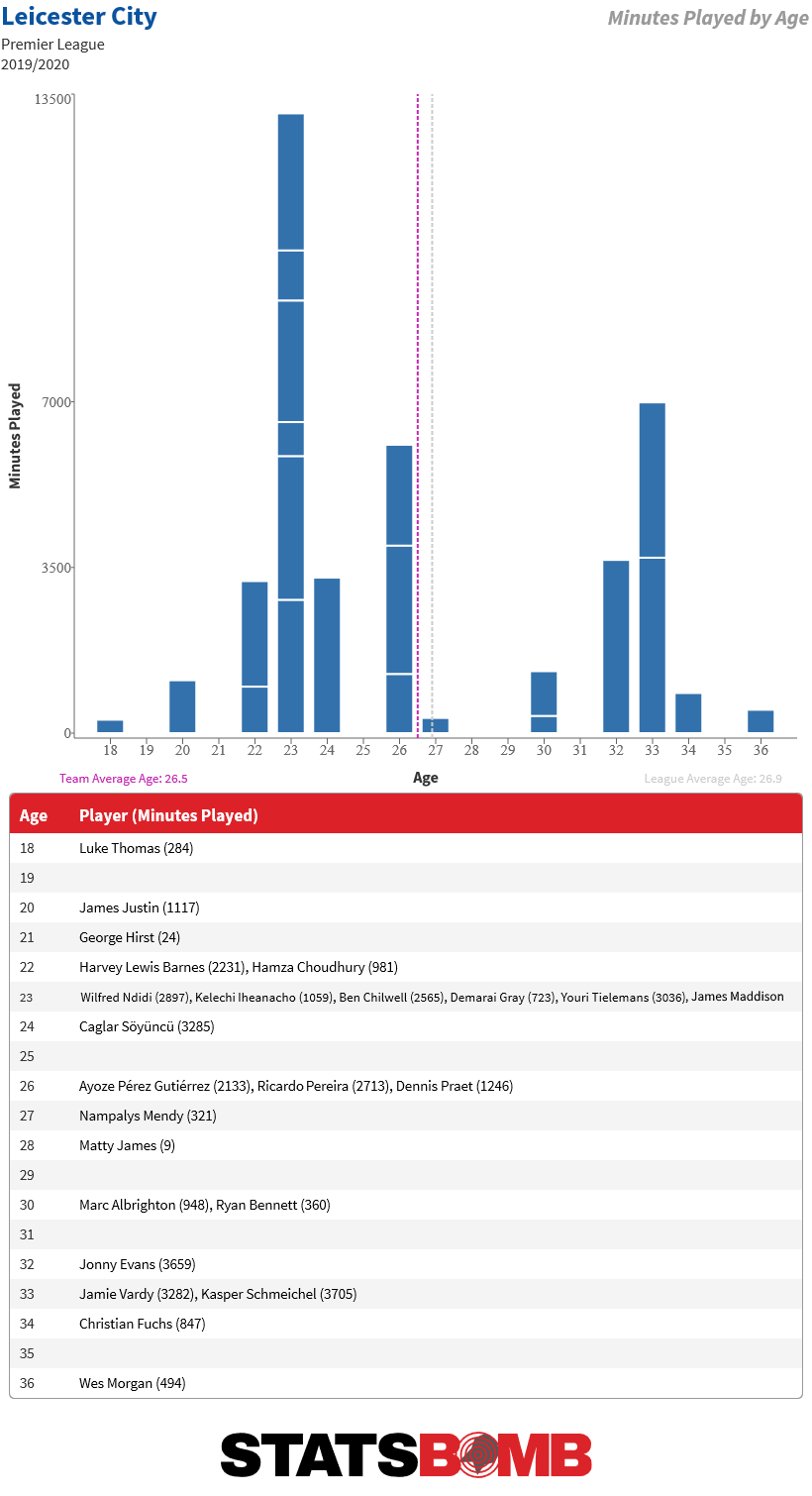
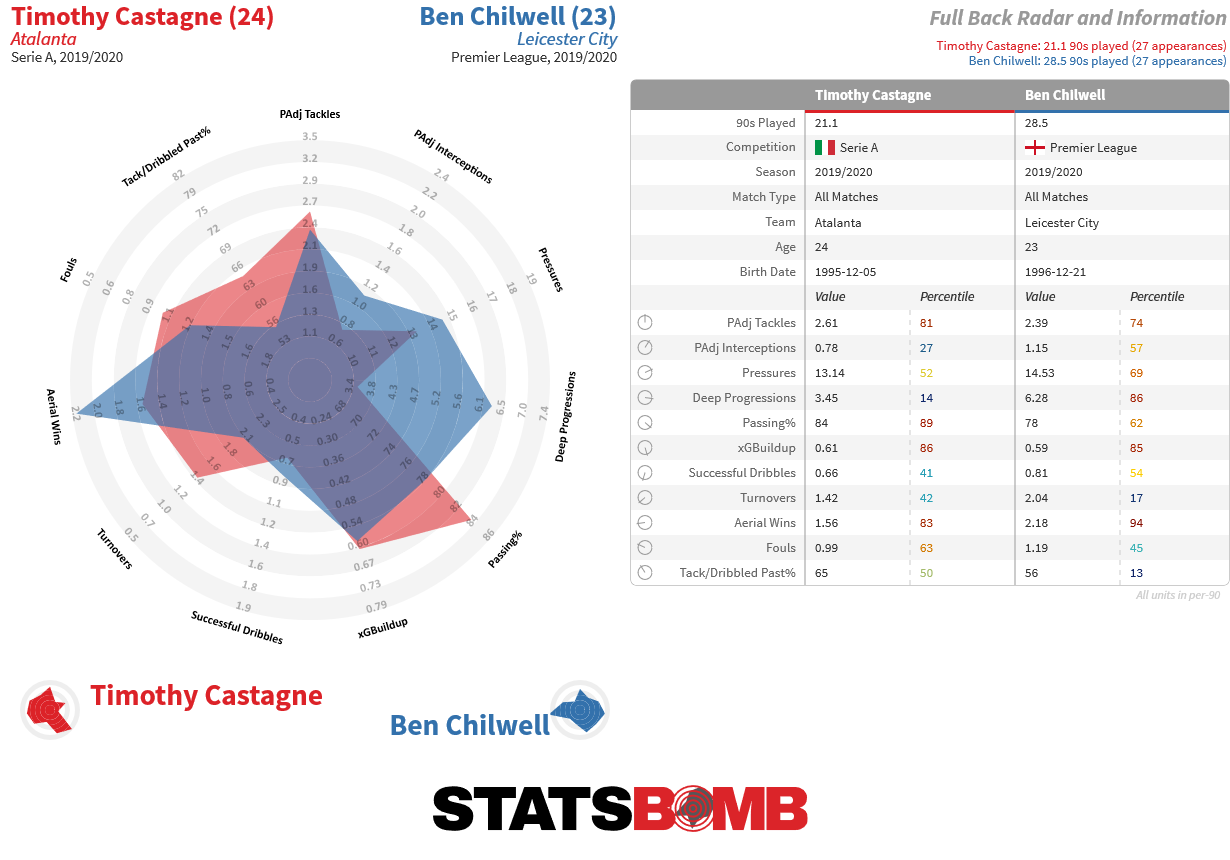
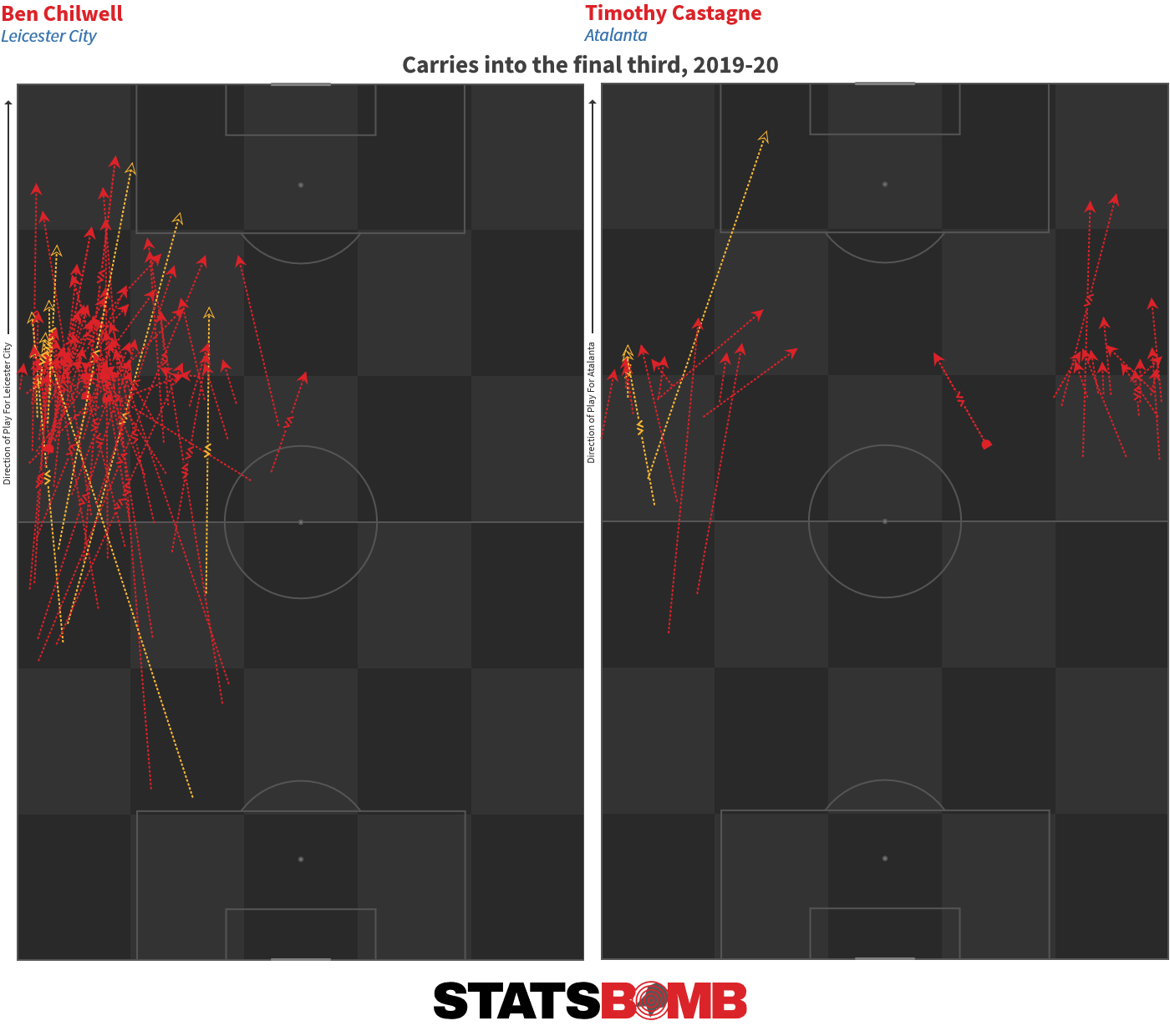
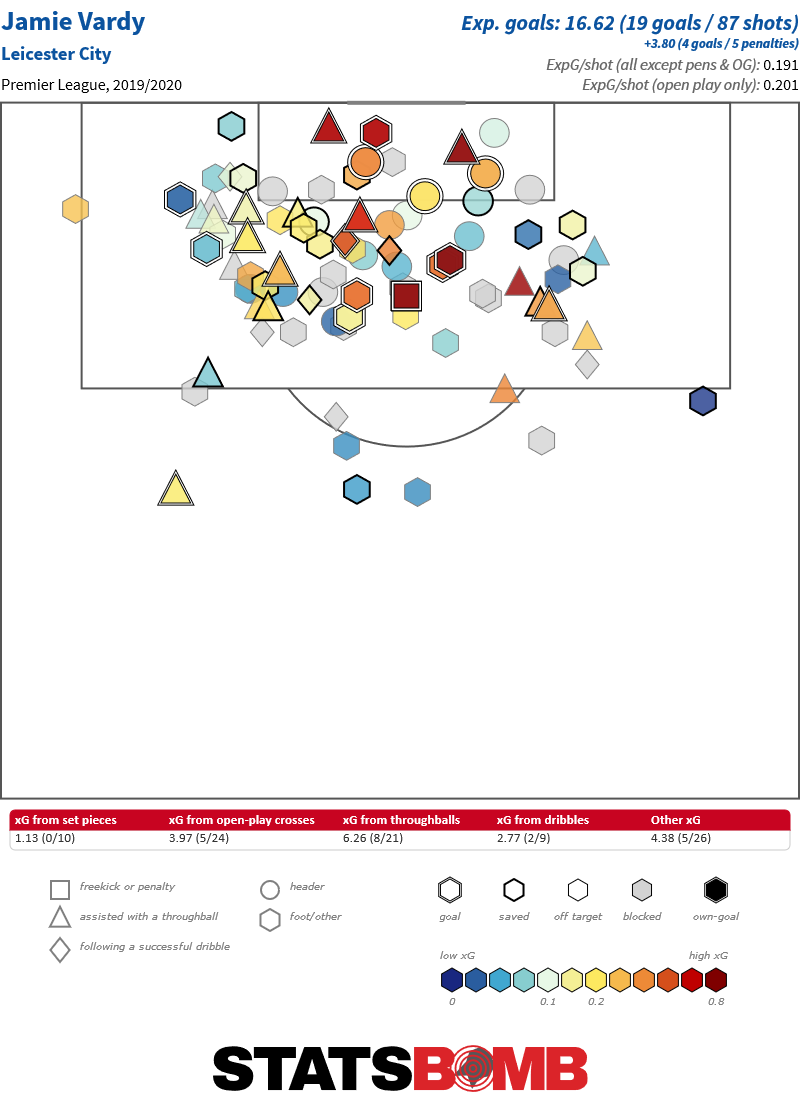
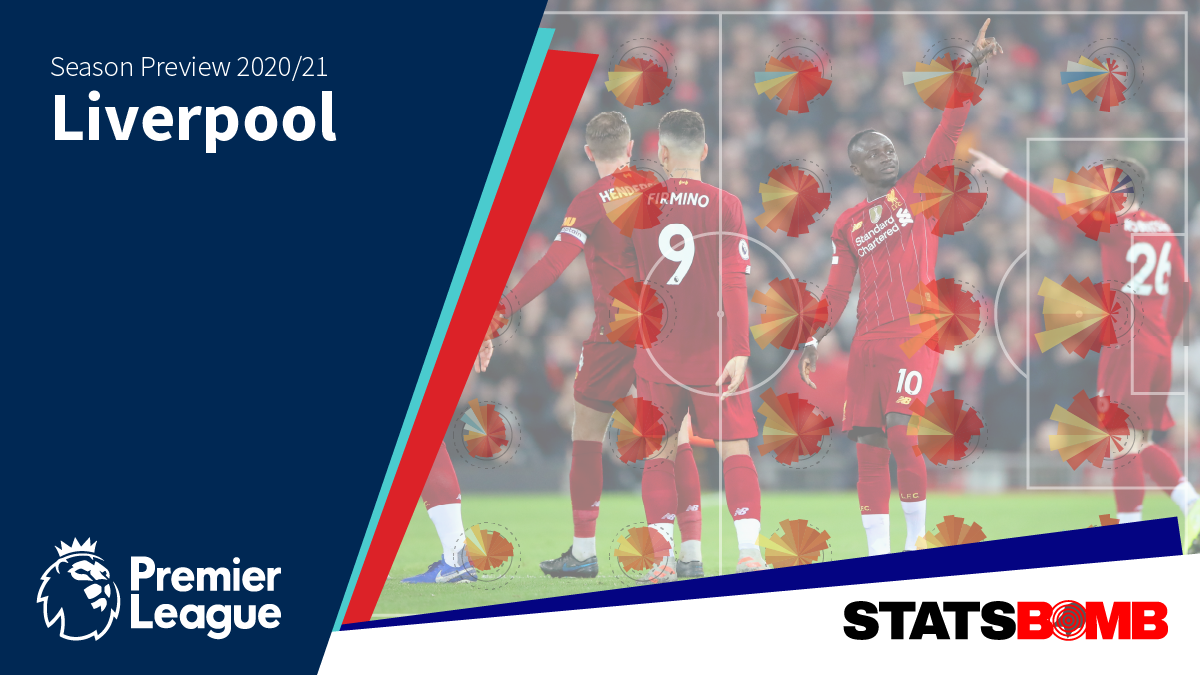
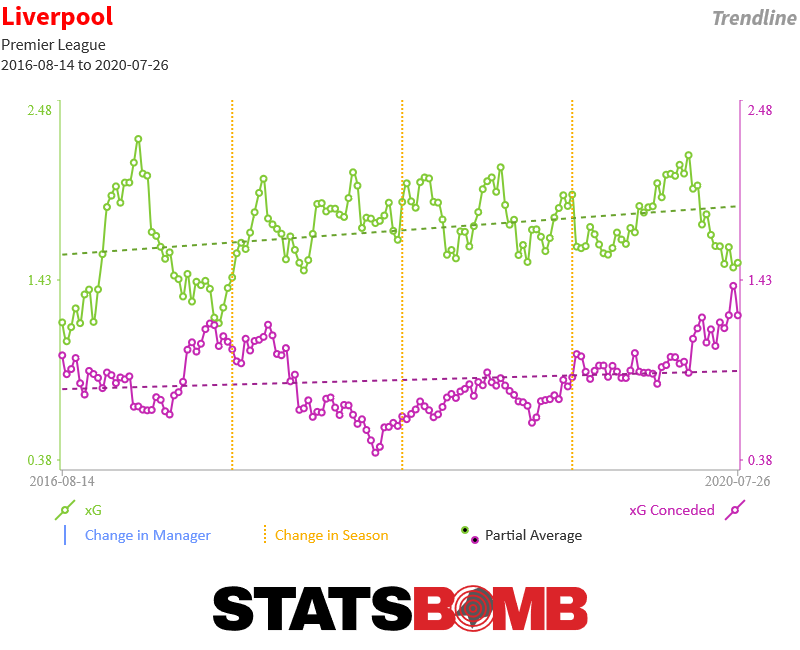
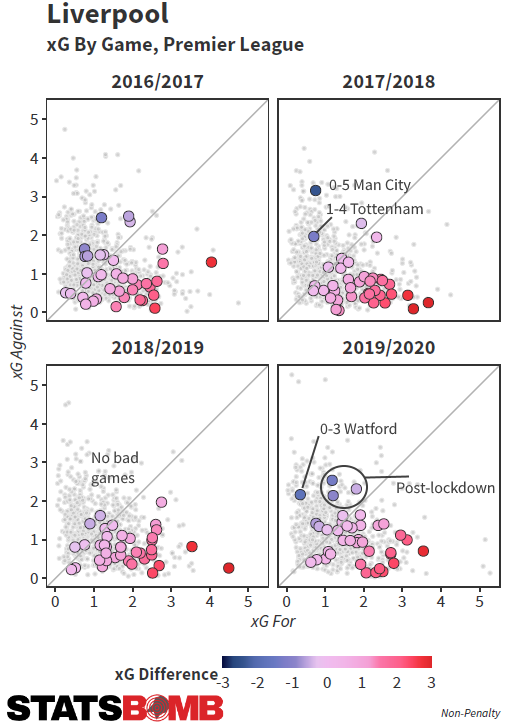 One of the main plotlines that underlies this chart is that between September 2017 and The Watford Game in February 2020, nearly two and a half years and 98 games, Liverpool did not give up more than two non-penalty expected goals in a league game. So that's the process right there; don't give up much in defence. It kicked on into reality too, as they went nearly as long without being two goals behind in a league game. This team has been so consistent for so long that the Watford game--in which they were comprehensively beaten 3-0 (2.2 vs 0.4 xG)--stands out alone in as an outlier across over 100 games. Ironically, post-Watford and post Covid break Liverpool did show vulnerability at the back and as a result "time spent behind" and "deviation from expectation while ahead" measures fell back towards more "normal" levels having been wildly out of kilter in a positive direction beforehand. Things like giving up more than two non-penalty expected goals occurred in three more games, although they won two of them (5-3 v Chelsea, 3-1 v Brighton) and only lost to Manchester City. There's not much more to be said here apart from don't make a habit of it. Personnel A quick word for Virgil Van Dijk here as he tops by a huge margin a metric I toyed with to ascertain how effective centre backs were at clearing or passing the ball out from dangerous central in-box zones:
One of the main plotlines that underlies this chart is that between September 2017 and The Watford Game in February 2020, nearly two and a half years and 98 games, Liverpool did not give up more than two non-penalty expected goals in a league game. So that's the process right there; don't give up much in defence. It kicked on into reality too, as they went nearly as long without being two goals behind in a league game. This team has been so consistent for so long that the Watford game--in which they were comprehensively beaten 3-0 (2.2 vs 0.4 xG)--stands out alone in as an outlier across over 100 games. Ironically, post-Watford and post Covid break Liverpool did show vulnerability at the back and as a result "time spent behind" and "deviation from expectation while ahead" measures fell back towards more "normal" levels having been wildly out of kilter in a positive direction beforehand. Things like giving up more than two non-penalty expected goals occurred in three more games, although they won two of them (5-3 v Chelsea, 3-1 v Brighton) and only lost to Manchester City. There's not much more to be said here apart from don't make a habit of it. Personnel A quick word for Virgil Van Dijk here as he tops by a huge margin a metric I toyed with to ascertain how effective centre backs were at clearing or passing the ball out from dangerous central in-box zones: 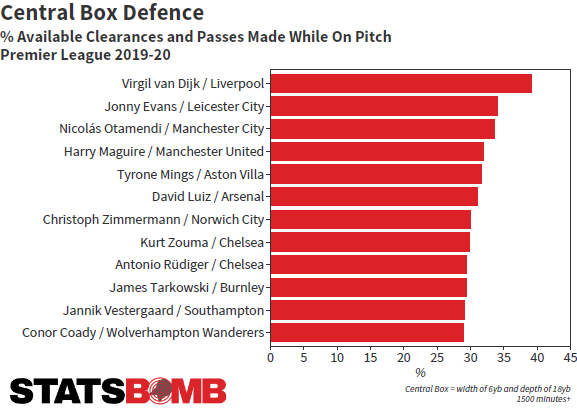 There's an interesting question around Liverpool's centre back partnerships that springs up from this. Van Dijk is evidently a dominant force within the league, but Joe Gomez is far more passive. Across two seasons his rate for this metric is around 20% (compared to Van Dijk's 35% 2018-19 and 39% in 2019-20). The now departed Dejan Lovren rated a shade higher at around 22-23% while Joel Matip was higher still at 25% and 29%. The point is that since Van Dijk arrived, he's been ever present and the three others have partnered him. When Gomez is on the pitch, you just get less defensive activity in key areas, much of which is aerial based. It's not that Van Dijk or someone else is covering, it's just a clear dropoff versus when Lovren or Matip have played. Now: does this matter? That's hard to say, but the only evidence we have recently of Liverpool's defence declining is in the recent period with Gomez alongside Van Dijk, the back half of 2019-20. The split between Gomez, Lovren and Matip to partner Van Dijk has been fairly even across the long dominant defensive period. Yes, Gomez remains the future of Liverpool's defence, but also, Matip must have a good shout at getting his place back. It will be something to monitor going forward. Elsewhere there are few surprises. The three man forward line remains as good and democratic as any in world football and there are no secrets around the full-back contributions now either. The right sided of the three midfielders tends to be the extra moving part to the attack, be it Alex Oxlade-Chamberlain or Jordan Henderson. There was a lot of chatter about Firmino's finishing last season, but in undershooting his expected goals, he wasn't obviously revealing a flaw; he'd been +3 vs expectation across the last three seasons before a blip of -4.5 in 2019-20. Closer examination shows he has finished well with his head long term and is weakest with his left foot, but he contributes so much else with regard to creation and pressing, it's erroneous to be over-critical. And Liverpool do still press, nothing's changed there:
There's an interesting question around Liverpool's centre back partnerships that springs up from this. Van Dijk is evidently a dominant force within the league, but Joe Gomez is far more passive. Across two seasons his rate for this metric is around 20% (compared to Van Dijk's 35% 2018-19 and 39% in 2019-20). The now departed Dejan Lovren rated a shade higher at around 22-23% while Joel Matip was higher still at 25% and 29%. The point is that since Van Dijk arrived, he's been ever present and the three others have partnered him. When Gomez is on the pitch, you just get less defensive activity in key areas, much of which is aerial based. It's not that Van Dijk or someone else is covering, it's just a clear dropoff versus when Lovren or Matip have played. Now: does this matter? That's hard to say, but the only evidence we have recently of Liverpool's defence declining is in the recent period with Gomez alongside Van Dijk, the back half of 2019-20. The split between Gomez, Lovren and Matip to partner Van Dijk has been fairly even across the long dominant defensive period. Yes, Gomez remains the future of Liverpool's defence, but also, Matip must have a good shout at getting his place back. It will be something to monitor going forward. Elsewhere there are few surprises. The three man forward line remains as good and democratic as any in world football and there are no secrets around the full-back contributions now either. The right sided of the three midfielders tends to be the extra moving part to the attack, be it Alex Oxlade-Chamberlain or Jordan Henderson. There was a lot of chatter about Firmino's finishing last season, but in undershooting his expected goals, he wasn't obviously revealing a flaw; he'd been +3 vs expectation across the last three seasons before a blip of -4.5 in 2019-20. Closer examination shows he has finished well with his head long term and is weakest with his left foot, but he contributes so much else with regard to creation and pressing, it's erroneous to be over-critical. And Liverpool do still press, nothing's changed there: 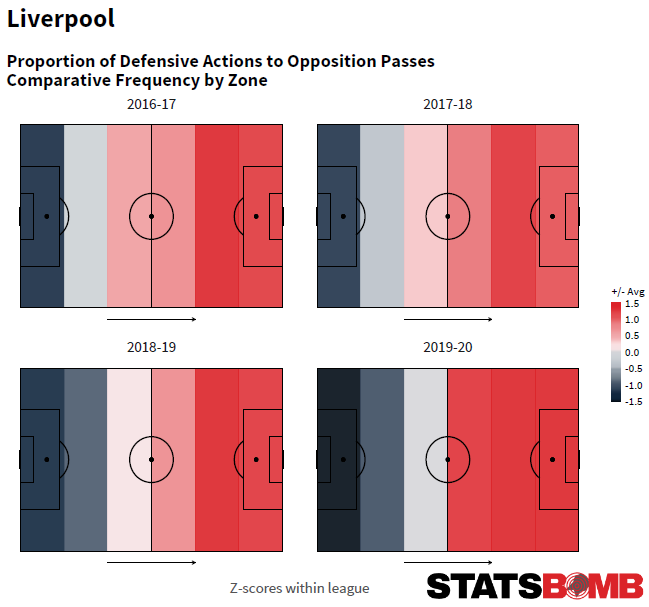 Once more off-season transfers don't seem to be the primary focus with the core first team all still within peak ages ranges and performing so well, but the team has moved finally to lock up a back-up left-back in Kostas Tsimikas. We reviewed him for our Pro Scouting project and liked him, for all that we didn't foresee a jump up to one of the best teams in the world. Our executive summary was as follows: Kostas Tsimikas is an all-round full back with a very impressive defensive output. A very aggressive presser, he somewhat foul prone. In attack he combines above average passing with decent crossing to offer a solid but unspectacular package. He can make the jump to a bigger league this summer. He also has throw-in ability, can execute combination play in build-up and is an effective ball carrier. We felt he could fit into a squad for a Europa League level team, but if we consider his age, and the stylistic package as a relatively well priced gamble to back up one of the world's best left backs, it's hard not to like.
Once more off-season transfers don't seem to be the primary focus with the core first team all still within peak ages ranges and performing so well, but the team has moved finally to lock up a back-up left-back in Kostas Tsimikas. We reviewed him for our Pro Scouting project and liked him, for all that we didn't foresee a jump up to one of the best teams in the world. Our executive summary was as follows: Kostas Tsimikas is an all-round full back with a very impressive defensive output. A very aggressive presser, he somewhat foul prone. In attack he combines above average passing with decent crossing to offer a solid but unspectacular package. He can make the jump to a bigger league this summer. He also has throw-in ability, can execute combination play in build-up and is an effective ball carrier. We felt he could fit into a squad for a Europa League level team, but if we consider his age, and the stylistic package as a relatively well priced gamble to back up one of the world's best left backs, it's hard not to like. 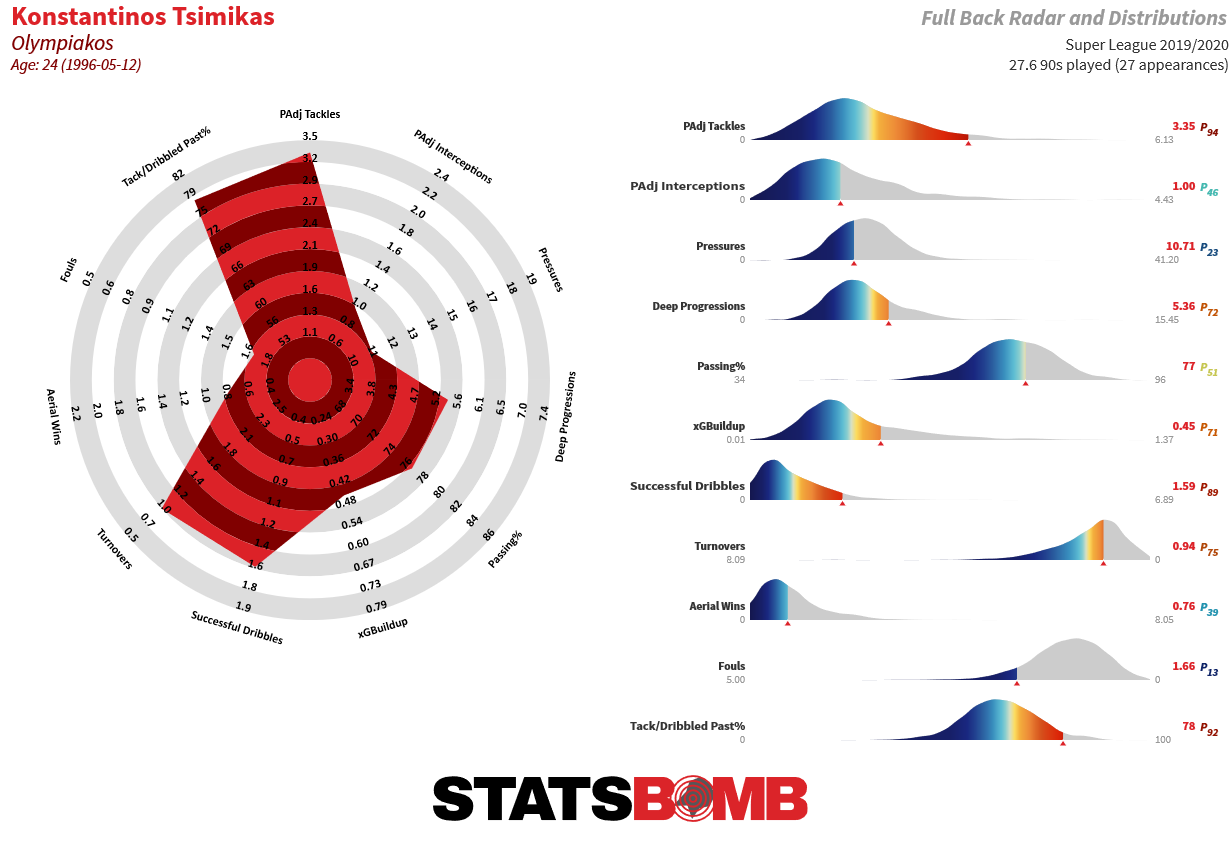 The other will he/won't he saga is the tempting switch to bring Thiago Alcântara in for Georginio Wijnaldum. The role of Wijnaldum has long been tricky to pin down, as it scarcely reveals itself via obvious numerical means, but his positioning, ball retention and discipline have clearly contributed plenty to the success of this team. He's also reliably fit, which is something that can't be said of Thiago. With a year on his contract and on the cusp of 30, Wijnaldum's time may have passed, and Barcelona are rumoured to be interested. Thiago is one of the world's best midfielders and appears to be looking for a
The other will he/won't he saga is the tempting switch to bring Thiago Alcântara in for Georginio Wijnaldum. The role of Wijnaldum has long been tricky to pin down, as it scarcely reveals itself via obvious numerical means, but his positioning, ball retention and discipline have clearly contributed plenty to the success of this team. He's also reliably fit, which is something that can't be said of Thiago. With a year on his contract and on the cusp of 30, Wijnaldum's time may have passed, and Barcelona are rumoured to be interested. Thiago is one of the world's best midfielders and appears to be looking for a 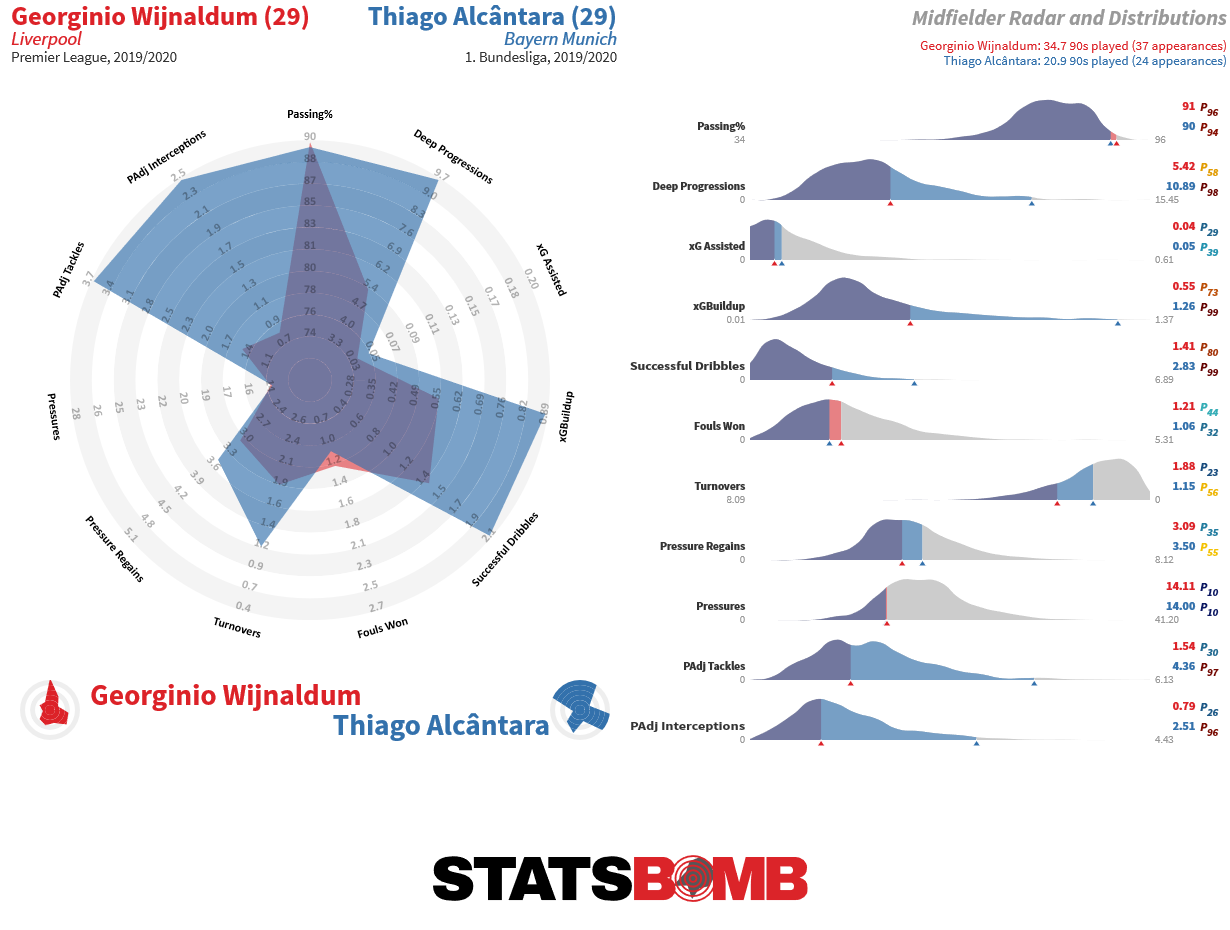 Projection Once he'd raised then to the standard of title winners, Klopp got three more decent seasons out of Borussia Dortmund, before the team suffered in 2014-15. Even with key members of this team aging together, it still seems likely that the absolute core of this team has another couple of years before remedial work is required. As we've seen with Barcelona, the problem is when much of your core talent is 32 to 33 not 28 to 30. As it's now 6 months since Liverpool have played a legitimate competitive and meaningful fixture, it has to be said: they will need to regroup, focus and start this season at the top of their game. This is Klopp's real challenge this season. As they have achieved their immediate goals, he needs to maintain the focus that got them there to compete at the same level again. It would not be surprising if this team dropped back ten points, and were still excellent in the main. That felt like the most likely outcome last season too and they rose to the challenge with some aplomb. Sporting Index's early lines peg them around here too, close enough to Manchester City (for whom excellent overall metrics will inevitably drive betting lines). But this Liverpool side the same team that got to two Champions League finals. The same team that landed back to back high-90 point totals. Predicting them outside the mix is not realistic. Every year that Klopp has been in charge it has appeared that they have learned a new technique to ensure that they can go longer and deeper into seasons (remember the bad Januarys?). Last season it felt like they had learned to manage their way out of games from advantageous positions, conserving energy for the inevitable hard grind of a tight schedule. This year the schedule will be tighter than ever, and this is a team that understands that consistency will take them furthest. If you turn up every gameweek and put up two expected goals to your opponent's one, you will win a lot of matches. Liverpool have been more consistent than their rivals for most of two seasons. They just have to be so again.
Projection Once he'd raised then to the standard of title winners, Klopp got three more decent seasons out of Borussia Dortmund, before the team suffered in 2014-15. Even with key members of this team aging together, it still seems likely that the absolute core of this team has another couple of years before remedial work is required. As we've seen with Barcelona, the problem is when much of your core talent is 32 to 33 not 28 to 30. As it's now 6 months since Liverpool have played a legitimate competitive and meaningful fixture, it has to be said: they will need to regroup, focus and start this season at the top of their game. This is Klopp's real challenge this season. As they have achieved their immediate goals, he needs to maintain the focus that got them there to compete at the same level again. It would not be surprising if this team dropped back ten points, and were still excellent in the main. That felt like the most likely outcome last season too and they rose to the challenge with some aplomb. Sporting Index's early lines peg them around here too, close enough to Manchester City (for whom excellent overall metrics will inevitably drive betting lines). But this Liverpool side the same team that got to two Champions League finals. The same team that landed back to back high-90 point totals. Predicting them outside the mix is not realistic. Every year that Klopp has been in charge it has appeared that they have learned a new technique to ensure that they can go longer and deeper into seasons (remember the bad Januarys?). Last season it felt like they had learned to manage their way out of games from advantageous positions, conserving energy for the inevitable hard grind of a tight schedule. This year the schedule will be tighter than ever, and this is a team that understands that consistency will take them furthest. If you turn up every gameweek and put up two expected goals to your opponent's one, you will win a lot of matches. Liverpool have been more consistent than their rivals for most of two seasons. They just have to be so again.